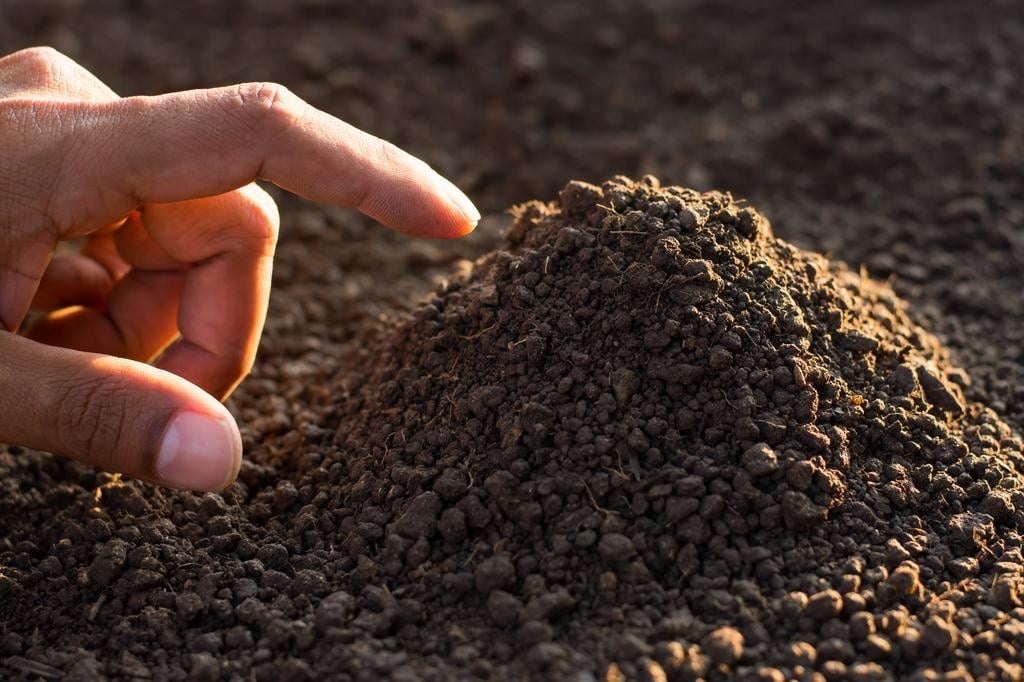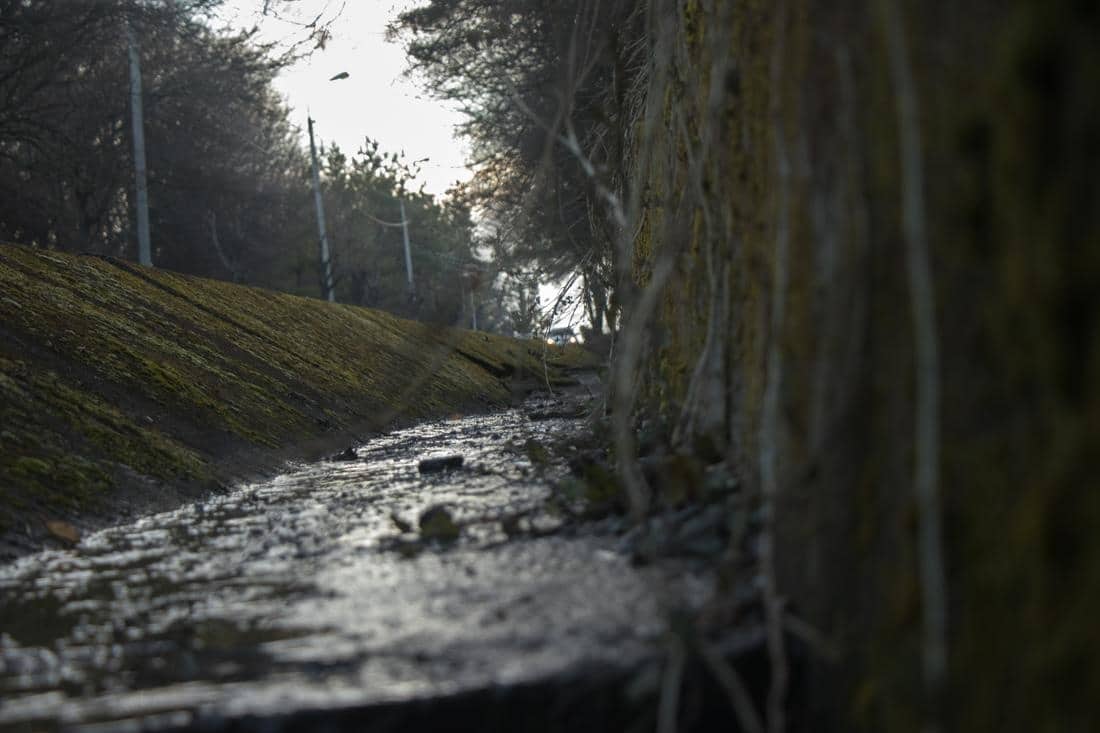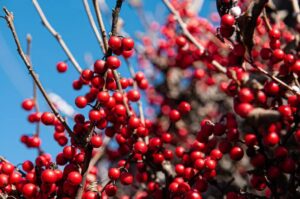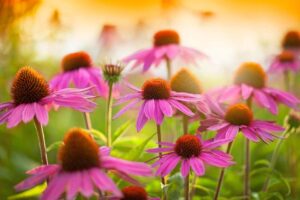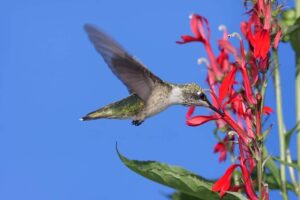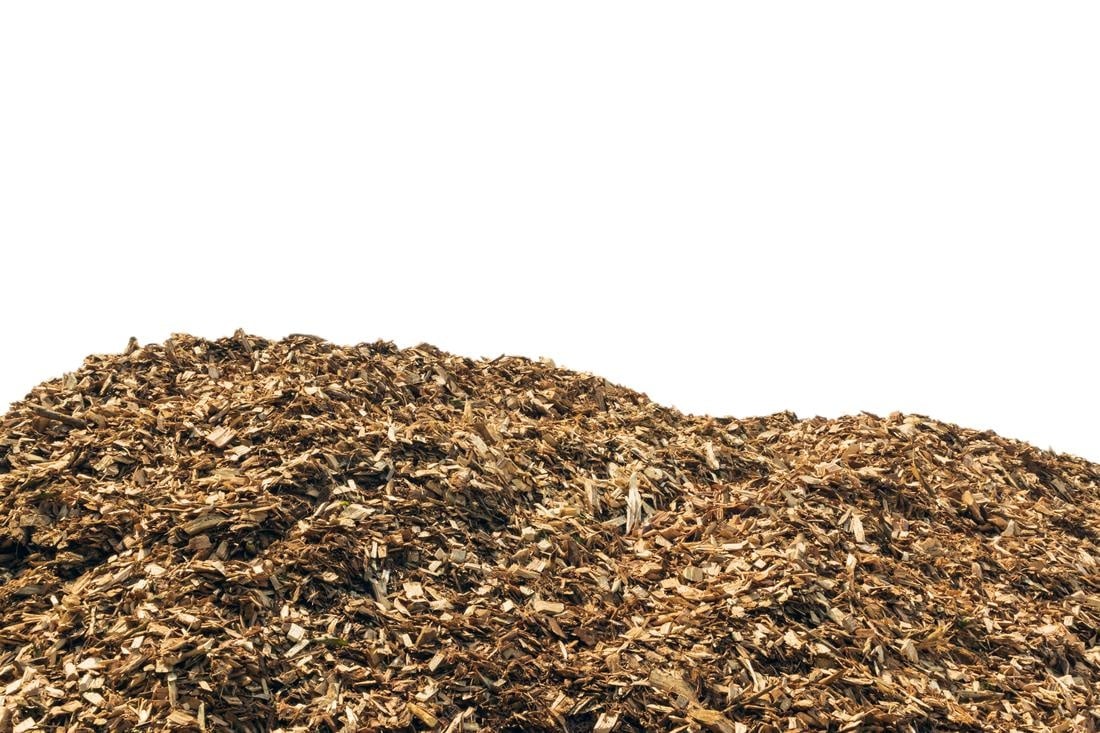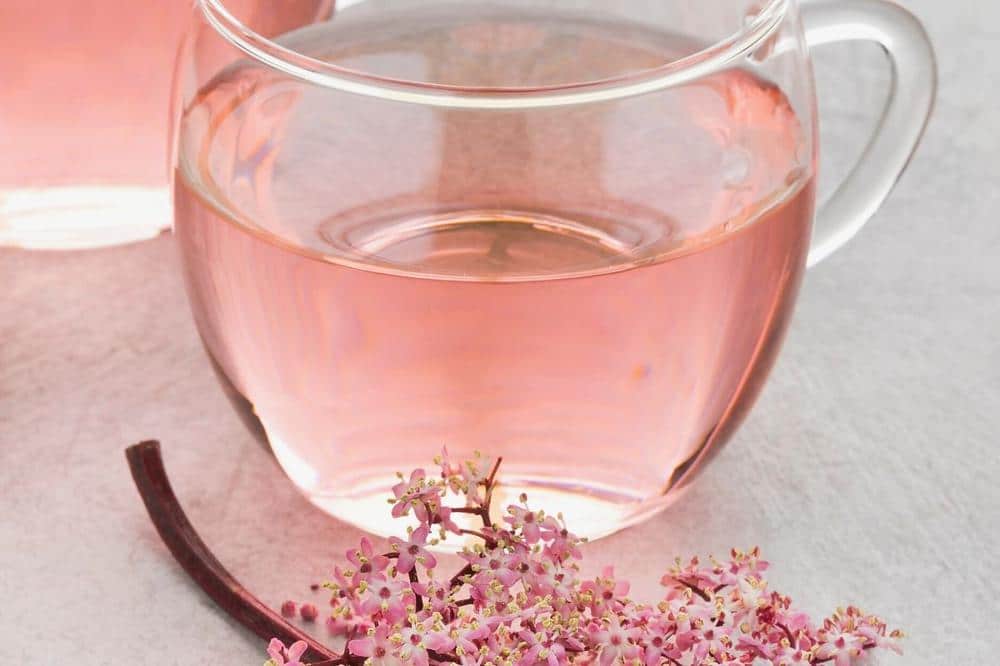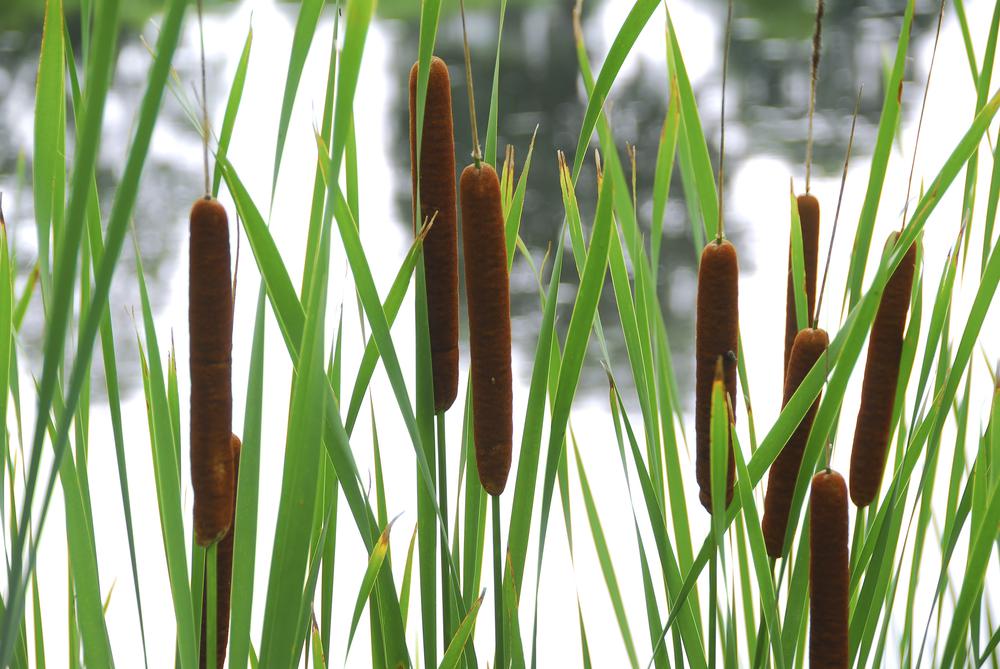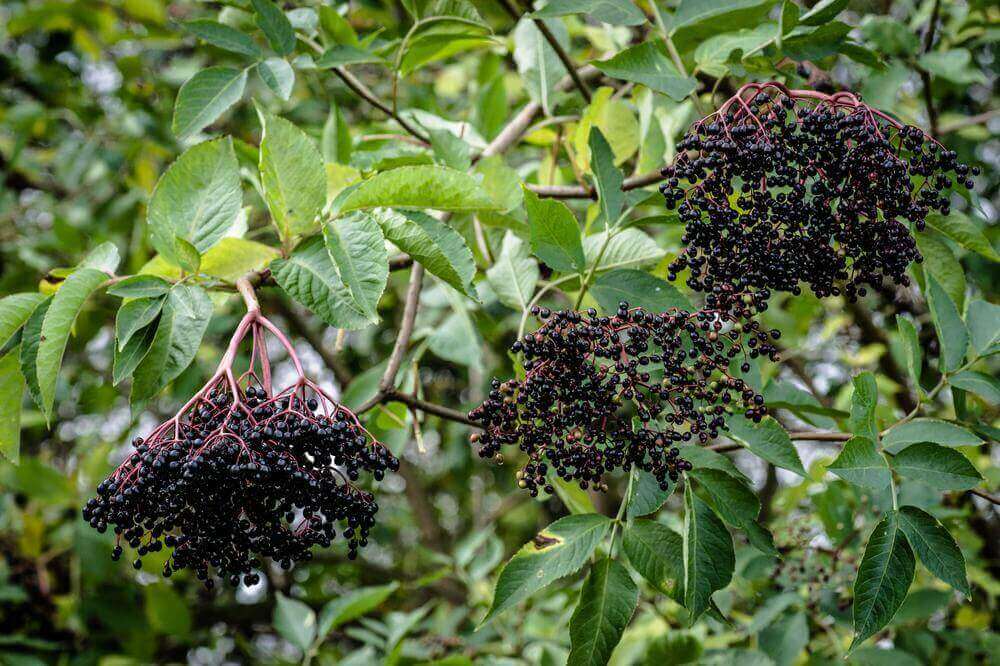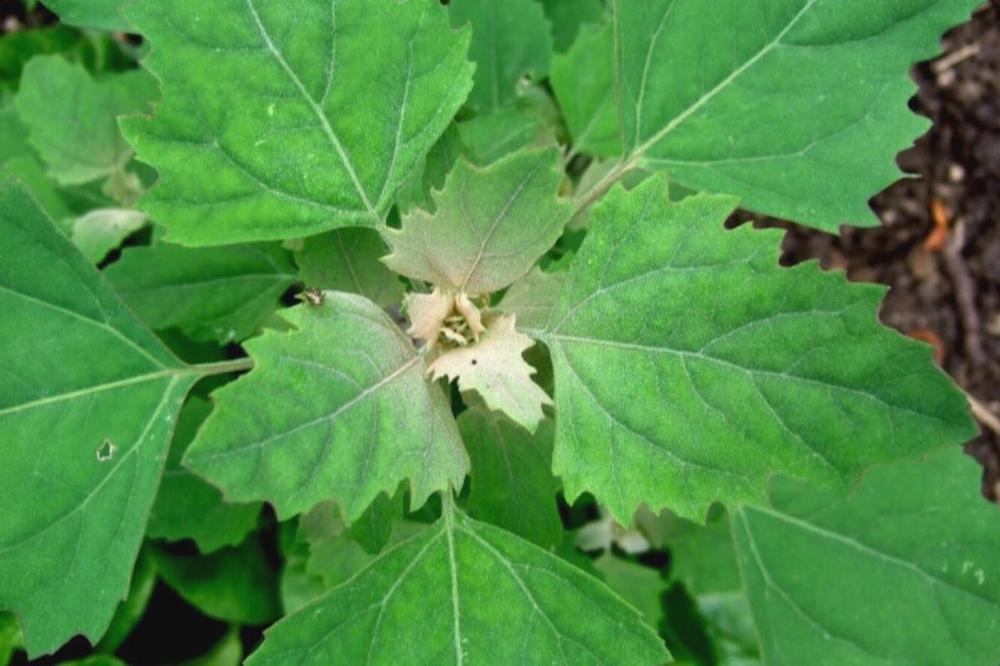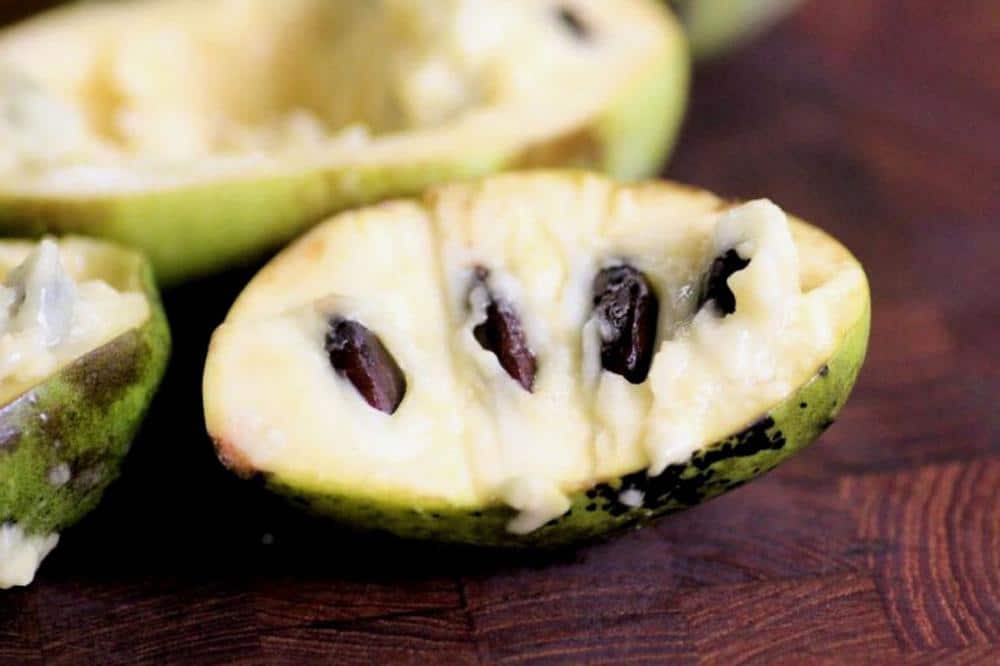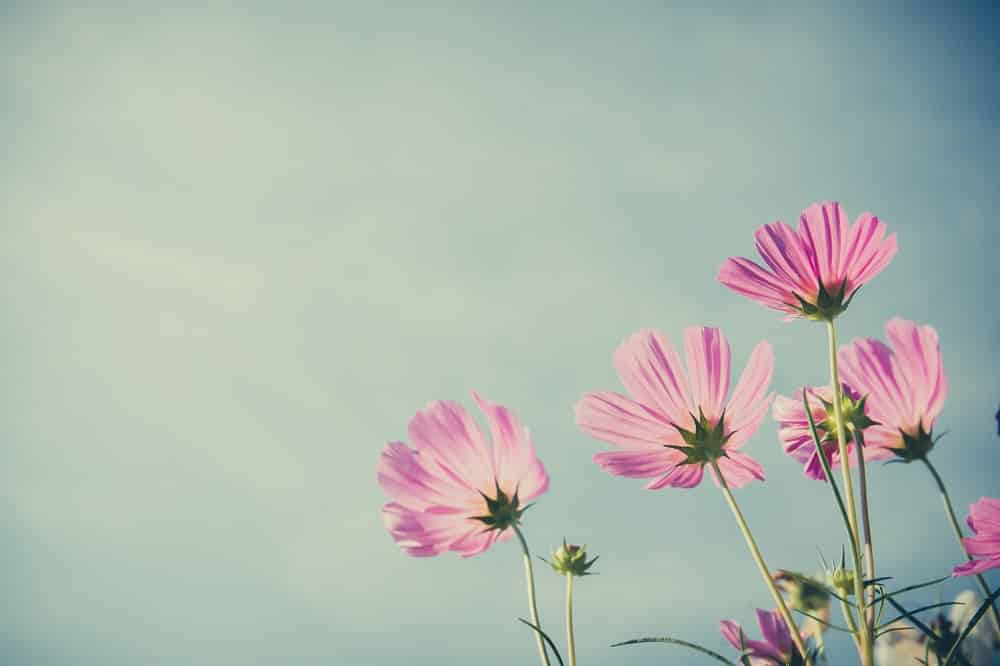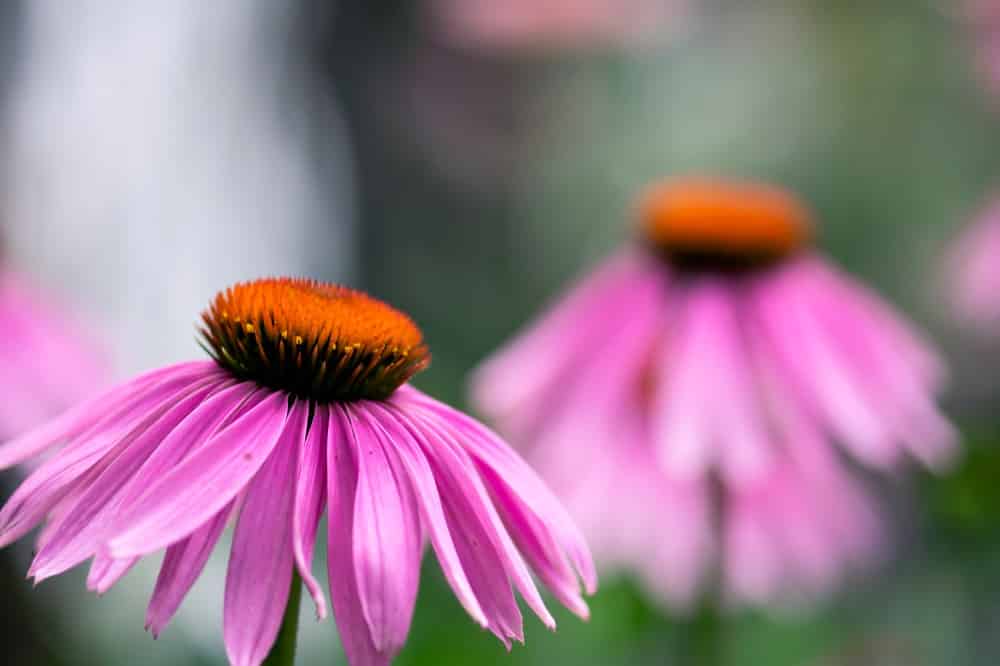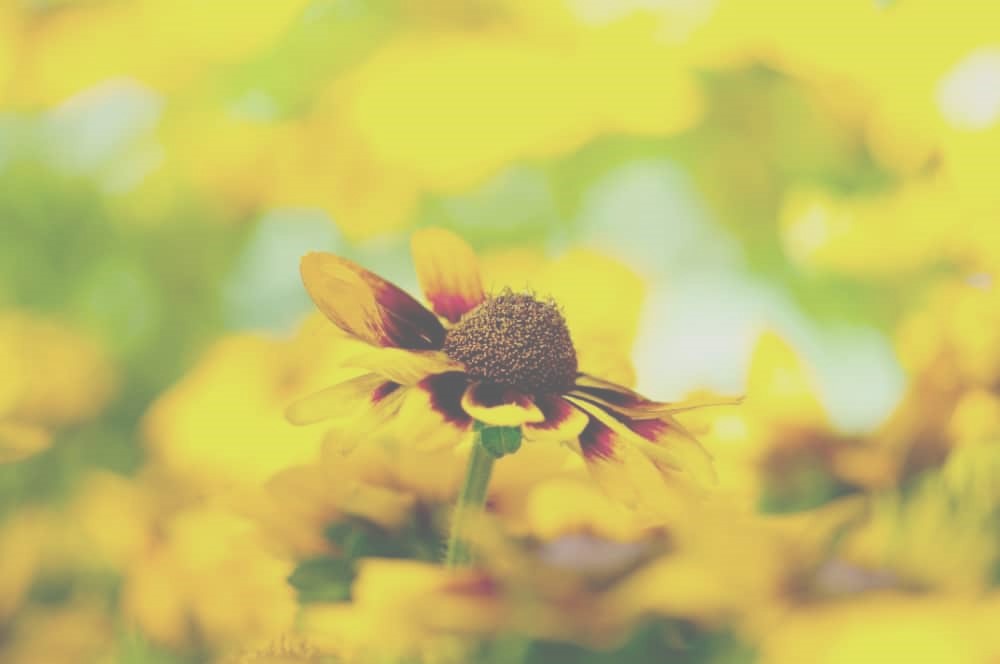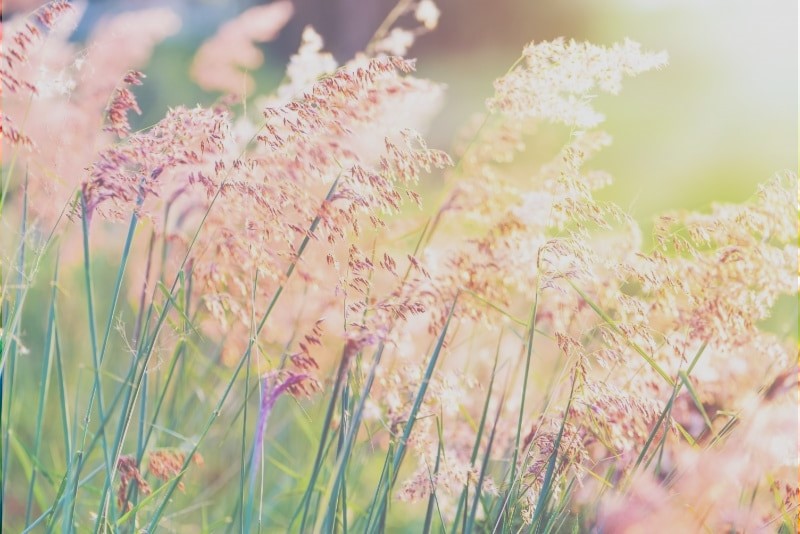Preparing the Soil for Native Plants
Soil Preparation and Native Plant Planting
The simple instructions below will help guarantee that the plants you grow will flourish for many years. See the complete directions below, and contact us to help prepare your soil for native plants in the Midwest!
Site Preparation
- Remove all loose debris from the area you plan on digging your holes for planting, such as leaves, pebbles, and branches.
- Dig a large hole to allow the roots of the plants to spread for healthy root growth to ensure you are not crowding them.
- Dig the holes where you are placing your plants at the proper depth. A rule of thumb is to plat them at the same level the plant was at in the starter pot.
- Remove any existing roots from other plants from the hole.
- Pile the soil next to your planting hole, be sure the area you place the soil is clear of debris. Remove any plant roots or grass clumps from the soil used to fill the hole.
- If the walls of the hole seem slick, roughen them up.
Plant Preparation
Until planting, keep all plants moist and cool. Do not keep inside!
If you purchase in pots or without soil surrounding the roots (bare-root plants). See instructions for each kind below.
Plants in Pots: Make sure the dirt in the starter pot is damp before tipping it to the side and gently pressing on the pot to dislodge the plant. Next, remove the plant gently by grasping the plant at the base of the stem.
- The roots of the majority of plants will be visible. Pull out loose roots and trim or straighten the roots that are surrounding the root ball (roots that are circling the root ball will grow in a circular motion which can cause them to have poor growth or potentially die).
- Place the plant in the hole and position the roots to point outward.
- Be sure to place the plant you've positioned at the proper depth. Make sure that you are not planting too deep.
- Store the roots in damp soil or compost until you are ready to plant them and keep them moist. You may also soak plants in water for 1 to 2 hours, but never over six hours.
- Before you plant, trim back any significantly injured, bent, kinked or jagged roots to sound wood.
- When planting, make a tiny mound of earth in the hole's bottom.
- Arrange the plant's roots around the small mound, ensuring the roots are pointing away from the plant.
- Position the plant so that earth covers the roots but not the stem above the roots.
- Use the native dirt from the hole to backfill the hole, or from a nearby hole if you need more soil.
- Filling the hole with store-bought dirt may lead the roots to grow just to the hole's border.
- Ensure that the dirt you are placing in the hole is free of debris such as rocks, twigs, grass, and leaves.
- You should not need to add compost or fertilizer to hole where you are planting.
- Push dirt into the hole surrounding the roots without upsetting the root arrangement.
- Firmly press the dirt down to eliminate air pockets.
- Build a dirt ring around the border of the planting hole to contain water and ensure that water is draining away from the trunk area.
- Finally, pull on the plant gently by holding on to the base of the stems to allow dirt to allow all dirt to engulf the roots.
Bringing It All Together
As soon as your plant is in the ground, and the hole is filled, immediately water the plant to help settle the soil and aid in the removal of air pockets. Fill any holes that form with extra dirt.
Mulch or compost should be applied on top of the soil in a circle, at least as broad as the roots, but without touching the stem.
Using Manure for Native Plants
Manure is typically required for clay soils to disintegrate. You should also ensure that soil levels are elevated to aid with water drainage. Sandy soils benefit from being adequately mulched with organic matter.
Building garden beds or installing subsurface drainage might benefit your native plants.
Use Caution with Soil Improvers
Most natural plants thrive in acidic soils. Missouri soils are acidic; thus, the pH levels are unlikely to need to be altered.
However, soil improvers like dolomite or lime are renowned for raising the pH of the soil and should be avoided. If the levels are too high, your native plants cannot absorb soil nutrients.
If you have clay soil and wish to boost its nutrients, use Gypsum instead because it does not affect the PH.
What is the best compost for native plants in Missouri?
First, to be fruitful, the soil must be nutritious. As a result, appropriate soil resource management is critical to maintaining and sustaining Missouri's agricultural resources.
Producers have depended significantly on soil testing to offer current information on the state of their soil to manage fertilizer and soil amendment inputs.
The MU Soil and Plant Testing Laboratory analyzes hundreds of soil samples each year to offer agricultural community members excellent information on soils throughout Missouri. In addition, the lab constantly analyzes university faculty research to give the most current and accurate information, as well as fertilizer recommendations.
The laboratory can offer information on soil pH, textural analysis. organic matter, ammonium acetate, neutralizable acidity, calcium, and magnesium, extractable potassium (K), extractable sulfate, Bray 1-Phosphorus (P), nitrate, micronutrients, boron, ammonium, and electrical conductivity after a sample is submitted.
This data, however, is unique to the location where the specimen was obtained and may not reflect standard patterns in other neighboring regions or places.
To provide basic geographic information, the MU lab's soil data from 2007 to 2017 were collated and published by counties in this overview. A total of 315,504 specimens were used.
Soil pH values in Missouri are generally categorized as medium (5.4-6.0) or high (6.1), except for south-central counties, including the Ozark Mountain range.
In general, phosphorus levels are modest (22 lb./ac). However, several counties in west-central Missouri's Missouri River valley, the southwest prairie region, and the heavily farmed southeast delta region have medium (23-45 lb./ac) to incredibly high (70 lb./ac) soil P levels.
The majority of the state has medium potassium levels (111-220 lb./ac). However, residual soil K levels were high (221-330 lb./ac) and extremely high (331 lb./ac) in the state's heavily cropped northwest and southeast areas.
In Conclusion…
Native plants are a vital part of our ecosystem and play an essential role in the health of our
environment. By adequately preparing your soil and planting them in the right place, you can help these plants thrive and grow into healthy mature specimens that provide beauty and sustenance to our community.
If you're unsure how to get started or if your soil needs preparation for native plants, give us a call! We would be happy to help assess your property and give you advice on the best way to plant natives so they can flourish.
Using Native Plants for a Rain Garden
Native Plants to Establish Rain Gardens
A storm water garden is a small planted depression that collects and stores rainwater runoff from impervious surfaces like roads, rooftops, and compacted lawns. A rain garden slows water flow, allowing it to percolate into the soil rather than entering storm drains. Storm water gardens are often planted with native plants and grasses with root systems that absorb rainfall and allow the rain to percolate into the ground.
Why Should You Create a Rain Garden?
According to government research, storm water runoff from impervious surfaces is responsible for most of the pollutants in our rivers, lakes, and streams. A rain garden functions as both a sponge and a filter, capturing rainfall and the contaminants it transports.
Impervious surfaces have taken the role of soils that would typically absorb precipitation, allowing them to seep in and replenish our groundwater. As a result, the amount of storm water (volume) in streams after a rain increases, as does the pace at which it moves (velocity). As a result, storm water pollution increases water pollution, erodes stream banks, expands creek beds, and causes property damage, sedimentation, and floods if not treated.
A rain garden improves water quality, beautifies the land, and provides a home for animals such as birds and butterflies.
Large-scale adoption and usage of rain gardens in a community can save tax dollars by eliminating the need to construct more extensive storm water drainage infrastructure and initiatives to stabilize stream banks.
 Plant Selection for Your Rain Garden
Plant Selection for Your Rain Garden
Modern storm water management systems rely on plants to contain soil, filter pollutants, absorb nutrients, intercept and transpire water, and promote healthy and diverse soil biology. Engineers are only now realizing the value that landscapers can provide in helping green infrastructure survive and prosper. A vital initial stage in the effectiveness of biofilters, bioswales, rain gardens, and other vegetated storm water management systems is the selection of suitable plants. But remember that plant choice only goes so far; for long-term success, a maintenance plan must be established, which is not covered here.
Examine the Location and Situation
Plant selection, like any other landscaping project, should begin with a thorough examination of the site and environment. Not all biofilters, rain gardens, or bioswales are the same, and they may necessitate plants that can withstand various harsh environments. If the underlying soils are clay or drainage is constrained by impermeable layers underneath, bioswales made from native soils may store water for days. Newer storm water management biofiltration zones may infiltrate up to 20-30" of water per hour through a highly well-drained matrix of sand, rock, loam, or compost. In most circumstances, root zone saturation is transitory, and plants are more likely to be challenged by drought than by continuous wet feet.
Organic waste products and volatile organic compounds (from oil and gas) may be present in runoff from roads and parking lots and inorganic pollutants such as road salt, silt, and litter. Nutrient levels may increase with the initial flush but plummet with regular storm-water cleansing. What other difficulties does the location provide? Are there invasive plants nearby? Buildings creating reflected heat or shadows? What about wind exposure? What about foot traffic? The plants had better brace themselves for virtually anything!
Furthermore, towns or other agencies in charge of upkeep may create some difficulties. Mowing may come naturally to them, but removing silt, weeding, pruning, and other plant management activities are unlikely to be completed unless a plan (and some training) is in place or a contract with a landscape maintenance service is in place. What about during the winter? Does the rain garden turn into a snowdrift? If we don't want damaged trunks and branches, we should avoid planting trees and bushes.
Plantings in Layers
Deciduous trees may transpire a lot of water in the summer, but they should only be included if there is enough soil volume (width and depth) and area for the canopy to grow. Suitable species are most likely to thrive in the compacted, weak soils typical of many metropolitan environments.
Planting in layers is another method for increasing leaf density and transpiration.
Rhodora (Rhododendron canadense), Red or Black Chokeberry (Aronia arbutifolia or A. melanocarpa), Red-twigged or Silky Dogwood (Cornus amomum or C. sericea), Buttonbush (Cephalanthus occidentalis), Winterberry (Ilex verticillata), Rhodora (Rhod (Hydrangea quercifolia), Witch Hazel (Hamamelis virginiana), Cranberry (Vaccinium macrocarpon) and low-bush Blueberry (Vaccinium angustifolium), as well as several ferns and sedges, are excellent acid-soil ground coverings.
Suckering plants like Summersweet Clethra (Clethra Alnifolia) and Fragrant Sumac (Rhus Aromatica) can quickly fill in dry patches and keep weeds at bay. However, the plants described best suit the rain garden's wetter bottom zone. In contrast, other plants that can endure occasional, but not consistent, wetness can be utilized on the sides and higher margins of buffers, bioswales, and rain gardens. Examples include Northern Bayberry (Myrica Pensylvanica), Sweet Fern (Comptonia Peregrina), and various Viburnum species.
Plant for Particular Conditions
Choose plant groupings that require the same pH and soil moisture. Do you have a partial-shade rain garden with damp, acidic soils? For year-round appeal, mix Pink Shell Azalea (Rhododendron Vaseyi) or Swamp Azalea (Rhododendron Viscosum) with high-bush or low-bush Blueberry (Vaccinium Corymbosum or V. Angustifolium), ferns and/or sedges, and Maybe Winterberry (Ilex Verticillata).
Small domestic rain gardens, as opposed to designed systems, appear more like gardens and can be thickly planted with your preferred plants. After a storm, these gardens should not keep water for longer than 24-48 hours. There are far too many Herbaceous Perennials to list — choose the proper position (low or high on the bank?) for each of your favorites. Blue Flag Iris (Iris versicolor) is a plant that appears to be well adapted to the rain garden's lowest section — we've seen it thrive when many other species have failed. Aside from its beautiful red color, the nice thing about the Cardinal Flower (Lobelia cardinalis) is that it reseeds and will travel over time to settle in its favorite position. Brown-eye or Black-eyed Susans (Rudbeckia Hirta or R. Triloba) or Purple Coneflower (Echinacea Purpurea) are versatile and famous for their lengthy bloom periods; however, they prefer the higher zones rather than damp soil.
Do you need a colorful meadow planting for a low-maintenance bioswale? Choose native perennials that will provide you with year-round color while providing habitat for numerous birds and pollinators. In addition, meadow plants' tough, deep root systems allow them to withstand drought and floods while enriching the soil. It could take two to three years for a newly planted meadow to mature into a lively and colorful plant community. Still, once there, it will provide season-long beauty and animal habitat with minimum upkeep. However, remember that many meadow plants are tall and floppy late in the season and may not look right in the heart of a perfectly manicured landscape. You may get a more refined meadow effect by picking compact perennial varieties and spacing them in a garden, but they will require more upkeep over time.
Having the Right Mix of Native Plants
Golden Alexanders (Zizia aurea), Cardinal Flower (Lobelia cardinalis), New England Aster (Aster Novae-Angliae), Swamp Milkweed (Asclepias Incarnata), Tall Ironweed (Veronia Altissima), and Joe Pye Weed are all suitable for moist to wet soils (Eupatorium Maculatum). In addition, from May to September, Bergamot (Monarda Fistulosa), Asters (Aster spp. ), Butterfly Weed (Asclepias Tuberosa), Coreopsis (Coreopsis lanceolata), Lavender Hyssop (Agastache Foeniculum), Brown-eyed or Black-eyed Susan (Rudbeckia spp.), and Ox-eye Sunflower (Heliopsis Heliant).
Don't forget to include some decorative grasses in the mix; indigenous such as Little Bluestem (Schizachyrium Scoparium), Virginia Wild Rye (Elymus Virginicus), Switchgrass (Panicum Virgatum), and Indian grass (Sorghastrum Nutans) have done well for us in damp to dry soils. Maiden grass (Miscanthus Sinensis) is a vast, popular non-native grass that can resist the harsh circumstances of designed rain gardens, including flooding. However, Big Bluestem (Andropogon Gerardii) might be used as an alternative.
Creating the Perfect Rain Garden
If you are interested in installing a rain garden on your property, please contact Down to Earth Services. We would be happy to help you design and install a rain garden that will collect and store stormwater runoff from your impervious surfaces. Our team of experts can help you choose the right plants for your climate and soil type, and we will make sure your rain garden is installed correctly so it can function properly.
Natural Mulch Vs Dyed Mulches
Natural Mulch compared to Dyed Mulches for Your Garden and Landscapes
Dyed Mulch Safety In Your Garden and Landscaping
Although the landscaping firm where I work has a wide variety of mulches and rock to fill landscape beds, I always recommend utilizing natural mulches. Although, rock requires less regular topping and replacement, it does not help the soil or plants.
In reality, rock heats up and dries up the soil. Colored mulches may be highly aesthetically beautiful and draw attention to landscaping plants and beds; however, not all dyed mulches are safe or beneficial for plants. Continue further to understand more about plain mulch and colored mulch.
Is Colored Mulch Harmful?
Customers occasionally ask me, "Can you tell me if colored mulch toxic?" Several colored mulches come colored with safe dyes, such as iron oxide-based red dyes or carbon-based dark brown and black dyes. However, specific low-cost colors may include dangerous or poisonous compounds.
In general, if the price of dyed mulch appears too good to be true, it is, and you should spend the extra money on safer and better quality mulch. However, this is uncommon, and it is generally the wood rather than the dye that causes worry about the safeness of mulches.
While most natural mulches are derived directly from trees, such as double or triple shredded mulch, cedar mulch, or pine bark, many-colored mulches arrive manufactured from recycled wood, such as old pallets, decks, crates, and so on. These recycled treated wood pieces may include chromates, copper arsenate, or both (CCA).
Although using CCA to treat wood was prohibited in 2003, this wood is frequently obtained from demolitions or other sources and repurposed into colored mulches. As a result, helpful soil microorganisms, beneficial insects, earthworms, and young plants can potentially die from CCA-treated wood. It can also injure individuals who spread the mulch and animals who dig in it.
Dyed Mulch Safety in the Landscaping
Aside from the possible hazards of colored mulch to dogs, humans, or young plants, dyed mulches are harmful to the soil. They will help maintain soil moisture and protect plants over the winter, but they will not enrich the soil or contribute helpful bacteria and nitrogen as natural mulch.
Dyed mulches degrade significantly more slowly than natural mulches. Nitrogen is a requirement for the breakdown of wood. Colored mulch in gardens might deplete the nitrogen required by plants.
Pine needles, natural triple or double-processed mulch, pine bark, or cedar mulch are better alternatives to colored mulches. Because they are not colored, these mulches will not fade as rapidly as colored mulches and will not need replenishing as frequently.
If you want to employ colored mulches, merely investigate the origins of the mulch and nourish plants with a nitrogen-rich fertilizer.
Which Natural Mulch Is the Best?
There are several natural mulches available, with pine straw, hardwood bark mulch, and old hay being the most common. Which option is choice for your garden?
Mulching with pine straw
Weeds can be controlled with pine straws. It has a habit of forming a thicker mat and bummer to the plant that attempts to grow through it! However, pine straw may not be appropriate for everyone's garden. It can render your soil acidic over time, making it impossible to grow anything. On the other hand, some plants thrive on acidic soil. If your flower garden consists of these acid-loving plants, pine straw is not only OK but ideal.
Making use of hardwood bark mulch
Most gardens develop plants that prefer neutral to sweet soil (alkaline). The optimum mulch for such plants is hardwood bark mulch. It decomposes into a sweet-smelling , rich black earth while remaining immaculate. Furthermore, hardwood bark mulch is the finest for soil amendment. The downside is that it's pricey, especially if you buy it from a garden center (and the bags aren't huge).
Natural mulching with hay
On the other side, old hay is dirt cheap. Farmers cannot feed their livestock if the hay becomes damp and rotten; it might kill them. That ruined hay, on the other hand, is just what your garden requires. Your garden will probably prefer it over fresh, unspoiled material, and your vegetable garden will probably prefer it to hardwood bark mulch. You can sometimes obtain an entire bale of ruined hay for a few dollars.
Of course, the issue with old hay is that it comes from grass (or grains). Grass in a garden is a weed, and hay is full of its seeds and any other weeds that may have been combined. So what should a gardener do?
In her ostensibly renowned "No Work Garden Book," Ruth Stout offers an easy solution: add more hay. Hay stacked around plants to a depth of roughly a foot (31 cm.) is too dense for weeds to pass through, even its weeds. As a result, it's an excellent choice for vegetable beds (and it does work).
However, it has the unintended consequence of making the flower beds seem messy, and an untidy flower bed might as well be full of weeds.
So, what is the most incredible natural mulch option?
What is the most acceptable gardening solution? In general, use a bare bark mulch for the flower gardens. It isn't as lovely as hardwood bark mulch, but it's also less costly. Spread it 4 to 6 inches (10-15 cm) thick around your flowers, covering the entire bed.
Find a farmer and buy as much of his old, ruined hay as you can afford for the rear garden and vegetable garden. Spread it out 8 to 10 inches (20-25 cm.) at first, then expand it to a foot (31 cm.) if some daring weeds poke their heads out (but be careful to pick the weeds out; otherwise, they'll keep growing like the proverbial beanstalk).
Gardens should ideally be mulched twice a year, once in the spring and once in the fall. It's not an exact science: mulch your garden when it starts to feel warm; mulch it when it starts to feel chilly.
Mulch provides several advantages for your garden. So what exactly are you waiting for? Begin mulching!
A Foragers Feast of Wild Edible Treats
Native plants form the cornerstone of nature's web of life, feeding multitudes of insects, which in turn feed songbirds and other prized animals. Additionally, many wild edibles also serve as food for people. A few of the delicacies you can make from Missouri’s wild flora are jams, soups, bread, and more. For example, the fruit from persimmon trees and pawpaw's may be used to produce a variety of delicacies, as can nuts from black walnut and hickory trees.
The resource information contained in this article is informational. Additionally, it is essential to remember that there is always a chance you may have an allergic reaction when eating wild natives, just as with any other food item. If you have any concerns about handling or consuming any plant materials, always seek the counsel of a health expert.
Natures Wild Edibles
Many different types of wild edibles are nutritious and delicious. And while you can forage in the woods for these delicacies, you will ideally grow your edible natives, which help to support pollinating insects, and in turn, helps pollinate your vegetable and fruit gardens. This article will cover just a few of the fascinating wild edibles you can find in Missouri.
Cattails
You can find Cattails, Typha latifolia, in ditches, wetlands, marshes, and ponds. These fuzzy beauties, also known as bullrush, are a wild food source.
During the spring, the young cattail shoots are a prized wild edible. If you harvest them in the spring, you should remove the outer leaves, and the white core that remains can be eaten raw. Additionally, you can boil them, bake them or slice them up to add to a stir fry. Another common technique to prepare the young, fragile shoots is to pickle them.
Vibrant yellow pollen will form on the heads of the cattails as they mature, which you can gather by shaking the pollen into a sealable container or plastic bag. The pollen is an excellent source of protein and a fantastic substitute for flour in baking or as a thickening agent for soups and stews. In addition, you can harvest the female heads when they turn into cottony seeds during the fall and use them to insulate quilts and pillows.
Cattail roots are typically used as a flour replacement or thickening agent. Let the cleaned cattail roots dry naturally, or place them in the oven overnight at 200-degrees. Once dried, pound the dried roots with a kitchen mallet to obtain the flour.
Dandelions as Wild Edibles
Most people consider dandelions (Taraxacum officinale) to be an unsightly weed, with the goal of exterminating them from their yard. Dandelions have distinct leaves with toothy notches and brightly colored yellow flowers. These tiny edibles bloom from April through late October.
Dandelions are unique wild edibles in that you can eat all the parts. Whether consumed in their natural raw state or cooked, they have a bitter taste that many people dislike. However, if you dry the roots and roast them, you can crush or grind them and then steep them in water to make a coffee-like beverage.
The optimal time to collect dandelion leaves and stems is when they are young. The blossoms of dandelions are an excellent addition to any salad to add a pop of color. Additional options are to sauté them with pine nuts, bacon, or lemon, like any other greens. You can also fry the gold heads of dandelions like zucchini blossoms.
Wild Elderberries
Elderberry bushes, Sambucus canadensis, are wild edibles that are prevalent across the state and are often found growing beside roadsides or streams, in open forests, or concealed in fencerows or thickets. They produce colonies from root shoots and can grow to be 8 feet tall or more.
Elderberry bushes are recognizable by their blossoms or berries. Each flower has five flattened, white petals and is radially symmetrical, with the blooms creating an umbrella-shaped cluster. The fruit ripens to a dark purple in hanging clusters in late summer. Elderberries contain a lot of vitamin C; however, you should not eat them fresh. Until the alkaloids in the berries are reduced by cooking, they might produce nausea. These berries are great in pies, muffins, jellies, or elderberry syrup.
You can also eat elderberry blossom clusters, but they need to be fried first. Like many other wild foods, the blossoms can be dried and steeped in hot water to form a tea. In addition, you can batter and fry the flower clusters to make fritters. Be sure to avoid the bark, leaves, and roots, as they contain a bitter alkaloid and a glucoside, which can create cyanic acid.
Lamb's Quarters
Another wild edible is Lamb's Quarters, Chenopodium album. This plant, also known as pigweed, is resilient and can be found almost anywhere in Missouri. It is commonly utilized as a fast-growing grain or as animal feed worldwide. Lambs quarters, a cousin of spinach, are commonly used for their stems and leaves, which you can substitute for other leafy greens in cooked or stewed meals. Raw, it works well as a substitute for both spinach and lettuce. Be cautious of eating too many raw Lamb’s Quarters leaves as they can contain significant quantities of oxalic acid.
Wild Pawpaw's
Pawpaw's, Asimina triloba, is the fruit of the Asimina triloba shrubs or trees and are often called Missouri’s banana. These wild edibles are found across the state near river bottoms and streams. Because they are spread by root suckers, you'll frequently discover several when you locate one.
The fruit of the pawpaw ranges in size from 2 to 5 inches. Their nickname comes from their original green hue, short, sturdy banana form, and custard-like inside. The surface of the fruit becomes brown as they mature between September and October. Pawpaw leaves typically stand out amid other plants because of their large oblong shape and size, often measuring between 6 - 12 inches in length. As autumn progresses, the brilliant green hue of the leaves fades to yellow.
After harvesting pawpaw fruits, cut them open to reveal the pulp and seeds. The pulp of the pawpaw can be consumed raw or may be used as a substitute for bananas in various dishes.
Wild Edible Persimmons
Persimmons, Diospyros virginiana, are a well-known wild edible in Missouri. They have a lovely sweet flavor when ripe. Persimmon trees are often found in hardwood forests, prairies, and fields. Because of the sucker roots, locating one tree typically leads to finding a whole grove of persimmon trees. Their leaves are oval and are dark green at the top and fade to a pale green on the bottom. Probably the most distinguishing feature of this tree is the texture of the bark. The ridges of the bark resemble alligator skin.
Persimmon leaves may be harvested and steeped like tea. The result is very similar to sassafras tea. Persimmon seeds may be extracted, roasted, ground, and made into a caffeine-free coffee. The persimmon fruit can be compared to a plum when it comes to shape. However, they are smaller and remain green through the summer months. They turn brilliant orange in the fall as the temperatures begin to drop. Persimmons are bitter; however, the bitterness begins to fade once the persimmon wrinkles and becomes squishy, which is the perfect time to harvest.
You can eat persimmons fresh or preserve them for later use. First, smash the fruit to remove the skin and seeds. You will end up with pulp for baking. To make persimmon bread, use your favorite banana bread recipe and substitute persimmons.
Final Thoughts
Gathering wild edibles is a fun and relaxing way to enjoy Missouri's incredible outdoors. Because they have a shorter storage life, it is best only to gather what you can eat in a day or two. Leave the rest for your next outdoor foraging adventure. Always remember when gathering wild food, always be cautious. Many plants are similar in the way they look. Some of these look-alike plants can be toxic. So, if you're unsure of the identity of a wild edible, don't consume it. It's always better to be safe than sorry. We hope you found this article enjoyable and the team at Down to Earth Services wishes you well on your foraging journeys!
A Planning Guide for Stormwater Design
“Spring is nature’s way of saying let’s party!”
Spring is also the time to start thinking about your landscaping and water runoff. However, before you are faced with the challenges of heavy water run-off at the beginning of the growing season, check out our stormwater design guide below.
Your landscaping has to deal with melting snow and seasonal rain showers every year. This will take its toll on your mulch, rocks, and soil. Additionally, large amounts of water can create pools in your yard, leaving a muddy mess. Stormwater runoff also has the potential to harm ecosystems as it generally contains fertilizer and various pesticides. There are also a number of areas in which legislation has limited impermeable surfaces on the property. Anything that goes over this limit can result in a fine.
There is no need for seasonal storms to ruin your gorgeous landscaping, as it can be naturally filtered to avoid any harmful runoff. There are several ways in which you can handle stormwater while remaining environmentally friendly and keeping a lush landscape.
Stormwater Design Guide
The Creation Of Swales and Berms
One of the first considerations you must make is the lay of the land. Decide upon how the water is already flowing on the property and determine if that location will need to be diverted. If water is flowing directly toward a building, you will need to direct it away from the foundation.
Creating a berm is one of the best solutions for this type of problem. Berms are areas of the land that have been slightly raised to help change the general direction of the water. These will usually be accompanied by a swale, which is a piece of land that will act as a general vegetative gutter. When you combine the berm and swale, water can be absorbed into the yard or flowed into a catchment designed for evaporation while also providing additional water for plants.
It is possible to build a simple berm with a little bit of time and a good plan. You can create a planned berm with a garden hose, dig out the outline, fill it with clay, absorbent gravel, soil, and topsoil. If you are unsure about the process, you may just want to contact the professionals at Down to Earth Services.
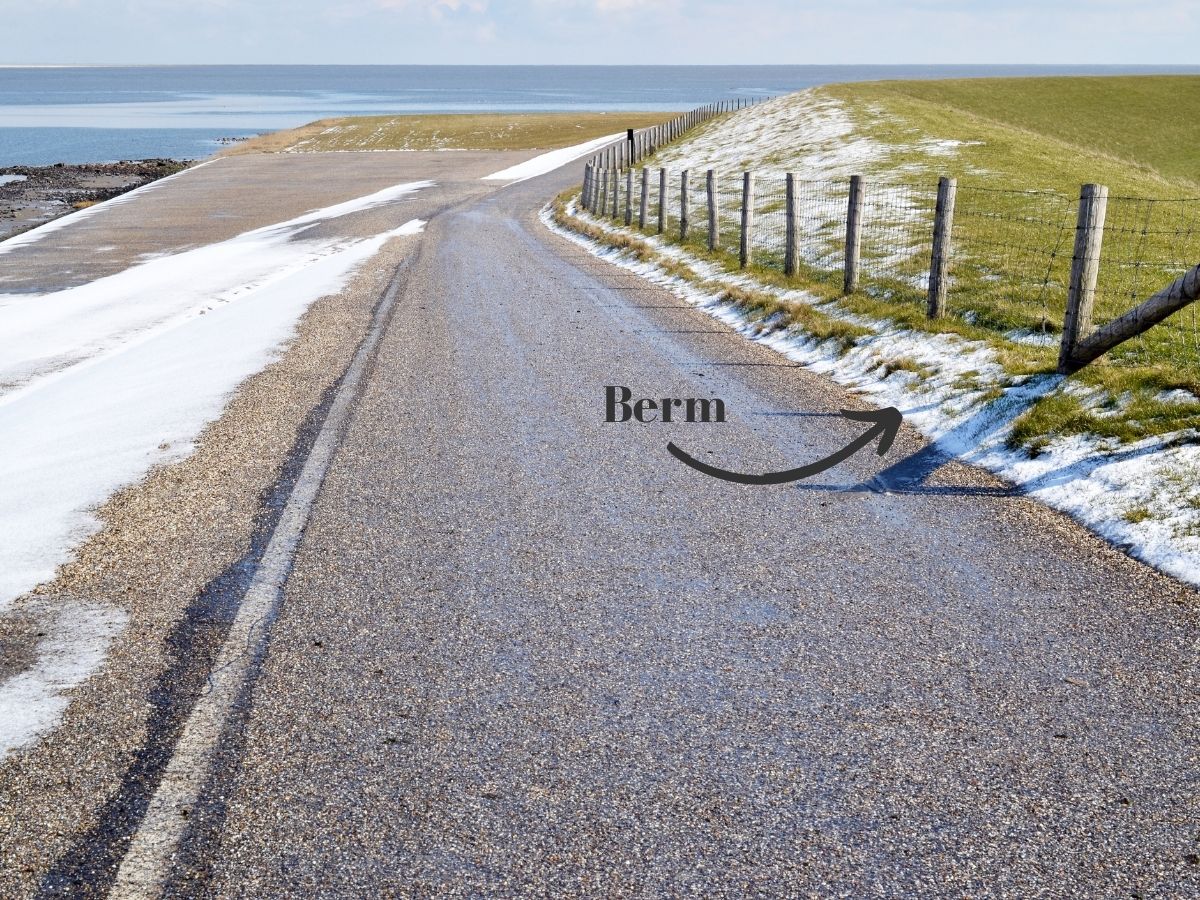
Creating A Rain Garden
Rain gardens are the perfect option if you have an area of the yard that is considerably lower and tends to deal with stormwater pools. This will also add to the general appeal of the yard. Many people do not even realize that rain gardens have a tremendous environmental purpose, making this a true win-win scenario for the homeowner.
The first part of the process is identifying a low-lying area and adding several water-loving plants. Some examples are butterfly weeds, bee balm, and daylilies. If there are no low-lying areas in the yard, it is possible to dig one on your own or contact a landscaper. You will have an easy-to-care-for rain garden filled with low-maintenance plants to help the environment.
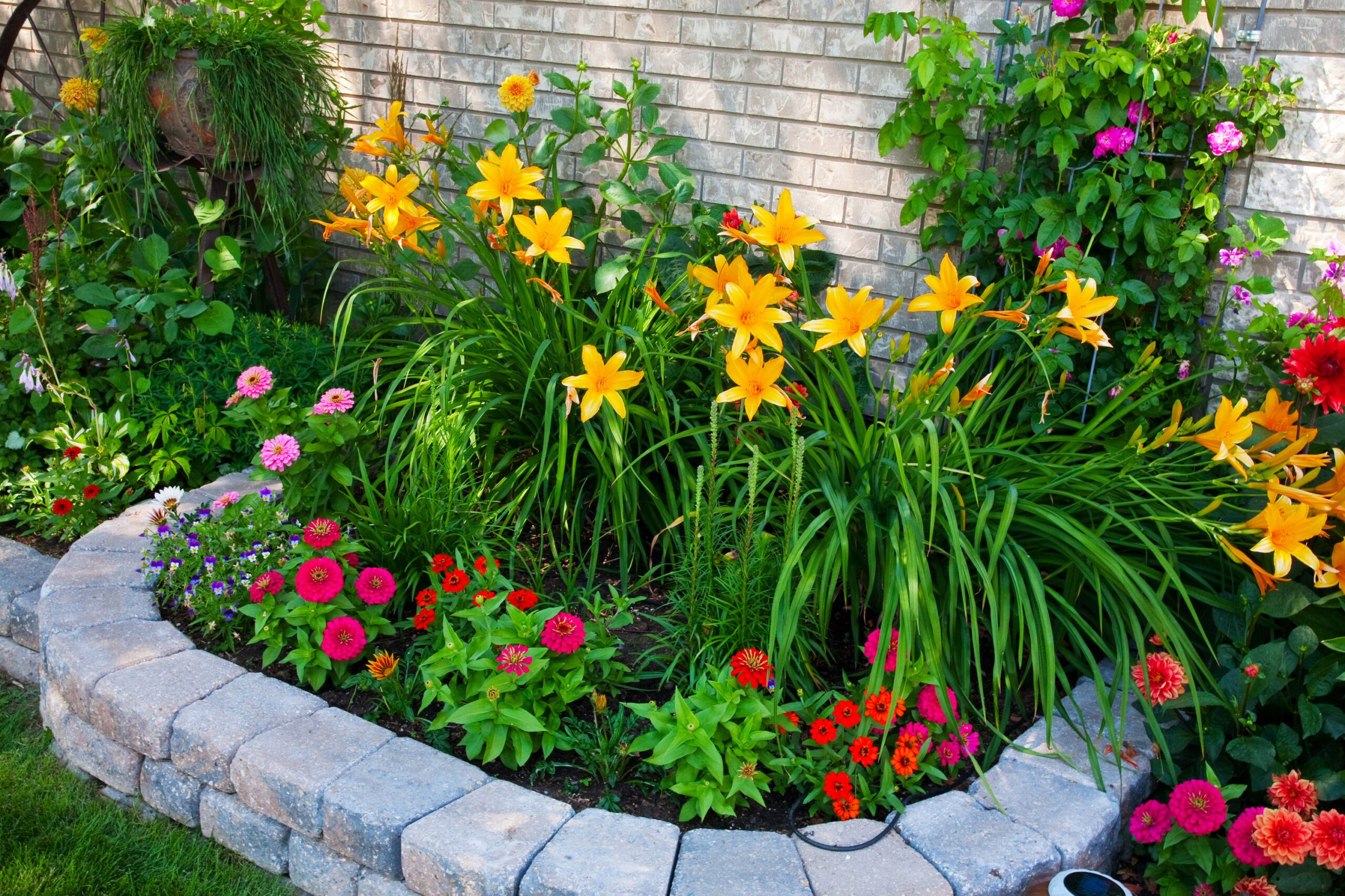
Stormwater Design – Hardscaping With Permeable Pavers
Many residential communities in rainy areas must deal with the environmental struggles of runoff. In fact, it is possible for one urban block to produce more than five times the amount of runoff than a forested area would. This can become a crisis situation where driveways, sidewalks, and parking lots prevent the natural absorption of water.
What should a homeowner do in these situations? This is where permeable pavers come into play. They offer a very easy way to manage stormwater through your patio, driveway, and other hard surfaces. The stormwater will flow through the paver into the soil instead of running into the street.
You may wish to use a permeable paver for any type of hardscaping that will create a long-term solution for water runoff. This is a more expensive stormwater design process than gardening, but it greatly helps the community overall. The next time you plan to work on a patio or driveway, you will want to research this to see if it is a viable option.

Stone Beds And Gravels
Stone beds and gravel areas help to provide a porous area that will allow stormwater to be fully absorbed into the soil below. These beds will often be used in swales and have become quite popular due to their natural look. In addition, they are an excellent option for areas in which grass does not grow well.
The creation of stone beds can help slow the runoff of water and aid in the reabsorption of stormwater. You can create your own gravel path to create a natural, attractive, environmentally friendly landscaping feature. You will begin by placing markers for the path, digging down to about three inches, and adding a hard layer pack of stone and eventually crushed stone on top.

Steep Slopes For Runoff
You will want to consider the slope of the land when you are designing stormwater landscaping. If your property has a slope toward a building, it is essential to divert the water from that area. Steep slopes can actually be a good thing when considering stormwater absorption.
It is possible to create tiered retaining walls with rock and plants that require a great deal of water. These types of garden terraces will slow down the flow of water on a steep slope and reduce soil erosion.
Down to Earth Services’ Tips When Dealing With Stormwater Runoff
It is essential that you research which of the above methods will make the most sense for your situation. Your overall plan will depend upon your specific climate, yard size, and the amount of rain you experience.
You may not want to plant a rain garden if you are in an area that remains quite dry most of the year, only to get hit by severe storms. In this case, you may choose permeable pavers or even a stone bed.
Regardless of what you decide to choose, you are doing the best for the environment and future generations when you execute the plan for your stormwater design. The more you can do to prevent serious runoff and encourage the reabsorption of stormwater, the more you will help the surrounding ecosystems. For more information on ecological landscaping and native plant communities, contact Down to Earth Services today! We are the native plant experts of Missouri and Kansas, and we are here to help you design, create, install, and manage a beautiful and regenerative landscape.
A Guide to Naturescape Landscaping
At Down to Earth Services, we specialize in using locally grown plants to create pristine natural landscapes for your garden. Have you ever considered a naturescape? Our specialized designers will work with the shape and contours of your outdoor oasis to find the unique natural beauty of your outdoor space. Keep reading to learn more about naturescaping, and when you’re ready to create your own naturescape, call our native plant specialists.
Naturescaping supports local biodiversity and integrates a variety of habitat components that promote the longevity of:
- Wildflowers
- Shrubs
- Native grasses
- Trees
- Ferns
- Hedges
- Wildlife
Comparing a Naturescape vs. Traditional Gardens
Because a locally-sourced selection of plants has spent many millennia becoming accustomed to the local climate, you will find that it is the best choice for your local garden. Here are some of the reasons why:
Less Lawn Care and Landscaping Maintenance
Native plants are part of the natural ecosystem and thrive in their native regions. This means you will have less to worry about when it comes to maintenance compared to plants and flowers that are not native to the area. In addition, local plants are suited to the region they grow in regarding rainfall and sunlight and have ample protection against disease and predators.
Some of the tasks you will minimize with your naturescape include mulching, fertilizing, mowing, and watering.
With resistance to local elements and planted in an ideal environment, a naturescape will flourish with little maintenance, which will save you time and resources.
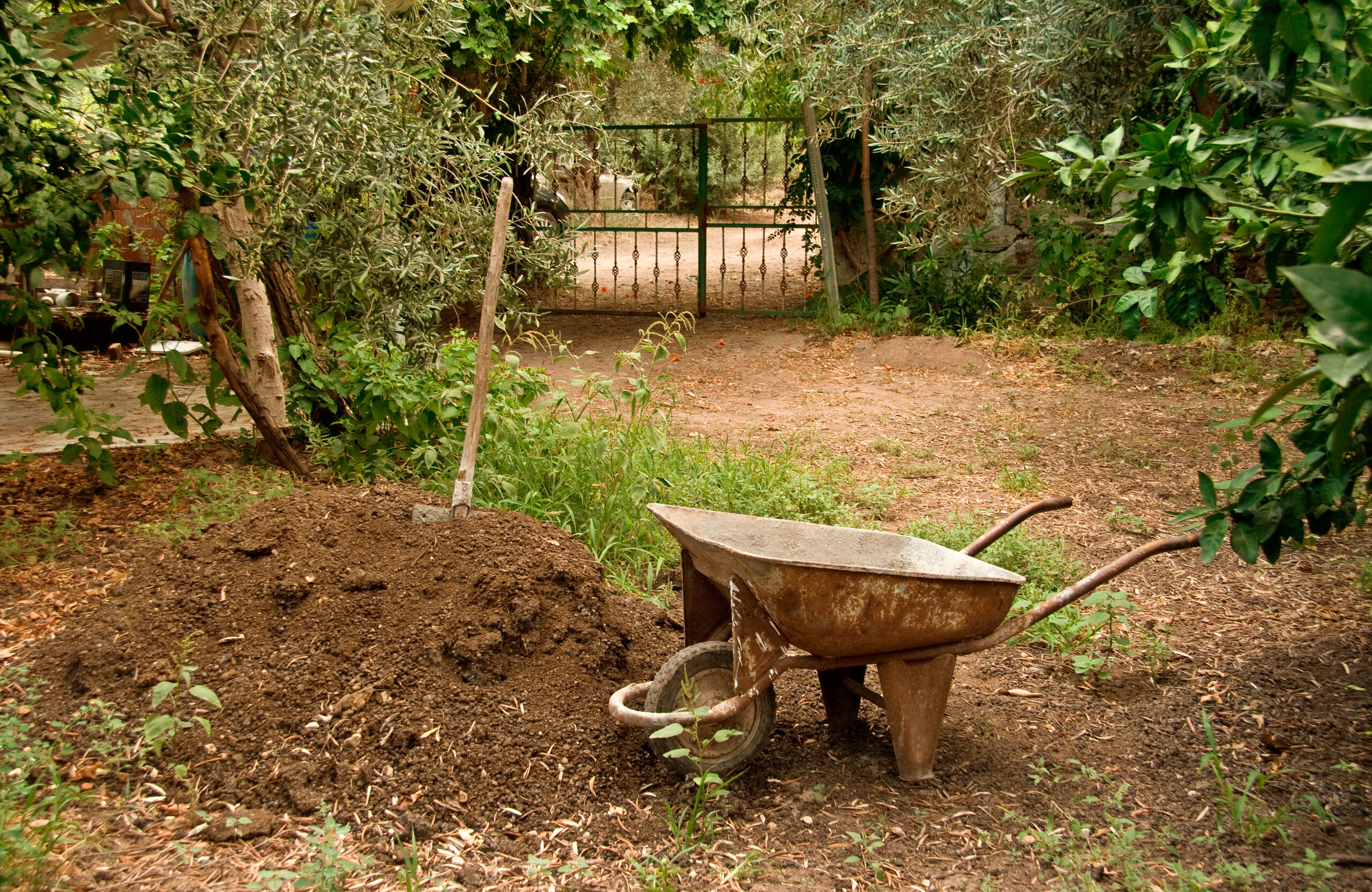
More Cost-Effective
Locally sourced gardens can also save you money. Trying to support a selection of attractive plants and shrubs in a climate not suited to their type will be costly and inefficient.
Did you know that anywhere from 40% to 60% of your water bill can be related to maintaining a lawn?
However, a natural landscape with plants that have evolved to survive in the local climate will not require such extensive watering as they are suited to the local rainfall.
This means that you could save as much as half of your monthly water bill by working with our native plant specialists.
Naturescapes are Environmentally Friendly
Naturescapes support and promote the local flora and fauna. By applying this natural order to your property, you will find that your landscape will support the life of keystone species, including local insects, birds, and other animals. There has been a considerable decline in the songbird population (5%-10%) because of habitat loss. Creating a naturescape can be an excellent way to restore these lost habitats.
Furthermore, you will not need to use chemical fertilizers and insecticides to protect your plants suited to the area. Additionally, your naturescape will be an added benefit to the beautiful Missouri and Kansas wildlife.

10 Keys to Naturescape Landscaping
Here are ten tips to demonstrate how you can apply the concept of naturescape landscaping in your home and outdoor space.
1. Enhance Your Dirt
Collect disease-free organic vegetable compounds and create a compost where you can start returning health and life to your soil. Taking the time to restore organic substances to the soil is vital to maintaining the health and quality of the soil.
Proper composting provides the following benefits to your soil:
- Improves water infiltration and retention
- Provides plants with the nutrients they need
- Builds up beneficial soil microbes
- Follows nature’s example
When the leaves from your trees fall to the ground, sweep them off paths and walkways, but allow them to collect under shrubs and bushes. This provides all the benefits of mulch without spending a cent.
Mulching provides essential benefits to the soil as well, including:
- Improves moisture retention
- Fights weed growth
- Provides nutrients for plants over time
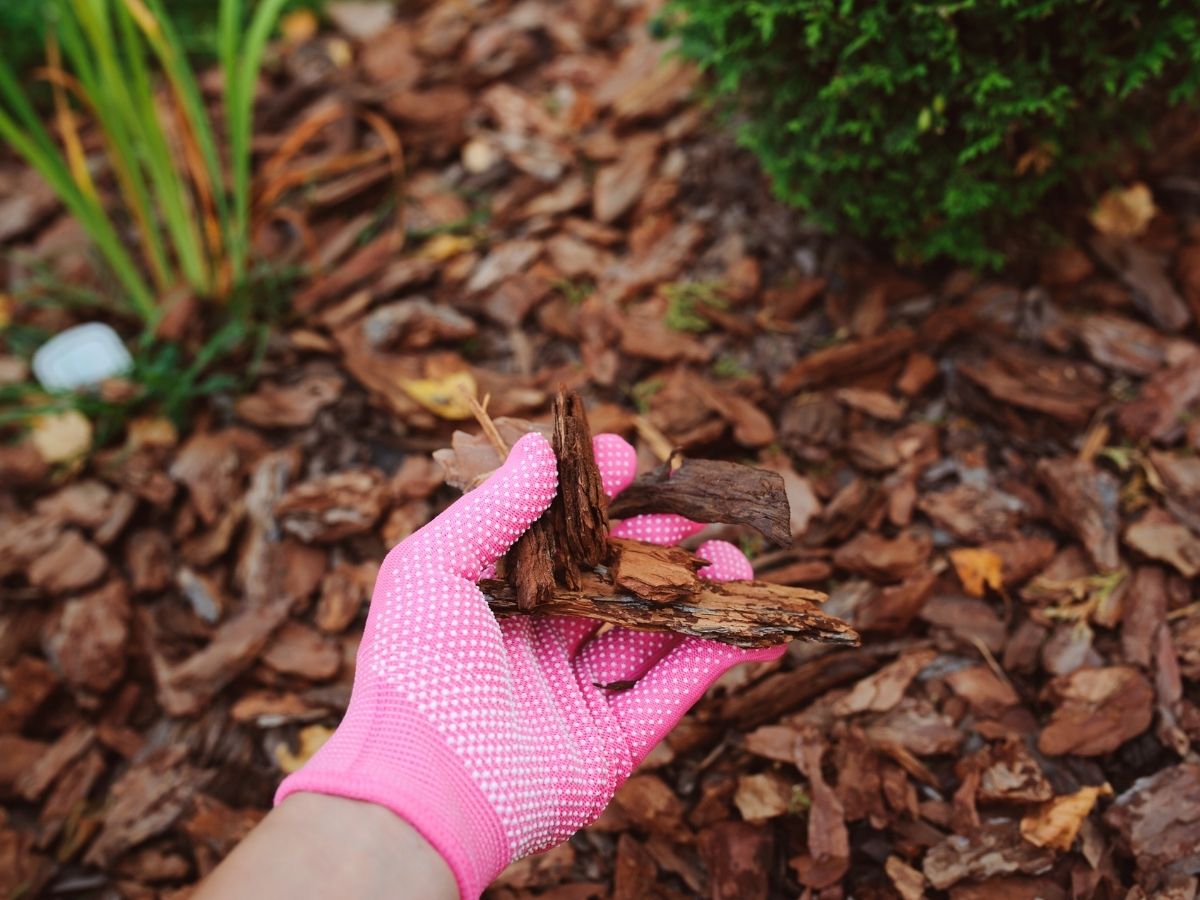
Take a note of all the things you can compost in your home. This includes some scraps from your kitchen — but no meat, greases, oils, or dairy products. Vegetable matter is always a good option. You can always throw twigs, branches, and plant clippings into the compost.
2. Herbaceous & Woody Plants
You can create an interesting display in your garden by using your local area’s most attractive plant specimens. Include herbaceous and woody plants to help your naturescape garden.
The trees and woody plants will form the bones and structure of your garden, while the limbs, twigs, and branches add a visual framework, provide privacy and shade, and create accent points.
Then you will use the herbaceous plants to add texture and color to the visual display, especially between spring and fall. The texture of the leaves and the colors of the flowers will be critical visual elements.
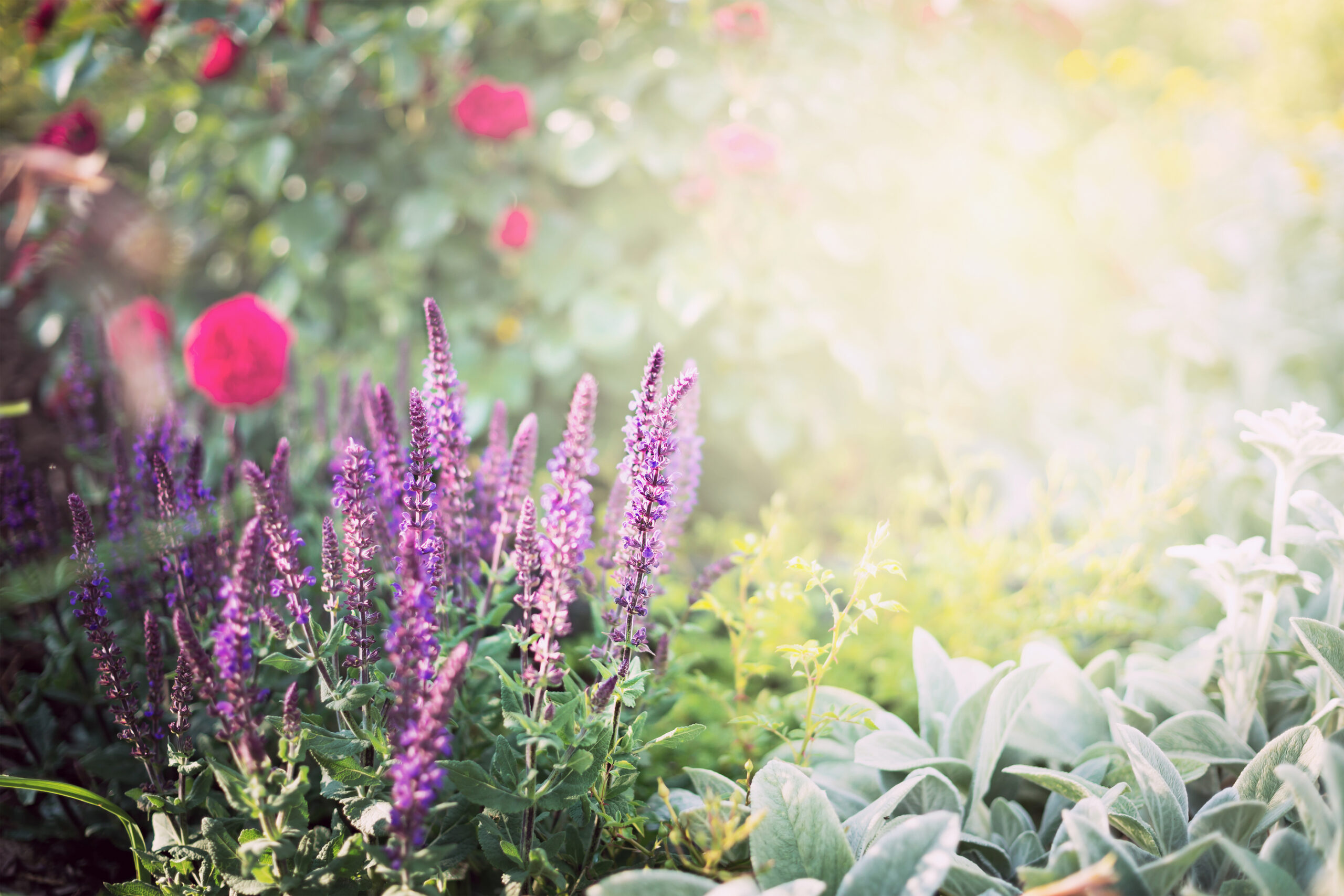
3. Drifts & Masses
You can create a sense of flow and rhythm by planting in drifts. In addition, planting in drifts means that you will provide visual stimulation by applying slight changes in gradations of color, land topography, form, and texture.
The idea is to create a fundamental order that comes from having massed groups together. For example, you can create a group of similar plants with similar forms, colors, or textures by placing three of a kind together. You can repeat this process throughout your naturescape to achieve the desired effect.
4. Right Plant, Right Place
Begin by assessing the conditions of your garden day in and day out. Which are the areas that get the most sunlight or shade? Which areas have more moisture than others? This information will allow you to plan your naturescape properly.
Once you have a better understanding of the conditions of your property, you can begin to choose the plants that will flourish best. There are other important points to keep in mind, such as spacing. Plants planted too close can cause a threat of disease, while plants planted too far apart may mean unwanted weeds creeping through.
Choose good plants and good plant networks as well. Look for the species of plants that have existed well together and help each other survive. When planted together, these plants increase the potential for survival and will usually complement each other visually as well.

Avoid plants that you have to replace each year and plants not suited for your environment. Plants sensitive to extreme temperatures will have a higher potential for failure. Down to Earth Services is here to help you every step of the way with our expert knowledge and experience with naturescapes.
5. Space Your Plants Wisely
When planning the layout of your plants, give them plenty of room for both root expansion and crown expansion. Proper space will allow your trees and scrubs to reach their full size and promote health and natural fullness.
6. Keep Your Plants to Scale
The smaller the plant, the more specific the considerations for its proper placement. For example, if you are planting in a pot, the plant should not be one that will get taller than the width of the pot. When planting in the ground, if the plant bed is 4-ft wide, the plants should grow no higher than 4-ft.
7. Capture Stormwater on Location
Stormwater collects heat as it flows over asphalt and concrete and can also pick up contaminants, including:
- Heavy metal
- Dust
- Auto oil
- Pesticides
- Fertilizers
- Other debris
When excess water is making its way across your garden, erosion and flooding can result. Furthermore, the contaminants carried in the water can be toxic to plant and animal life.
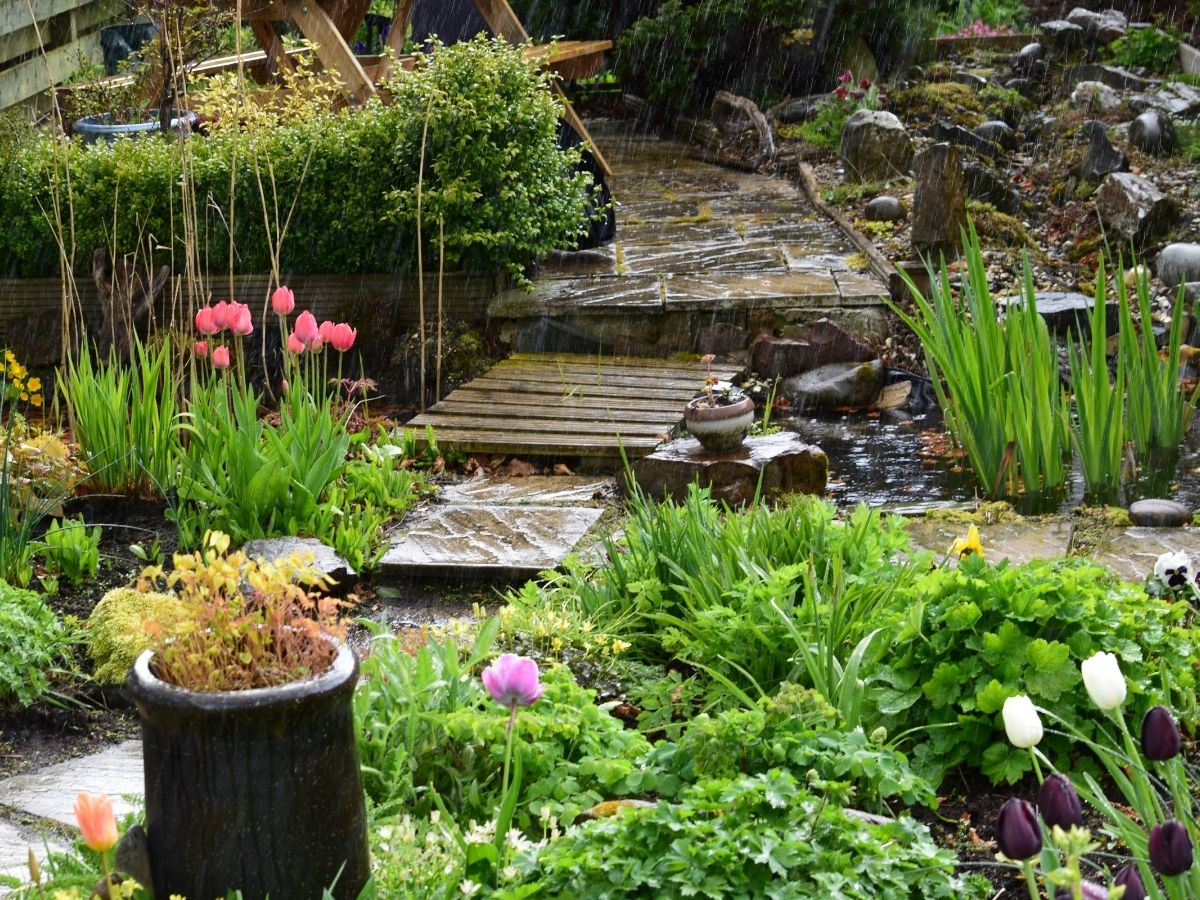
If the soil you have and the incline of your property allow, you can build a rain garden. This design lets you capture the runoff from less contaminated surfaces like your driveway and roof and direct it through your garden, allowing stormwater to soak into your garden.
9. Encourage microorganisms and beneficial insects
Use plants that protect larvae and their food sources. Avoid chemical-based fertilizers and other soil amendments that can harm the life of microorganisms living in the soil. These tiny animals are essential to the health of the soil and can also prevent diseases in your garden.
10. Mow Your Edges
Finally, for a more manicured look, keeping the edges of your garden clean, trimmed, and well-defined will add a deliberate look to your garden. These care cues go a long way in keeping your garden and property attractive.
Conclusion on Naturescape Landscaping
As you can see, there are plenty of benefits to be found in creating a naturescape. These benefits are as much for you as for the environment. In addition to maintaining an attractive property, you will save money and contribute to a healthy living environment.
When using locally sourced plants to create your naturescape, get creative! Whether you want a more refined look or a touch of wild, be sure to start with a solid design idea. Then, add elements to beautify and balance your landscape. Down to Earth Services is here to create, install and maintain your naturescape. To learn more about the native plant specialists of Kansas and Missouri, contact Down to Earth Services today!
Protecting Missouri’s Keystone Species
Did you know that pollinator populations have declined throughout the last century? Our growing population and modern agriculture have contributed to dramatic changes in our landscape. Today, Down to Earth Services is here to discuss protecting Missouri’s keystone species and the significance of these species and pollinators. Numerous pollinator species are diminishing in Missouri, along with other parts of the world, and if you’re ready to do your part, keep reading for tips on keystone species conservation.
The Significance of Pollinators
Pollinators play a vital role in our natural ecosystems and agricultural productivity. Not to mention, pollinators play vital roles in human wellbeing through the pollination of food sources. Increased public knowledge has encouraged action; however, there is still much to be done to ensure the survival of our pollinators and keystone species.
As human growth invades ecosystems, environmentalists, farmers, and scientists work feverishly to rescue species worldwide. Pollinators and keystone species have great societal importance. They not only boost agriculture production in Missouri, but they also serve a vital part in preserving the health of our forests.
What are Keystone Species?
The phrase “keystone species” is used in ecology to characterize a species on which other species in an ecosystem rely on, either directly or indirectly, and whose loss would result in a drastic shift in the ecosystem. The wolf is a prime example in that the wolf regulates herbivore populations such as deer, elk, and rabbits that devour the many plants that feed countless species, including birds and insects. Thus, the extinction of a keystone species has far-reaching consequences in an ecosystem.
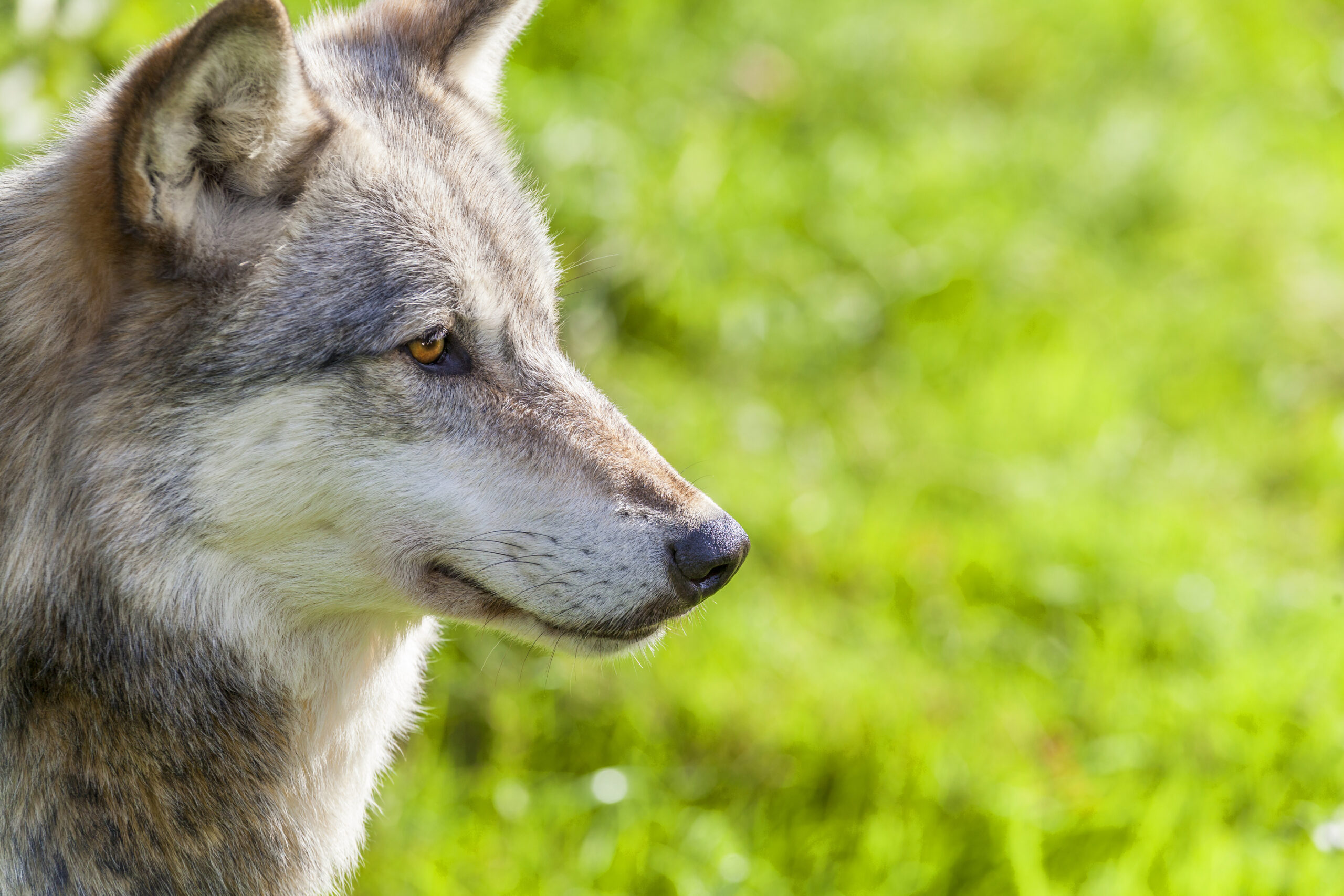
Pollinators are regarded as keystone species because they pollinate many vital blooming plants. Around 80 percent of the world’s plants rely on animal pollinators to reproduce. The remaining 20 percent self-pollinate; are pollinated by wind, as oak trees and corn are; or are pollinated by water, as many aquatic plants are. Bees provide 67 percent of pollination services, making them one of the most vital pollinators for natural ecosystems.
Furthermore, the fruits and seeds of the bees work are the principal sources of nutrition for many birds, animals, and insects. For example, almost 25 percent of Missouri’s birds rely on pollinators for their primary food supply. The Missouri black bear gets a significant percentage of its nutrition from berries, which do not set healthy fruit without insect pollination. If fewer plants are adequately pollinated, less food is available for animals. Like those of the wolf, these consequences are felt across the environment.
Indicator Species
Pollinators are also thought to be indicator species. As a result, their existence, abundance, and health can convey information about the overall health of an ecosystem. A broad and thriving pollinator community will benefit a wide range of plants and, as a result, the rest of the ecosystem. Conversely, pollinator declines are concerning because more species are being added to the vulnerable or endangered list, and keystone species play an essential role in natural ecosystems. The recent reduction in rusty patched bumblebee and monarch butterfly populations may thus indicate overall habitat quality in Missouri.
Pollinator Threats
Pollinators serve an essential part in our food chain, from pollinating clover, which fixes nitrogen into the soil, to filling our orchards with an abundance of fruits and nuts. A large portion of contemporary agriculture relies on these species to satisfy the high demand. And in many cases, pollinators provide these services for free and without the intervention of humans. To ensure we continue to have a diverse range of low-cost commodities, both wild and managed bees should be considered when planning or managing agricultural land.
Most people associate “threatened pollinators” with the honey bee and the monarch butterfly. However, several other pollinator groups are experiencing species decreases. The primary reasons for these decreases are divided into three categories: habitat destruction, pesticide and agrochemical exposure, and the spread of disease.
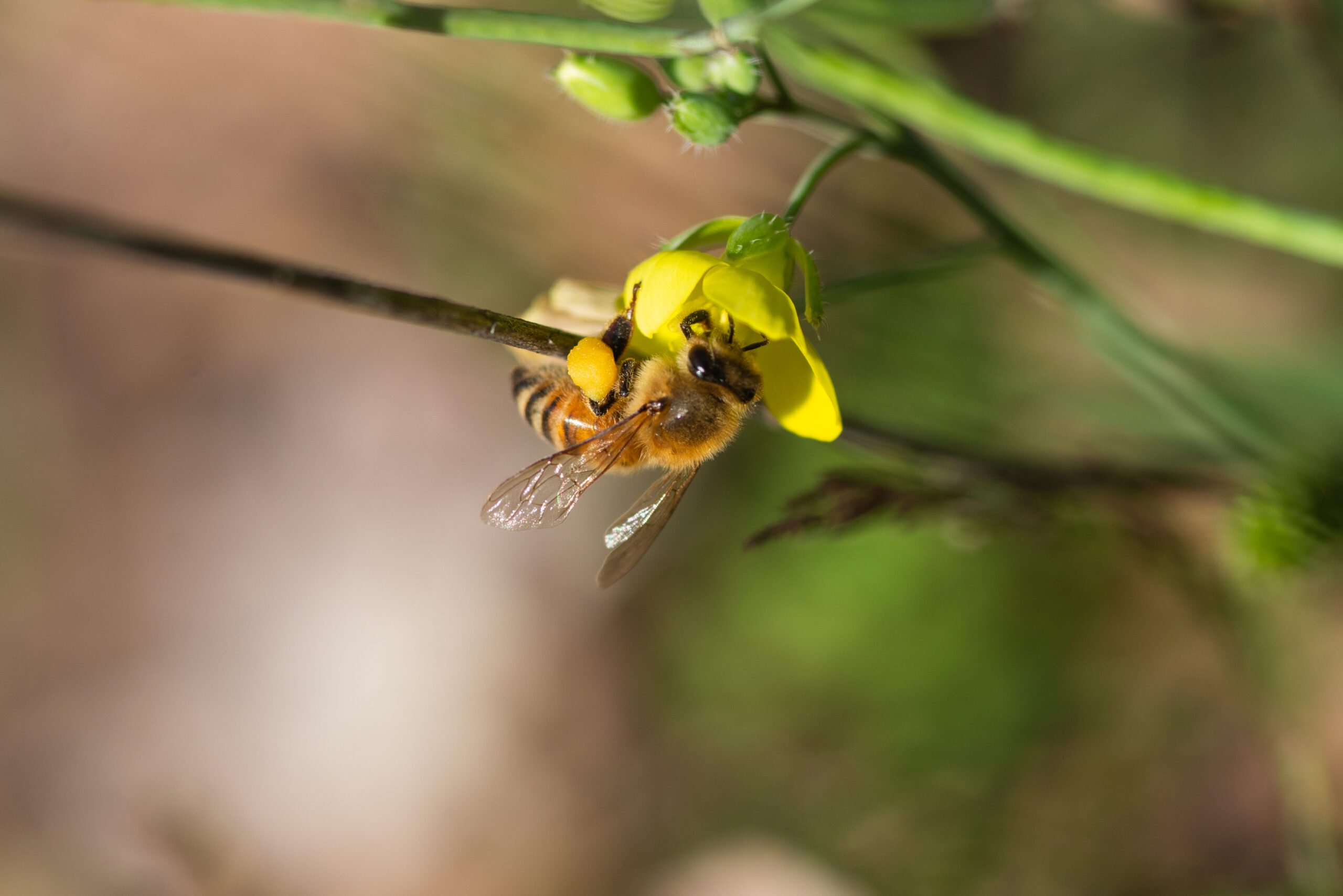
Playing Your Role in Helping Protect Keystone Species
One of the most exciting elements of keystone species conservation is that there is so much that we all can do to help these species. Our choices in our own backyards and our consumer choices and activities alter the landscapes around us, influencing pollinators and other wildlife habitats. Here are some ways you may help.
1. Plant to attract pollinators.
Creating a pollinator-friendly garden filled with the best perennials for pollinators that offer nectar and pollen is one of the best ways to support declining pollinator populations. Plants native to your location are best suited to both your environment and the pollinators that thrive there!
Blooming trees are also very appealing to pollinators. If your outdoor space or garden is not large, consider adding a few potted blooming plants. Many of the most significant plants for pollinators are low-maintenance and may be grown in containers on a patio, balcony, or window box! For more plants to add to your native garden, check out the article on low maintenance landscaping plants here.
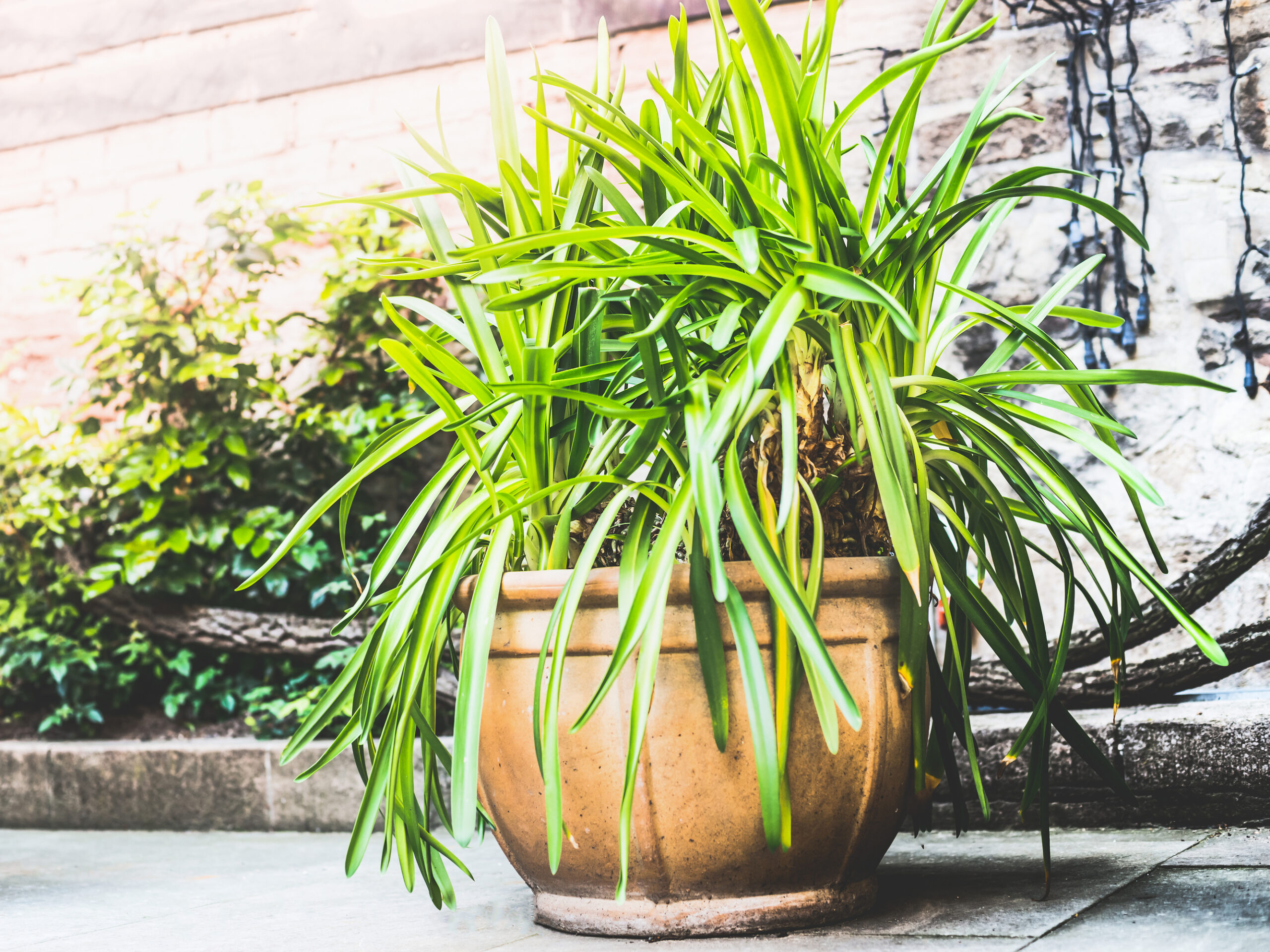
2. Add native plants to your landscaping.
Native plants and native gardens serve as the cornerstone of pollinator habitat by supplying pollen and nectar for sustenance, protection from the elements and predators, and places for their young to thrive. Filling your yard with native plants is the best method to attract gorgeous butterflies, industrious bees, fast hummingbirds, and other pollinators.
3. Go beyond flowers to create a wildlife-friendly yard.
While flowers are essential, pollinators also require other elements to flourish! Make every effort to offer habitat and additional food sources for a wide range of pollinators and animals. Hummingbird feeders, bird homes, birdbaths, solitary bee houses, and even bat cages may be added to your outdoor space. Set up small water baths for bees, such as a birdbath or a shallow dish filled with stones or gravel. Allow some sections of your yard to grow “wild” and less groomed, providing safe nesting and refuge locations.

Pruning vines and trees should be done with caution, especially during recognized bird breeding seasons. Allow some of the wild “weeds” in your yard, such as dandelions, to blossom. Also, refrain from deadheading all of your wasted flowers. The birds will enjoy eating the seeds. A healthy animal habitat includes shelter, food, water, and places to raise young.
4. Provides bees with nesting sites.
There are 4,000 native bee species in North America (the honey bee is a European immigrant), yet the vast majority do not establish colonies. On the other hand, individual female bees deposit their eggs in tunnels in rotting wood or sandy soil. You may provide such nesting sites by leaving snags of trees on your land, leaving bare patches of sandy soil, or making or purchasing quirky, native bee homes.
5. Refrain from using pesticides.
Avoid using chemical pesticides to help safeguard pollinators. Instead, maintain your yard or garden naturally and organically. Several techniques exist to tackle pests without harming beneficial insects such as bees and butterflies. In addition, beneficial insects may be employed to control pest bug populations! For example, native American ladybugs, lacewings, and praying mantis eat many soft-bodied nuisance insects, such as aphids. Releasing them in your garden is called biological pest management instead of chemical pest control. Other non-chemical pest control methods include companion plants, polyculture, and physical barriers.
Many homemade or moderate sprays, such as dilute neem oil, can also be used to manage plant pests. Furthermore, many “organic” pesticides can kill bees and other vital insects if misused. As a result, before utilizing any type of spray, please conduct an extensive study.
6. Grow milkweed.
The famous monarch butterfly has decreased by more than 90% in just twenty years. A shortage of milkweed, the species’ only caterpillar host plant, is one of the primary causes of this decrease. Monarch butterflies cannot complete their life cycle without milkweed, and their populations suffer as a result. Planting milkweed in your yard, garden, or neighborhood will not only attract these gorgeous butterflies but will also provide critical habitat for their caterpillars. Find out what milkweed is natural to your area and how to obtain it.

7. Make a Statement Outside of Your Home
There are several ways to help preserve pollinators outside of your own yard. If you live in an HOA, or other managed community, speak with the people in charge of landscape maintenance about pollinators, pesticide usage, and organic gardening choices. In your workplace, you should also ask questions and provide knowledge.
Last Tips on Protecting Missouri’s Keystone Species
If you’re ready to start protecting Missouri’s keystone species, you are not alone. Down to Earth Services are the native plant specialists of Missouri and Kansas. We install, design, and manage sustainable landscapes. With so many pollinator species weakening in Missouri, it is time to step up and do our part. Call Down to Earth Services today to learn more and get started!
How to Prevent the Spread of Invasive Plants
Invasive species are non-native organisms that affect the local ecology. When non-native plants and animals establish themselves in our local ecosystems, they outcompete and displace species that have evolved to thrive there specifically. These plants impact us by eroding our soil, causing erosion, and potentially lowering our water quality. They crowd out and, in some cases, destroy key tree species that offer shade, carbon storage, and habitat for local fauna. Furthermore, they can potentially raise the risk of a wildfire. We need everyone’s help in preventing the spread of invasive plants.
“An ounce of prevention is worth a pound of cure,” as the adage goes. This remark is especially relevant when it comes to limiting the introduction and spread of invasive species in our national parks and backyards. There are a number of things we can all do to help avoid transferring invasive species. The following are some suggestions to help prevent the spread of invasive plants.
Tips for Preventing the Spread of Invasive Plants and Species
Do Not Move Firewood
Firewood is frequently cut from dead or dying trees, which are often home to creatures such as the emerald ash borer, a very harmful invasive species. Moving firewood can transport these insects from one location to another, thereby dispersing unwanted pests and potentially seedlings or invasive plant species. Please support your local firewood suppliers by purchasing firewood from them, and do not move the wood after you’ve purchased it.
Clean Hiking and Fishing Equipment
While you may be taking a pleasant trek along your neighborhood path or catching some fish in a nearby stream or river, you may be unwittingly gathering invasive species off your boots and waders while you hike and fish. So make a habit of spraying and wiping off your boots and waders after each usage, especially if you’re traveling with them, to avoid accidentally inviting an unwanted species to the party.
Anglers are also recommended to convert from felt-soled waders to rubber-soled waders to prevent harboring invasives. Didymo, sometimes known as “river snot,” is one example in the Chesapeake Bay. Didymo is a species of algae that develops dense mats at the bottom of freshwater streams and can be difficult to break apart or remove from rocks.

Fish With Native Bait
When you go fishing in your local stream, river, or creek, your bait may be an invasive species shaped like a worm or fish. Seek to find natural bait if at all possible. Don’t throw your bait into the water when you’re done fishing.
Clean Your Boat
Aquatic invasive organisms, such as various forms of algae, can be carried by the bottom and sides of boats. To avoid spreading undesirable invasives, properly wash your boat before moving it from one body of water to another.
Volunteer to Help Remove Invasive Plants
English ivy creeps up the walls of our buildings, covers our forest floors, and grows up the trunks of our trees. You may help by participating in a local eradication operation or just taking the time to remove invasive plants from your own yard.
Report Invasive Species
You may report any sightings on the Missouri Invasive Plant Council Website. For additional information on reporting an invasive species in Missouri, go to the Department of Agriculture’s website. The website is an excellent resource for residents.

Early Detection of invasive species and addressing the new infestation as soon as possible is essential for good invasive species management. If an invasive plant species is not recognized and eradicated as soon as possible, costly and long-term control may be required.
Wash Your Car
Wash your car, especially if you’ve been driving on gravel or dirt roads. Plant matter can become lodged in your tires and undercarriage. This covers automobiles, motorcycles, and ATVs.
Check Your Pets When Traveling
Like your boots and garments, your pet’s paws are ideal seed carriers. So, when traveling with your pet, make sure to inspect them and brush them off!
Consult Down to Earth Services – Your Local Native Plant Nursery
Visit Down to Earth Services, your local nursery, and talk to them about what plants are natural to your area. Consider redbuds, butterfly milkweed, coneflowers, and more native plants to add to your lawn and landscaping! Bid farewell to the Bartlett pear tree, and say hello to the dogwood! Your yard, as well as our ecology, will be grateful. Our best natural protection against invasive species is native species. Native plants use less water, save time and money, and create critical habitats for pollinators.

Final Notes on Preventing the Spread of the Invasive Plants
Invasive plants are one of the most significant issues plaguing landscapes and communities across the United States. Take the steps above to prevent the spread of invasive plants and species. Down to Earth Services is here to help! As the native plant experts of Kansas and Missouri, we can help design, install, and maintain your native plant garden and landscape. Contact Down to Earth Services today to learn more!
Low Maintenance Landscaping Plants for Your Garden
Native shrubs and flora are the perfect choices for sustainable and low maintenance landscaping plants. To learn native plants are not only vital for your garden but beneficial to the landscape and wildlife around them, check out the below article and some of the common Missouri native species and landscaping suggestions. Down to Earth Services are the native plant experts and can recommend low maintenance landscaping plants and more to add to your garden.
Advantages of Native Shrubs and Flowers for Your Landscape
Although it may appear insignificant, everyone can make positive decisions for our world and environment by planting native. Keep reading for the many advantages of native low maintenance landscaping shrubs, plants, and more.
- Large landscapes require significant fertilizers, herbicides, insecticides, water, fuel for mowing, and time.
- Non-native and exotic plants also require more significant resources, and, unfortunately, people frequently destroy native habitats to create artificial oases. Additionally, in doing so, some of the exotics are incredibly invasive, which can choke out native plants and change ecosystems.
- The extinction of natives can have repercussions for numerous pollinators. There are many beautiful perennials for pollinators that will not only add to the beauty of your landscape but help maintain nature’s delicate balance.
- Native flora will have a far greater survival rate since they are adapted to the soil and climate in which they grow.
- Native shrubs and plants self-seed, making native plants some of the most low maintenance landscaping plants for your garden.
- Weeds are less prevalent with native flora.
- Native landscapes provide a safer ecosystem for everyone, including your pets, because fewer chemicals in the soil result in safer water sources.
- Native plants are essential for pollinators. Without pollinators like bees, butterflies, and birds, we have fewer food resources.
What Exactly Is a Native Plant?
Many people ask, what distinguishes a plant as a native? The answer is simple. Native plants are any plant growing in North America before the arrival of Europeans. Native flora includes blooming perennials, ferns, flora, grasses, shrubs, trees, and vines. More than likely, you have native plants already growing in your landscape.
Once they are well established, native plants can endure seasonal circumstances from hot and dry to cold and snowy weather. Natives contribute to local biodiversity, providing a natural habitat and food for the wildlife in the region. These plants help your landscape thrive and provide beauty for everyone to enjoy.
Low Maintenance Landscaping Plants Native to Missouri and Kansas
Below are a few examples of native flowers that are prevalent in Missouri and Kansas. During your planning phase, be sure to include plants that are native to your region. There are many native flora databases available online that can assist you.
In addition, Down to Earth Services native plant nursery stocks plants native to Missouri and Kansas. Be sure to contact us for availability as well as help in designing your low-maintenance native landscape.
- Cardinal flower (Lobelia cardinalis)
- Wild Columbine (Aquilegia canadensis)
- Butterfly Milkweed (Asclepias tuberosa)
- Evening Primrose of Missouri (Oenothera macrocarpa)
- Ozark Witch Hazel (Hamamelis vernalis)
- Prairie Coreopsis (Coreopsis palmata)
- Purple Coneflower (Echinacea purpurea)
- Purple Poppy Mallow (Callirhoe involucrata)
- Showy Goldenrod (Solidago speciosa)
- Sky Blue Aster (Symphyotrichum oolentangiense)
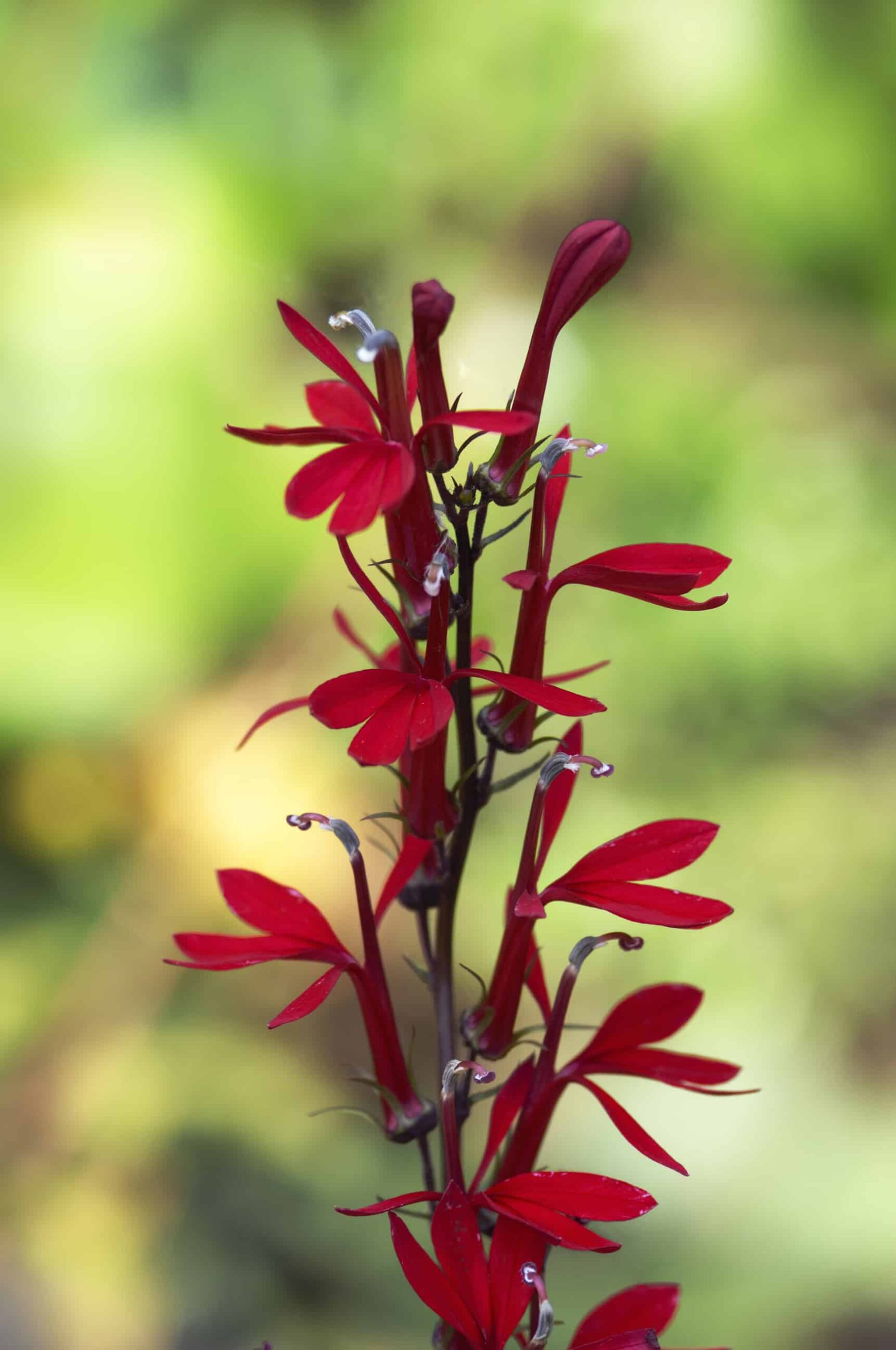
Additionally, native trees and shrubs are beneficial to your landscaping, providing food and shelter for local wildlife. These beautiful plants also provide benefits like fragrant blooms, fruit, and vibrant foliage. Below are some examples of native trees and shrubs:
- Indigo Bush (Amorpha fruticosa)
- Flowering Dogwood (Cornus florida)
- Fringe Tree (Chionanthus virginicus)
- Pagoda Dogwood (Cornus alternifolia)
- Ruby Spice – Summersweet (Clethra alnifolia)
- Downey Serviceberry (Amelanchier arborea)
- Spicebush (Lindera benzoin)
- Blackhaw Viburnum (Viburnum prunifolium)
- Ninebark (Physocarpus opulifolius)

By planting a mix of native perennials, shrubs, grasses, and trees in your landscaping, you can replicate natural plant communities. By doing this, you are aiding in improving the habitat for pollinators and other wildlife. In addition, this layered ecosystem will help filter pollutants from the environment, reduce soil erosion, decrease runoff, provide a windbreak, shade, and a natural sound barrier.
Landscaping with Native Plants
Native plant landscaping or “naturescaping.” does not have to imply wild. Your garden can be as wild or elegant as you want, depending on your design. The key to success with native plants is to choose the correct plants for your growing environment rather than attempting to alter the surroundings to match the plants. Instead, examine your surroundings to discover what grows wild in your area.
Prairie plants like Coneflowers and Liatris thrive in hot, dry conditions, while natives like tiarella are an excellent groundcover in areas with abundant shade. On the other hand, Blue flag iris (Iris virginica) tolerates damp conditions, whereas yellow woodland foxglove thrives in dry shade.
Top Landscaping Suggestions
When planning your garden, first, determine how much yard you want to convert to a native oasis. Even a small area can have a significant effect! Below are some suggestions to get you started on your low maintenance native landscape:
- Before you start looking at plants, consider the landscape you are working with. Allow nature to guide you in the hardscaping of your garden. Before designing your native landscape, consider the shape of the landforms are rough or soft, bright or subtle, and whether the terrain is flat or hilly. Take detailed notes and maybe even a rough sketch before you decide your preferences for native flora.
- Remove any invasive plants, shrubs, and trees, or they will quickly choke out anything you plant.
- For a more eco-friendly and lower maintenance lawn, consider reducing the grassy area you have by including low maintenance border plants. Then, when it is time to plant in the spring, you can include more extensive beds of native plants and plant native grasses such as Red fescue, Seashore bentgrass, St. Augustine grass, Buffalo grass, and Blue grama.
- Plant what grows best in your type of soil. For instance, if you have acidic soil, select plants that will thrive in that environment. Likewise, if your soil is alkaline, choose natives that require an alkaline environment.
- Please take notice of native plants that thrive in your area, particularly those that grow in groupings or clumps. Knowing what works best for your landscape will result in a beautiful native garden. Grow what is already growing, or a variation of what is growing.
- Rather than ending your plant beds with a straight edge, blur the lines. You can accomplish this by gradually reducing the density of the plants near the garden’s perimeter.
- When planting, do not fertilize. The majority of natives flourish in places with low soil fertility. Too much nitrogen during planting will feed the weeds.
- During the first few months, it is necessary to weed and mulch regularly. When your native plants are well established, you can begin supplementing them. Root development should begin first. Do not be alarmed if it seems that your plants are slow-growing.
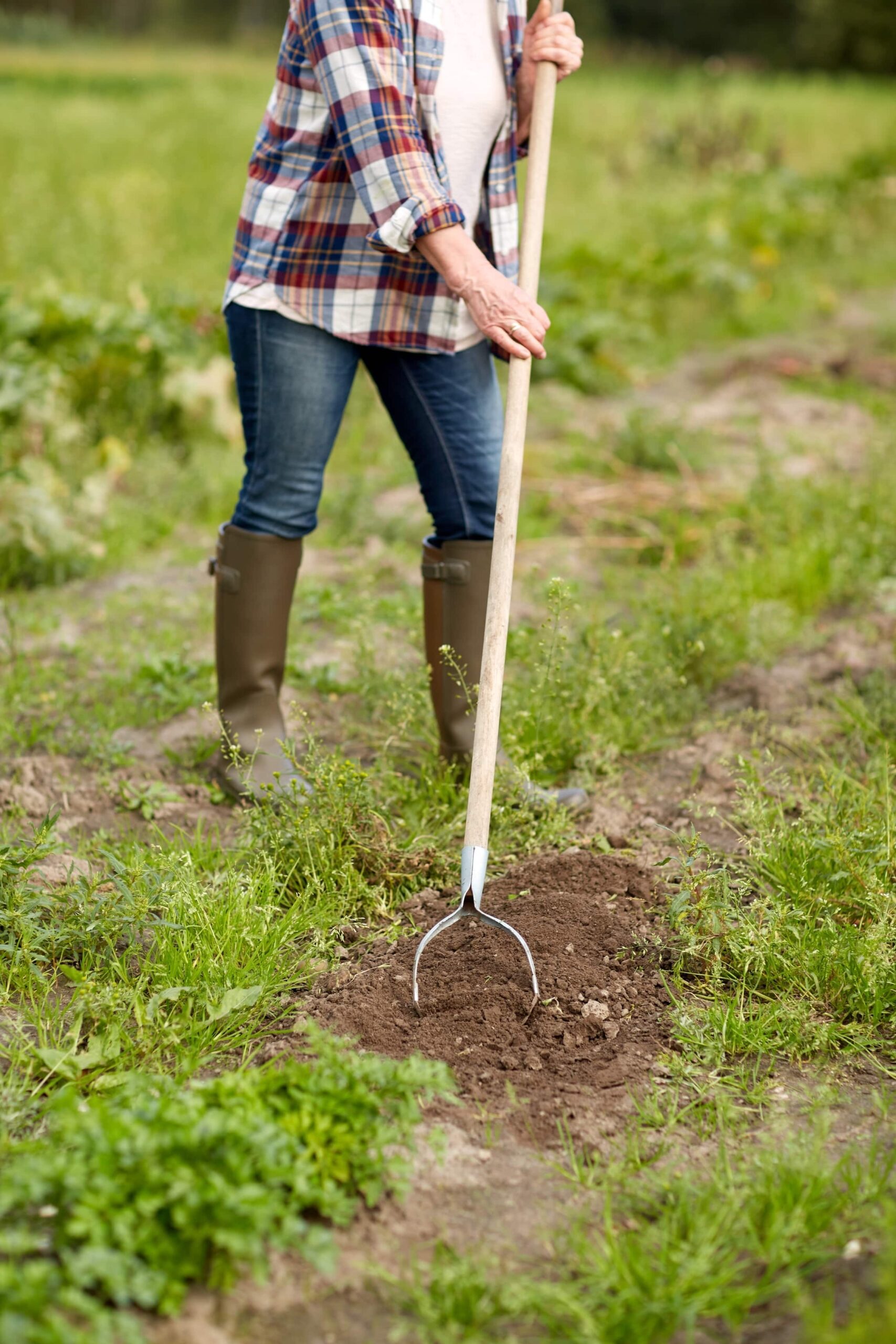
Lastly on Low Maintenance Landscaping Plants for Your Garden
If you’re looking for the best low maintenance landscaping plants for your garden, we hope the above article can be a guide. As the native plant experts of Kansas and Missouri, it is our pleasure to help you take your gardening and landscaping to the next level. Sustainable landscapes can be regenerative and beautiful while also taking less work than exotic flora, shrubs, and plants. So, what are you waiting for? Contact Down to Earth Services today to get started!
Native Shrubs to Add to Your Landscaping
For a good reason, native planting is one of the most popular trends in local landscaping. As much as we adore our lawns, they can use a lot of water, especially during the hot Missouri summers. There are numerous reasons to employ Missouri’s magnificent native shrubs and flowers in your landscape. They add beauty and interest to your garden with a succession of blooms and fruits, and they provide food and shelter for pollinators. If you don’t think you have a large enough space, do not worry. You can incorporate native shrubs and flowers into a small balcony oasis, a suburban lawn, or any other parcel of land.
Benefits of Planting Native Shrubs
Native shrubs and plants evolved thousands of years ago to thrive in Missouri’s climate and environmental conditions. As a result, they frequently use far less water than plants brought in from other places. Additional benefits include:
- Adapts well to our climate
- Are well-suited to our soils
- They require little to no irrigation
- Fertilizer and insecticides are rarely required
Did you know?
Watering lawns consume up to 60% of fresh water in urban areas in the United States. Each year, we use over 67 million pounds of pesticides for lawn maintenance in the United States. Lawn mowers can emit the same amount of pollution as a car traveling 20 miles in one hour. When you grow native shrubs and flowers, you are helping the environment by utilizing plants meant for your specific area, which helps decrease the need for pesticides, constant watering, and pollution.

Keep reading below for the best native shrubs for wildlife and the environment.
Shrubs and Bushes Native to Missouri
Fall is a beautiful time to start thinking about your native garden or landscape. Not to mention a great time to get started on your planting. Rather than filling your entire lawn with grass, try including some of these native shrubs to help diversify your landscape while using fewer natural resources!
American Beauty Berry (Callicarpa americana)
The American beautyberry is a woody, deciduous, perennial shrub with purple berries that deer and birds like in the fall. It belongs to the Lamiaceae (mint) family.
Gardening tip: The shrub prefers full light and does not tolerate severe darkness.
Azalea (Rhododendron stewartstonian)
The foliage of the Azalea is a beautiful dark green during the summer months and turns to a wine-red in winter. This beautiful shrub will illuminate your landscape, providing a dramatic look for your garden.
Gardening tip: Plant azaleas in well-drained acidic soil.
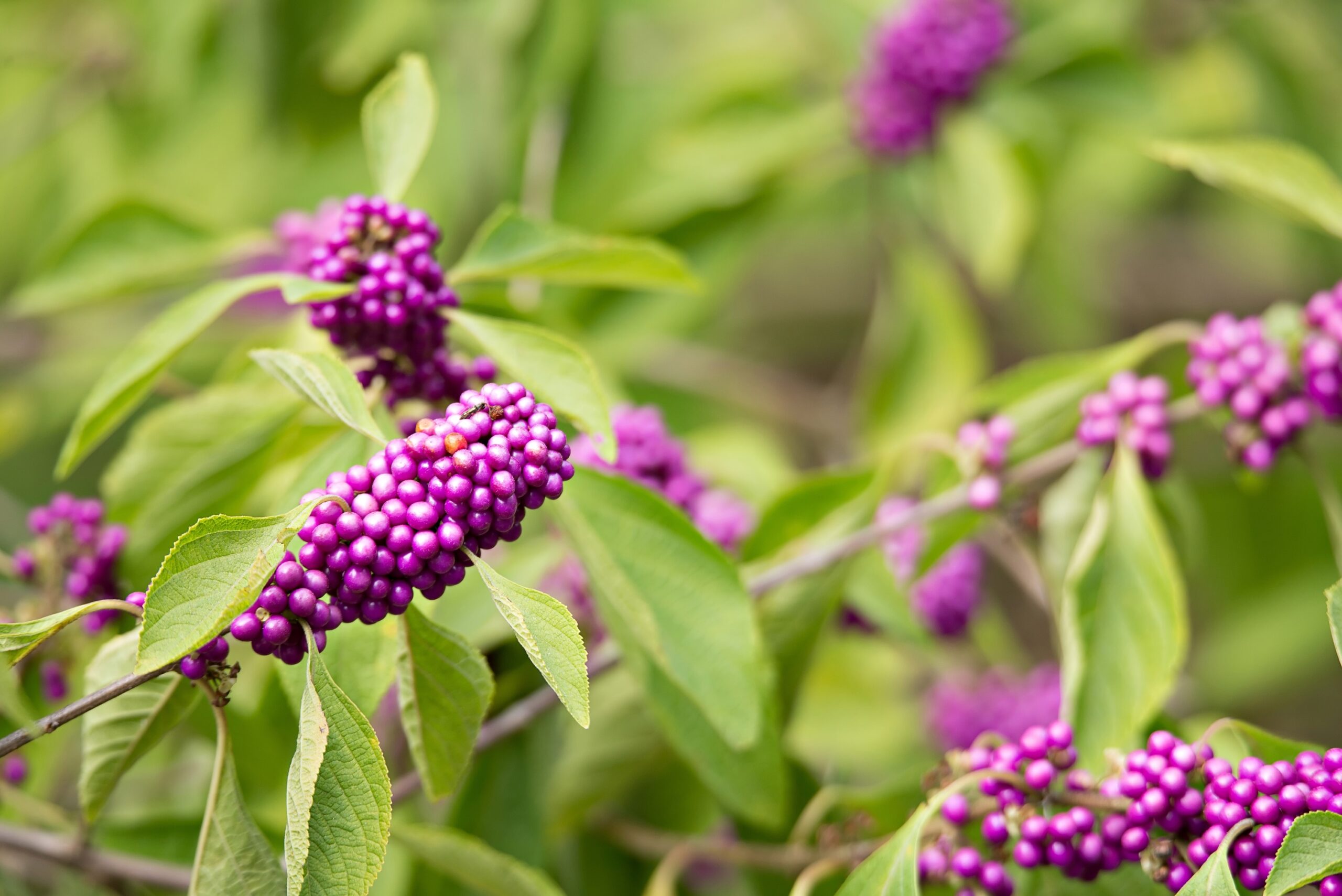
Boxwood (Buxus microphylla)
The boxwood is a slow-growing shrub with deep green foliage. You can easily prune the boxwood to provide an elegant appearance in your landscape, whether you want a box hedge appearance or prefer a more natural look. All Buxus species are deer resistant.
Gardening tip: This lovely plant may be grown in both full sun and mild shade.
Butterfly Milkweed (Asclepias tuberosa)
Butterfly Milkweed is one of 15 milkweed species identified in Missouri. This lovely species of milkweed got its name because it attracts butterflies, particularly the well-known monarch butterfly.
Gardening tip: It is vital to keep the soil well-drained but moist around your milkweed.
Fragrant Sumac (Rhus aromatica)
Only in appearance does this intriguing bush resemble poison ivy. However, it is entirely safe to touch!

Gardening tip: This resilient plant can withstand a lack of water, but you must plant fragrant sumac in full sunlight.
Hazelnut (Corylus)
Animals in the yard will like having this plant around. Many Missouri wildlife species feed on hazelnuts, so planting one will undoubtedly bring a variety of critters to your yard.
Gardening tip: Hazelnuts can be grown in moderate shade, but they prefer full sun. They perform best in settings of normal wetness.
Little bluestem (Schizachyrium scoparium)
Little bluestem can help you construct a prairie-style garden in your yard. This blue-green grass turns a magnificent reddish-brown in the fall and will remain robust throughout the winter for all of your yard creatures seeking shelter from the cold.
Gardening tip: This plant will thrive in almost any environment!
Ninebark (Physocarpus)
Ninebark is a beautiful ornamental shrub with white blooms that bloom from May to June. This shrub is a fantastic addition to your landscape and is particularly effective for erosion management.
Gardening tip: Ninebark requires a lot of sunlight and does not do well in the shade; however, it can easily tolerate various soil and moisture conditions!
Oakleaf hydrangea (Hydrangea quercifolia)
You really can’t go wrong with any cultivar of this species. You can use Oakleaf hydrangea alone or in a grouping. It’s a terrific four-season plant, and planting it in more sunny places of the garden improves the fall color. The tan-orange peeling bark has a lot of winter attractiveness.

Gardening tip: Plant this gorgeous plant in the fall to build a robust root system.
Palm Sedge (Carex muskingumensis)
This long, pointed bush stays green almost all year. The palm sedge is an excellent addition to a garden that requires a unique shape. And, if you’re wanting to add texture to your wildlife garden, this is one of the best native shrubs to add to your landscaping.
Gardening tip: It is excellent to grow in mild shade or direct sunlight.
Red Buckeye (Aesculus pavia)
In the spring, these plants will produce stunning red blossoms that will attract hummingbirds to your yard.
Gardening tip: Plant the Red Buckeye in rich, healthy soil and ideally in partial shade.
White Meadowsweet (Spirea alba)
White Meadowsweet is native to the damp soils of the Allegheny Mountains and other parts of eastern North America, but it is currently endangered in Missouri. This attractive shrub is an upright, deciduous shrub with alternating, narrow, serrated, green leaves that grows up to 4′ tall.
Gardening tip: This native shrub grows in full sun to part shade in average, medium to wet, well-drained soil, and prefers direct sunlight.
Let Down to Earth Services Help You Design Your Native Landscape
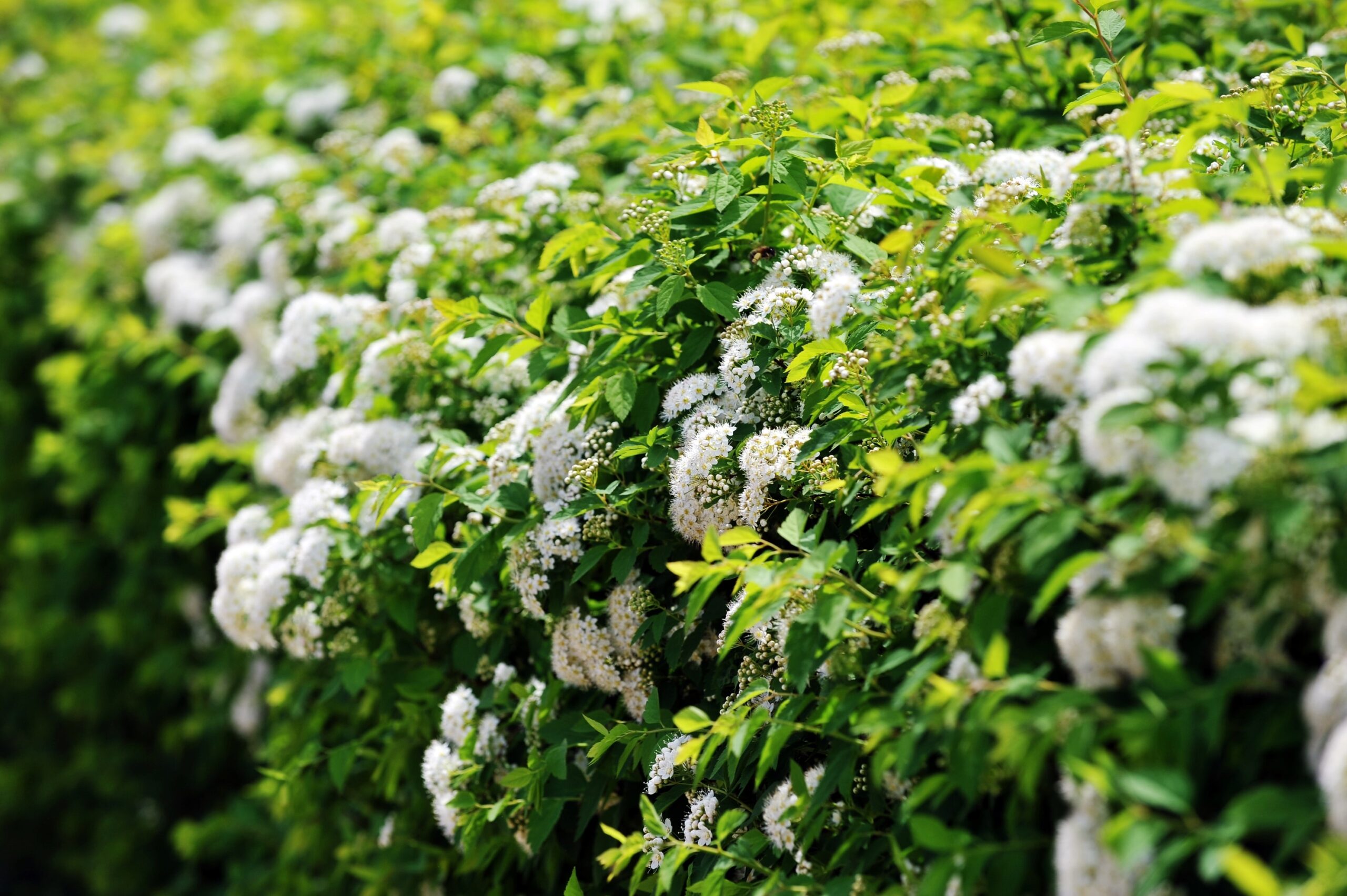
At Down to Earth Services, our team of skilled Missouri landscapers has years of expertise working with native plants in our state. We look forward to working with you to help ensure your native landscaping is well-maintained and offer advice on ensuring your native shrubs and flowers thrive. It is not difficult to go native; all it takes is a little know-how. So give us a call if you need assistance getting started with your native landscape!
A Guide to Kansas Native Flowers
Driving through Kansas can provide a fantastic feast for your eyes when Kansas native flowers are in bloom. You will enjoy the raw beauty of wild native flowers dancing in the fields with vivid flashing hues. Kansas offers many native flowering plants, trees, and grasses waiting for a passerby to explore. So, if you travel through Kansas, take some time to stop and stretch your legs to see the beautiful gifts Mother Nature provides. However, if you live in Kansas, you are fortunate because you get to enjoy the wildflowers all over the place, all the time.
Wind, water, and pollinators are responsible for spreading the seeds of native trees and wildflowers in the Kansas prairies. Kansas native plants are suited to the particular temperature and soil conditions in which they grow. These vital plant species offer nectar, pollen, and seeds that feed native butterflies, insects, birds, and other creatures. Common horticultural plants, unlike indigenous, do not give energy incentives for their visitors and frequently require insect pest management to live. Keep reading for more benefits of Kansas native plants landscaping and our favorite native plants and flowers here in the Midwest.
Benefits of Kansas Native Flowers
Native flora is also beneficial because:
- Native plants don’t need fertilizer and use fewer chemicals than lawns.
- Native plants use less water than lawns and aid in erosion prevention.
- Many native Midwestern plants have deep root systems that improve the soil’s capacity to hold water. As a result, native plants can significantly reduce water runoff from flooding.
- Native plants aid in the reduction of air pollution.
- Native landscapes do not require mowing.
- Excess carbon emitted by the combustion of fossil fuels contributes to global warming, and native plants absorb carbon from the atmosphere.
- Native plants offer animals both shelter and food.
- Native plants encourage biodiversity and environmental responsibility.
- Native flora are attractive and add to the aesthetic value of the area!

Native Plants of Kansas Sorted by Color
Wildflowers bloom in a kaleidoscope of brilliant colors during the year’s warmer months, from spring to fall. It’s a veritable rainbow:
Yellow Kansas Native Flowers:
If you love yellow, you are probably familiar with the beautiful Kansas native blooms such as Black-Eyed Susan (Rudbeckia hirta), Bladderpod (Peritoma arborea), Buttercup (Ranunculus bulbosus), Rigid Goldenrod (Solidago rigida), Gumweed (Grindelia squarrosa), Plains Coreopsis (Coreopsis tinctoria), Primrose (Primula vulgaris), and Downy Sunflowers (Helianthus mollis). You can spot these lovely blooms popping their heads up in fields across the state of Kansas.
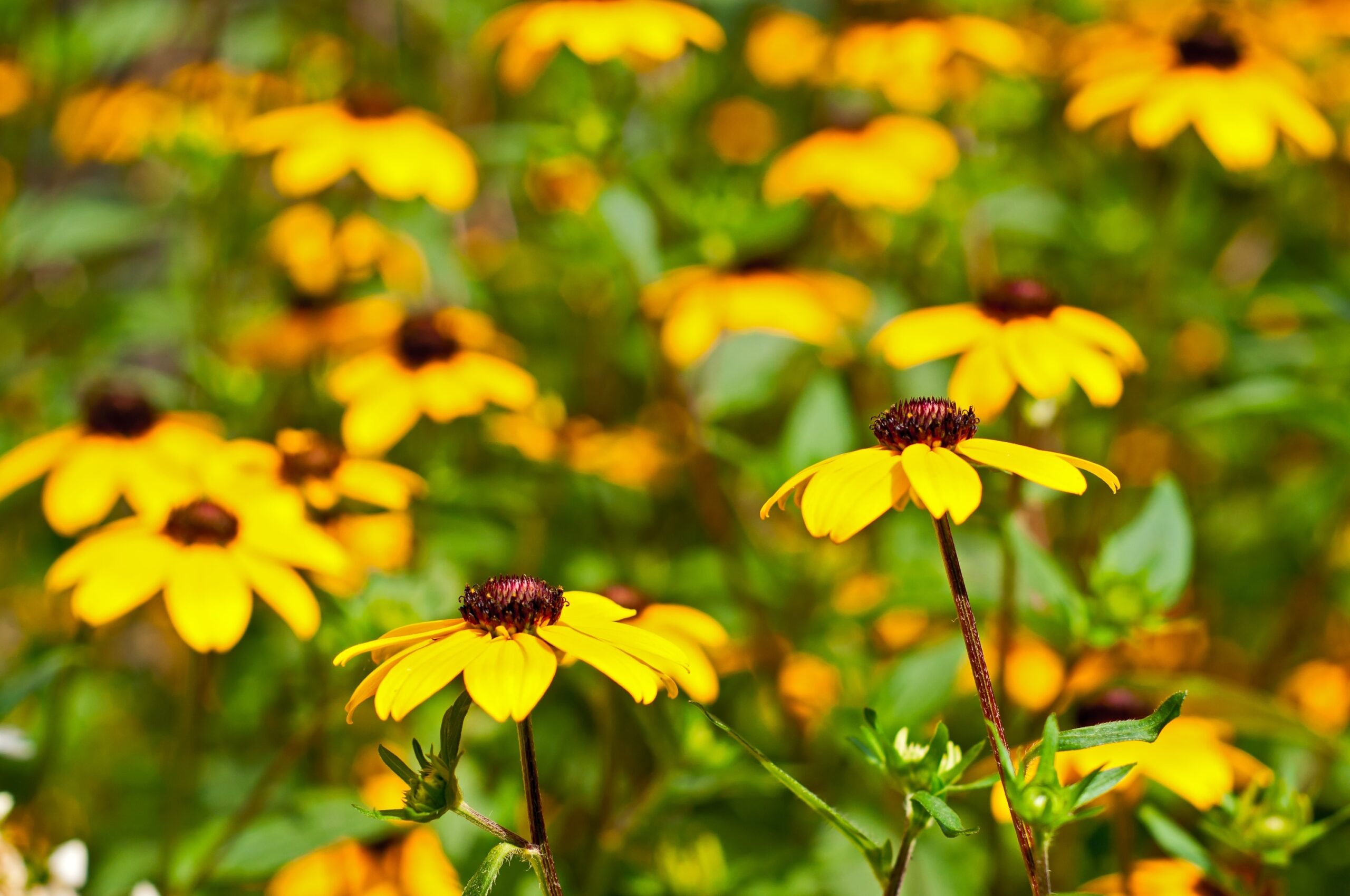
Orange, Pink, and Red Kansas Native Flowers:
If your choice of color leans toward the bright hues of orange, pink, and red, you may favor Blanket Flower (Gaillardia), Buffalo Gourd (Cucurbita foetidissima), Broad-leaved Purple Coneflower (Echinacea purpurea), Hollyhock (Alcea rosea), Indian Paintbrush (Castilleja coccinea), Prairie Wild Rose (Rosa arkansana), and Trumpet Vine (Campsis radicans).

Blue, Lavender, Lilac, and Purple Kansas Native Flowers
Likewise, if you prefer shades of blue, lavender, lilac, and purple, your choice of natives may include Chicory (Cichorium intybus), Downy Gentian (Gentiana puberulenta), Dwarf Larkspur (Delphinium tricorne), and Nightshade (Solanaceae).
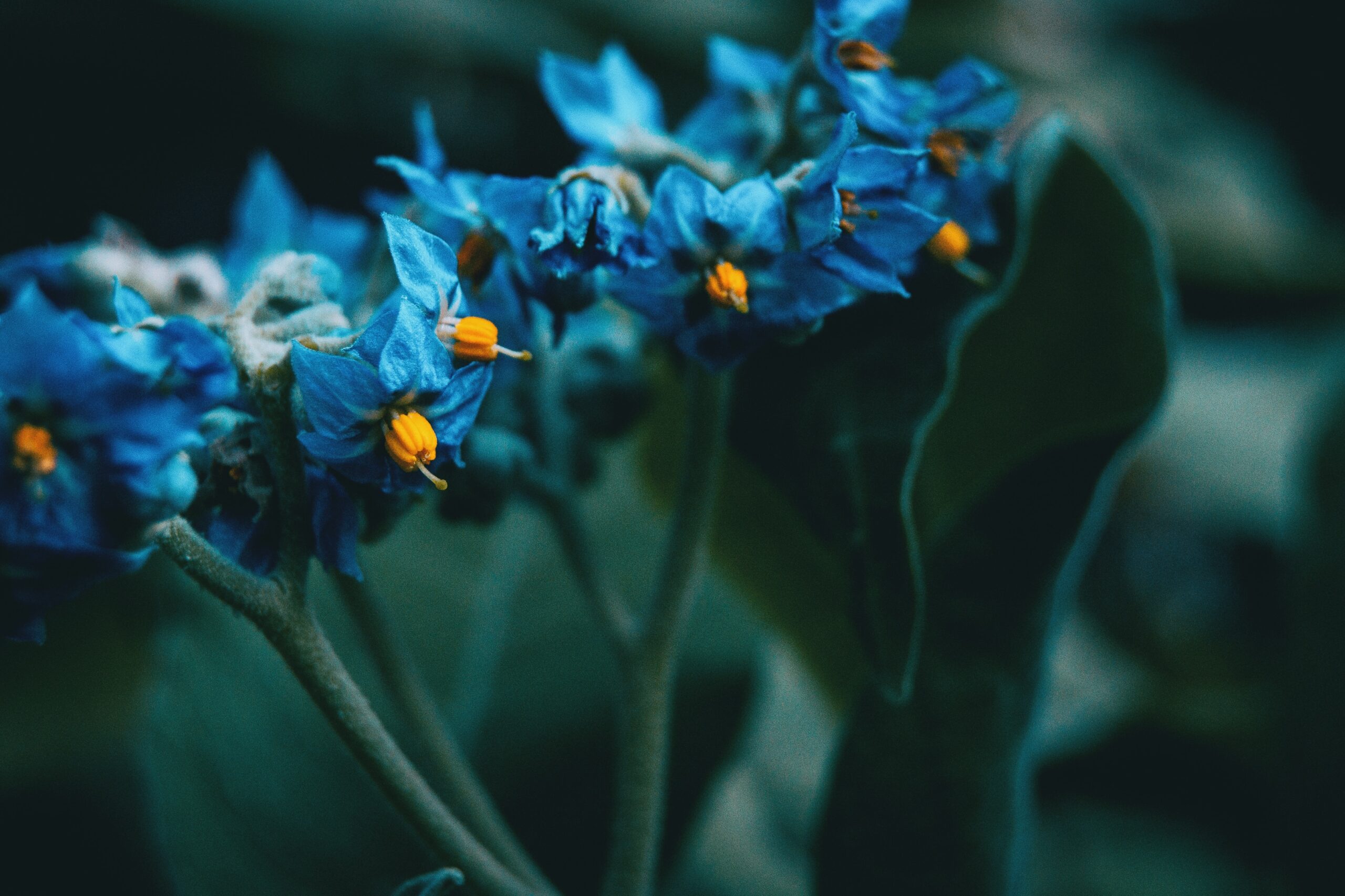
White and Ivory Kansas Native Flowers:
For people that love the clean and romantic look of white or ivory natives, Bloodroot (Sanguinaria canadensis), Daisies (Bellis perennis), Duck Potato (Sagittaria latifolia), Flowering dogwood (Cornus Florida), Jimsonweed (Datura stramonium), or Robin’s Plantain (Erigeron pulchellus), are beautiful examples of Kansas native and wild blooms.

Native Plant Gardens in Kansas
If you are ready to start your garden or introduce native blooms to your existing garden but are unsure what you want to include, consider visiting a natural garden in Kansas to experience the various native wildflowers. Below are a few of the beautiful botanical gardens you may want to visit:
- Sim Park in Wichita – Boasts 18 beautiful acres of native flowers, including 4,000 types of flowers.
- The Chaplin Nature Center – Includes 230 acres that are along the Arkansas River. The nature center includes prairies, beaches, and forest areas.
- Dillon Nature Center – The conservatory has 100 acres, including 200 plus types of flowers and plants.
We suggest you bring a notebook to document your favorites to include in your native oasis.

Native Plants of Kansas
Grass, mosses, rushes, sedges, shrubs, sedges, trees, and vines are just a few of the plants and wildflowers native to Kansas soils. These plants are abundant in gardens, woods, marshes, and prairies. In Kansas, the number of vascular plants is over 2,000. Vascular means they have leaves, stems, and roots. Vascular plants carry water and nutrients and reproduce through seedlings. Some vascular plants self-pollinate, whereas insects and wind pollinate others. In addition, Kansas includes one conifer species and around 200 bryophytes, or non-flowering plants that reproduce by spores. Bryophytes include things like moss, hornwort, and liverwort. There are also over 40 different fern species.
Planting In Kansas
Wildflowers abound throughout Kansas prairies and fields, adding color and fragrance to the landscape. For residents of Kansas, you already know that the state is blessed to have such a large number of native plants and blooms. If you plan to plant in the early fall, September is perfect for planting Alfalfa (Lucerne), and Downy Sunflowers (Helianthus mollis). You may also consider Broad-leaved Purple Coneflower (Echinacea purpurea), Partridge Pea (Chamaecrista fasciculata), Plains Coreopsis (Coreopsis tinctoria), or Purple Prairie Clover (Dalea purpurea). No matter what flowers you choose, we encourage everyone to consider native varieties.
Native Pollinators in Kansas
Pollinators are nearly as vital as the light, soil, and water in the reproduction of blooming plants and the production of most fruits and vegetables. According to the United States Department of Agriculture, pollinators are responsible for approximately 80% of blooming plants and over three-quarters of the crops that feed people. Ants, bees, beetles, birds, butterflies, flies, hummingbirds, and moths are pollinators. However, the number of these essential organisms is declining due to several reasons:
- habitat loss
- the introduction and spread of exotic plant species
- pesticide abuse
- illness
Therefore, the most important action we can do to help these species is to create a wildflower-rich habitat.

How Down to Earth Services Can Help
Creating a wildflower-rich habitat may seem overwhelming. However, with the wide variety of Kansas native flowers and plants, creating this type of habitat in your landscaping and garden is regenerative and beautiful. In addition, it leads to less work on your part. Down to Earth Services are the native plant specialists of Kansas and Missouri. We are here to help install, design, and manage your native plant garden. The first step is to give us a call. Then, visit our nursery right here in Kansas City to see all the beautiful Kansas native flowers available. We can’t wait to help you create a sustainable landscape right in your backyard.
Best Flowers to Plant in the Fall Native to Missouri and Kansas
Missouri gardens are in full bloom as summer reaches its peak and days become technically shorter. Gardeners are planning what flowers to plant in the fall and which native species to include. So, what is the fascination with native flowers? To begin with, native plants require little resources when seeded or planted. They are also abundant food sources for birds, butterflies, moths, insects, and other animals. Furthermore, native plants are vigorous and robust when properly planted and established. And, finally, they generally outperform other plants when nature throws unpredictable occurrences such as drought, floods, disease, and animals their way.
Thus, the following point is that native plants do not require as much fertilizer, disease management, or water as non-native plants. Thus, giving you time to focus on other areas of your flower or vegetable garden or just to relax and enjoy the view! Regardless of the landscape you are working with, you are sure to find the perfect native plants for your garden at Down to Earth Services. There are many intriguing options in leaf, shape, or bloom, whether dry or damp, shaded or sunny, tiny or vast.
Reasons to Plant in the Fall:
- Plants will put on new root development while the earth is still warm before going dormant.
- Because the temperatures are lower, plants require less water.
- Plants will enjoy two seasons of cold weather (fall and spring) before being subjected to scorching summer weather.
- Because they are not as susceptible to heat or drought, the plant devotes its energy to root development.
- Because the temperatures are lower, you don’t need to water as much.
- It’s a beautiful time of year to be outside, and you won’t break a sweat digging your holes.
- Fall planting makes spring upkeep easier. If you’ve finished your planting, all you’ll have to do in the spring is weed and tweak.
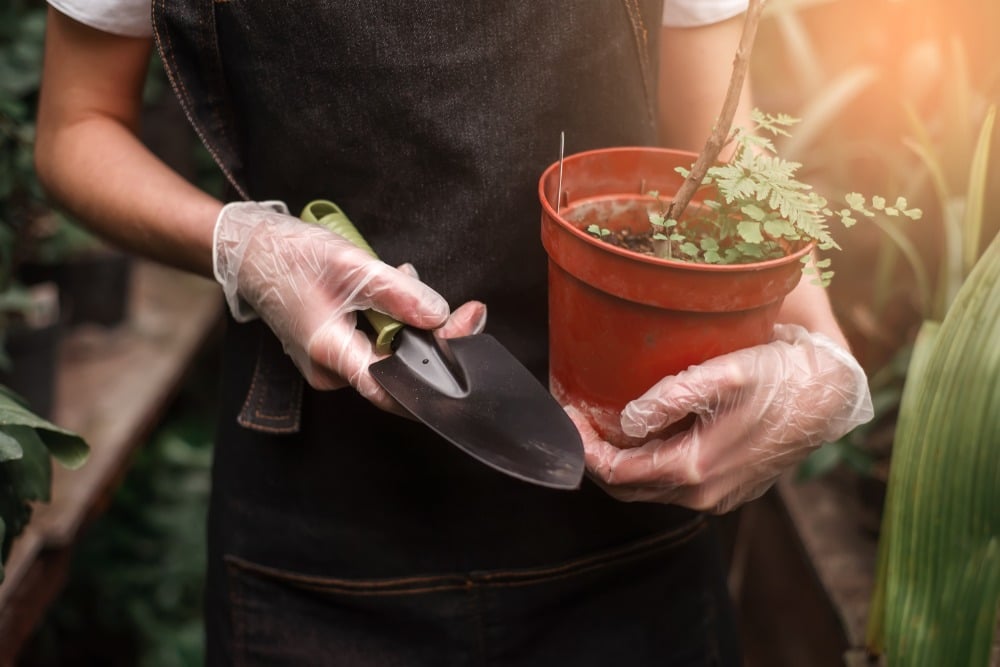
Make your fall garden stand out by including favorite late summer and fall flowering native perennials and incorporating vibrant colors, lovely blooms, and nectar for pollinators.
List of Fall Blooming Perennials
- Helianthus maximiliani (Santa Fe’ Sunflower)
- The color ‘Perfect Pink’ Phlox (Phlox nana var. nana var. nana var. nana var. nana)
- ‘Shimmer’ Evening Primrose (Oenothera fremontii)
- Maraschino Bush Sage (Salvia hybrid) is one of the best flowers to plant in the fall in zones six and above
- Autumn sage (Salvia greggii) in zones six and above
- Sage of the Prairie (Salvia azurea)
- Bee Balm (Monarda species)
- Skullcap hybrid ‘Dark Violet’ (Scutellaria’ Dark Violet’)
- Aster ericoides (First Snow)
- Goldenrod (Solidago)
- Hummingbird Trumpet (Zauschneria garrettii)
- Hummingbird Mint ‘Ava’ (Agastache hybrid)

Vines and shrubs
- Vine of Honeysuckle (Lonicera sempervirens)
- Rabbit Brush with Silver Leaf (Chrysothamnus nauseosus)
- Privet of New Mexico (Forestiera neomexicana)
Grasses for Decoration
- Blue Grama Grass (Bouteloua gracilis)
More on the Best Flowers to Plant in the Fall
Native flowers that bloom in the fall begin to bloom when kids are heading back to school. Autumn Phlox, Trumpet Honeysuckle, and Ox-eye Daisies bloom into the peak season of autumn, while Liatris, Coreopsis, and Monarda (Bee Balm) fade. Asters, Black-eyed Susans, Echinacea, and Rudbeckia, are all in bloom.

The Missouri Ironweed
The Goldenrods bloom, as does Vernonia missurica, also known as Missouri Ironweed. Down to Earth Services sells this lovely native, which grows to a height of around 3′ to 5’ feet. This species has distinguishing characteristics from other ironweed plants, such as the more significant number of disc florets on each flower and the hairy leaves and stem. Aside from the exceptionally unique and beautiful blooms of the Missouri Ironweed, it is also a favorite of many butterfly species. In the fall, the seed heads become a rusty color, thus the popular name. In the winter, the seed heads become a food source for birds.
Common Sneezeweed
Helenium autumnale, often known as Common sneezeweed, is another beautiful fall bloom. Beyond the clear orange-yellow of the straight species, there are brighter colors, including lovely oranges, red, and yellow.
Turtlehead
Finally, Turtlehead or Chelone glabra is a late-arriving bloom that ranges from white to pink and has dark green leaves. The Chelone glabra does very well when planted in the shade, and as long as it has adequate water, it can also withstand sunny areas.

Purple Love Grass
Eragrostis spectabilis, which is also known as Purple Love Grass, is another lovely fall-blooming native. You will often see it along the side of the road, and it makes a beautiful addition to any native-inspired garden.
More Indigenous Plants for Fall
Besides the vibrant colors of natives, the Missouri gardener may choose from a broad range of indigenous plants with intriguing foliage textures. For example, the Amsonia (Blue Star Plant), Hydrangea quercifolia, Rubus odoratus (Flowering Raspberry), and Oakleaf Hydrangea boast a coarse texture and broad leaves. These plants require adequate space and do well in mild to partial shade.
The magnificent orange, red, and purple of the Oakleaf Hydrangea prolong its seasonal appeal and contrast with the Flowering Raspberry, which has lovely blooms of lemon yellow. Additionally, Lindera benzoin (Spicebush), Amsonia tabernaemontana (Bluestar), and Clethra alnifolia (Sweet Pepperbush) will enhance your fall color palette with beautiful hues of yellow.
Fall Planting Tips
Digging in the earth can be very soothing. Don’t let the chill in the air in fall deter you because fall is the perfect season to work on your landscape. The earth continues to be warm enough for root development on a variety of native plants. Below are a few planting and maintenance tips for caring for low-maintenance fall plants.
- Choose your plants wisely. Just because they are the biggest does not mean they are the best. Large or overgrown plants can be root-bound, which you would want to try and avoid.
- When purchasing plants from a store, look at the pots they are in to see if they have tiny ridges to help train the roots to grow down instead of in a circular pattern that can strangle the plant.
- Choose a location to plant your natives based on the requirements of the natives you have chosen. Make sure that they have plenty of space to grow as well. Be sure to include organic matter to give the soil a boost of nutrition.
- Be sure that the plant’s stem is at the same level as the container before planting. Another suggestion is to create a saucer shape around the plant to direct rainwater. Finally, to retain soil moisture, add some good coarse, woody mulch – making sure it is not near the plant’s stem as it can promote rotting.
- A last watering will ensure that the roots have good contact with the soil.
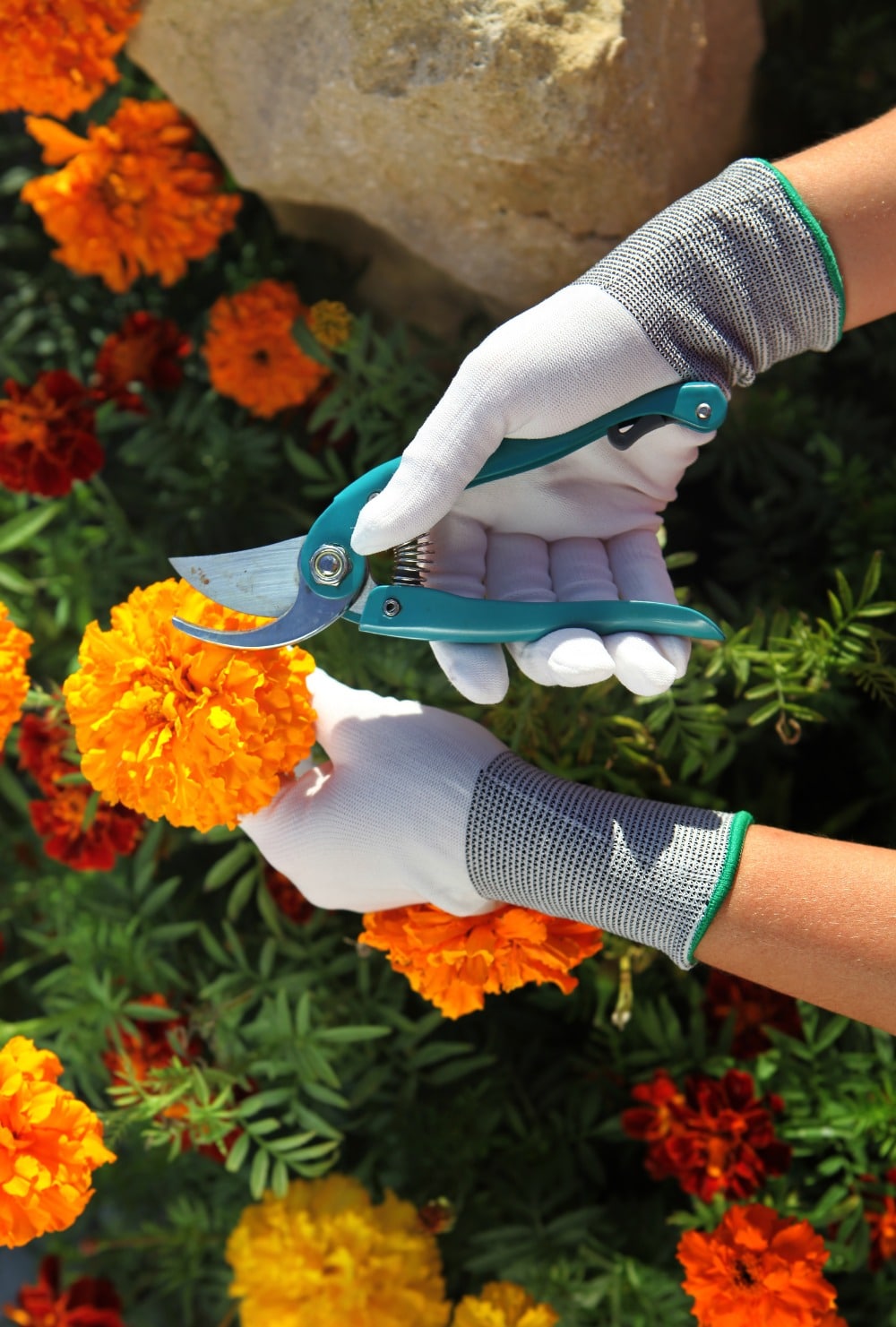
In Conclusion
After reading the above article, we hope you have more information on the best flowers to plant in the fall, why fall perennials are successful, and tips on planting in the upcoming season. Whether you’re looking for natives that perform best in sunny or shady areas, large or small plants, blooming color, or leaf color, edible, or wildlife-friendly, you are sure to find the perfect natives for your garden at Down to Earth Services.
Down to Earth Services are the native plant specialists of Kansas and Missouri. We install, design, and manage native plant gardens for commercial and residential clients. Not to mention, our native plant nursery is filled with the best flowers to plant in the fall, along with so much more. Visit our website to learn more about what we can do for you!
The Best Perennials for Pollinators
Pollinators are nearly as vital in blooming plant reproduction and the development of most fruits and vegetables as the light, soil, and water. According to the USDA, animal pollinators are responsible for around 80% of all blooming plants and more than three-quarters of the primary agricultural plants that feed humanity. Ants, bees, beetles, butterflies, flies, birds, hummingbirds, and moths are primary animal pollinators. However, pollinator numbers are declining due to various factors, including habitat degradation, the introduction and spread of exotic plant species, pesticide abuse, and illness. The most important step you can do to help these important pollinators is to provide wildflower-rich habitat. In this article, we will go over some of the best perennials for pollinators.
What Can You Do to Protect Pollinators?
- Plant native flowering plants – Native wildflowers, shrubs, and trees are typically the finest providers of nectar and pollen for native pollinators since they thrive in local soils and climates. Furthermore, most native plants require minimal water, blossom without fertilizer, and are unlikely to grow weedy.
- Plant perennials in the sun – Your pollinator-friendly plants should have direct sunlight for most of the day, primarily because adult butterflies eat solely in the sunlight.
- Plant flowering perennials that are long-lasting – The most successful perennials for pollinating are long-lasting blooms. Long-lasting blooms help sustain pollinators throughout the seasons. Be sure to plant various flowers with different blooming cycles during the year, which will provide pollinators, nectar, and pollen supplies throughout the growing season.
- Plant in clusters – Clumps of flowering plants attract more pollinators than solitary plants spread over the area.

- Do not use insecticides – Insecticides can be harmful and even kill pollinators. Our native plant experts recommend using eco-friendly methods. For instance, try solutions on your plants and skip the insecticides.
Perennials for Pollinators Native to Missouri
There are many perennials native to Missouri that attract pollinators. Below are a few of our favorite perennial plants for bees and butterflies and more that work beautifully in almost any garden.
Pussytoes (Antennaria neglecta)
Antennaria neglecta, also known as pussytoes, is a lovely plant that grows well as a ground cover in full sun and medium to dry, well-drained soil. Additionally, it tolerates partial shade as well as clay soils with adequate drainage. Tufted white flower clusters emerge from mid to late spring and last approximately three weeks. Small bees, as well as syrphid and tachinid flies, collect pollen from the blooms. Furthermore, caterpillars of the American Painted Lady butterfly consume the leaves.
Devils Walking Stick (Aralia spinosa)
The Aralia Spinosa or devil’s walking stick is a large shrub with spiky stems and spreading behavior that should not deter adventurous gardeners looking to attract pollinators. Large clusters of fragrant, white flowers bloom in the middle to late summer and last for many weeks. Bees of all types enjoy the flowers because they provide pollen and nectar. During full bloom, it is not uncommon to see clouds of flying insects around the flowers. The limbs of the fruiting inflorescence become pinkish-red when the flowers fade, adding aesthetic appeal. Songbirds that migrate in the fall eat the clusters of dark purplish black berries that grow on the plant.

Stiff Leaved Aster (Ionactis linariifolius)
Purple to blue-violet to blooms with yellow disks bloom early to mid-fall on the Ionactis linariifolius and last approximately a month. Pollen and nectar are collected by various insects, including bees, flies, butterflies, skippers, and beetles, from the stiff-leaved aster. Furthermore, the leaves of this plant are a food source for the Silvery Checkerspot and Pearl Crescent butterfly larvae. Full light and acidic, well-drained soils are suitable for growth.
Purple Coneflower (Echinacea purpurea)
The purple coneflower, also known as Echinacea purpurea, is a long-blooming ornamental that tolerates a wide variety of growth conditions, making it one of the top part sun perennials for pollinators. Many insect species, including bees, butterflies, and beetles, are drawn to the blooms. Tiny crab spiders often hide on coneflowers, preparing to ambush their victims. The flowers are frequently somewhat scented. Finches are very fond of the seeds they gather in the summer, fall, and winter.

Tall boneset (Eupatorium altissimum)
Gardeners typically overlook this versatile perennial, which thrives in full sun to partial shade and mild to dry soils. The Eupatorium altissimum or Tall boneset can withstand drought as well as clay soils with a high pH. Its numerous tiny, white blooms bloom from late summer to early fall and persist for four to six weeks. Many insects, including bees, wasps, flies, butterflies, plant bugs, and beetles, are drawn to the nectar. Though it is difficult to get in the nursery trade, it is simple to cultivate from seed and makes an excellent pollinator in informal, “wild” gardens.
Common boneset (Eupatorium perfoliatum)
The Eupatorium perfoliatum or common boneset is a perennial wildflower that blooms in late summer to early fall, spreading clusters of fragrant white flowers, lasting only a month. Many pollinators, including bees, butterflies, flies, wasps, and beetles, are drawn to nectar or pollen. In addition, the common boneset is tolerant of flood conditions for short periods, making it the perfect choice for a rain garden.
Wild Bergamot (Monarda fistulosa)
Wild Bergamot or Monarda fistulosa blooms in mid-summer with flowers lasting approximately a month. Bees, butterflies, and ruby-throated hummingbirds are particularly fond of its nectar. Furthermore, caterpillars of numerous moth species graze on the leaves. Other Missouri native monardas that attract pollinators include spotted bee balm (Monarda punctata) and Eastern bee balm (Monarda sylvestris) (Monarda bradburiana).

Ninebark (Physocarpus opulifolius)
White or pink blossoms are the signature color for the ninebark or Physocarpus opulifolius, which blooms in May or June and last for around 2 to 3 weeks. Many pollinators such as bees, butterflies, flies, and wasps, consume the nectar or pollen of these lovely flowers.
Cup Plant (Silphium perfoliatum)
The cup plant or Silphium perfoliatum is not for every garden. Still, for gardeners that plant specifically with pollinators in mind, this perennial for pollinators is an excellent food source for the many different bees, flies, butterflies, and wasps. Furthermore, a variety of birds, notably finches, consume the seeds of this unique plant. Birds frequently drink or bathe in the water that pools in the cup-shaped leaves following rainfall. You can cut the stems of this plant after the first hard frost to use for mason bee hotels.
New England Aster (Symphyotrichum novae-angliae)
New England aster blooms, or Symphyotrichum novae-angilae, are an excellent source of nectar for the Monarch butterfly. In addition, the lovely rose-colored blooms provide nectar or pollen to many other butterfly and bee species. Best grown in full sun, this hearty perennial is very low maintenance and one of the best plants for pollinators.
Aromatic Aster (Symphyotrichum oblongifolium)
Nectar from fragrant Symphyotrichum oblongifolium blooms, commonly known as aromatic aster, is an essential late-season source of food for various pollinators, including butterflies and bees.
Additional Native Pollinator Plants
Below are some additional native pollinator plants that are an excellent food source for pollinators that we carry at Down to Earth Services.
- Lead Plant (Amorpha canescens)
- Swamp Milkweed (Asclepias incarnata)
- Cream Wild Indigo (Baptisia bracteata)
- Button Bush (Cephalanthus occidentalis)
- Purple Prairie Clover (Dalea purpurea)
- Pale Purple Coneflower (Echinacea pallida)
- Rattlesnake Master (Eryngium yuccifolium)
- Wild geranium (Geranium maculatum)
- Prairie Blazing Star (Liatris pycnostachya)
- Foxglove Beardtongue (Penstemon digitalis)
- Showy Goldenrod (Solidago speciosa)
- Smooth Blue Aster (Symphyotrichum laeve)
- Missouri Ironweed (Veronia missurica)
- Golden Alexanders (Zizia aurea)

The DTEKC Promise
At Down to Earth Services, we are passionate about what we do. As Missouri native plant experts, we know what will work best for your landscape and will work with you on your project to get the best possible results for the design, installation, and maintenance of your native garden. We especially love perennials for pollinators because they provide a rich food source for bees, butterflies, various insects, and birds. For more information on our offerings, contact Down to Earth Services today to schedule a consultation!
Maintenance Tips For Your Missouri Native Garden
Generally speaking, native gardens are pretty easy to take care of and require minimal maintenance. Because they are low maintenance and provide a magnificent focal point, many homeowners opt for native gardens. Since they are so easy to maintain and care for, they are ideal for beginners to novices and everyone in between. Native plants are also ideal for the elderly as they require minimal maintenance and care. They make a lovely addition to any yard or flower bed and can add to curb appeal. Here are some easy-to-follow tips and guidelines from the experts at Down to Earth Services on how to tend your garden and keep it looking lovely all year long.
Top Maintenance Tips
Start Small
Everyone dreams of that lovely garden that they see on the cover of a magazine. It is important to remember that these gardens didn’t start this way. Most of them took years to obtain what you see in the magazine pictures. So, before starting, consider what the ultimate goal is and how to achieve that goal. The most luxurious outside oasis won’t happen overnight. However, with patience, planning, and due diligence, it is entirely possible to have that magazine picture-worthy garden.
Choose plants that will return year after year for the best results. Additionally, it is wise to select plants for your Missouri native garden specific to your region. The region you are in will dictate which plants will flourish. Questions you may consider for your area are how much rain do you get? Is the soil sandy or rocky? Are there a lot of birds or butterflies in the area? By determining the little details, you can design a beautiful garden that gets more beautiful year after year.
Start with a few plants and gradually add in more plants as required to fill in the area. Most plants will slowly fill in space, establishing a beautiful native garden at an affordable price.
Watering Your Native Garden
Most gardens of this nature require minimal water once the plants are well established. The majority of the native plants only require watering weekly or as the soil dries out. Avoid plants that require excessive amounts of water unless there is ample water available.
Focus on specific designs, styles, and colors to create a lovely native look without overdoing it. As a result, native gardens look like they’ve always been there and require minimal work and effort once they’re well established.
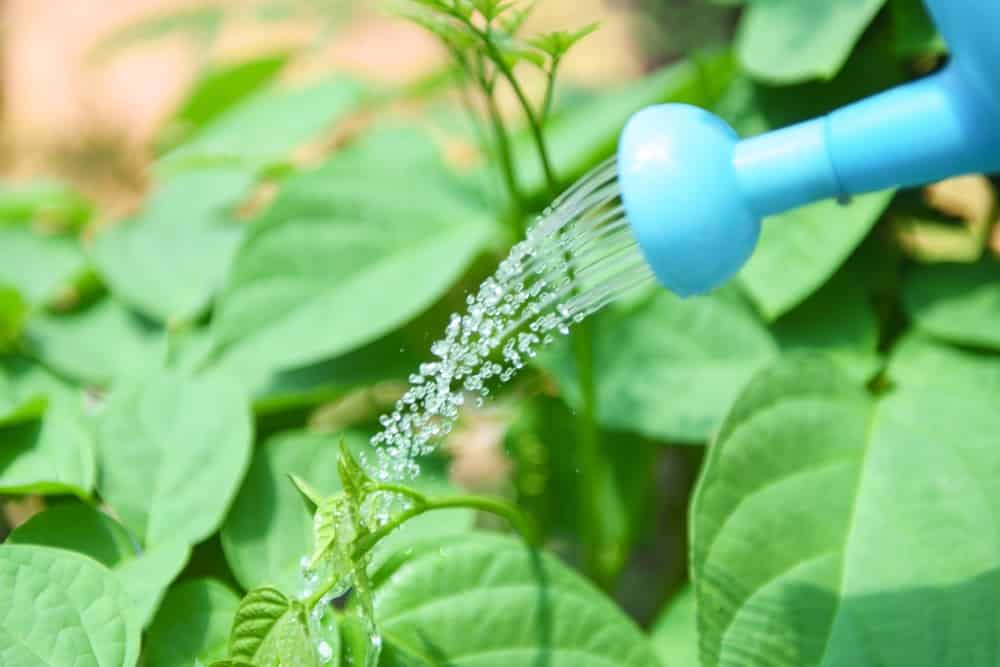
Weeding
In the first several months, your native garden will require more weeding. Weeding your garden allows the plants to spread out and grow and help to choke out the weeds in the future. As labor-intensive as this sounds, the process is quick and easy if you weed as you go.
Keep in mind that some weeds are decorative, and many gardeners choose to embrace them as part of the landscaping. But, on the other hand, some weeds can choke out the beautiful native plants you are using as the main focal points of the garden. So, it’s best to make sure you do your research and contact Down to Earth Services for more advice and tips. Also, keep in mind that one person’s weeds may be ornamental plants for another person.
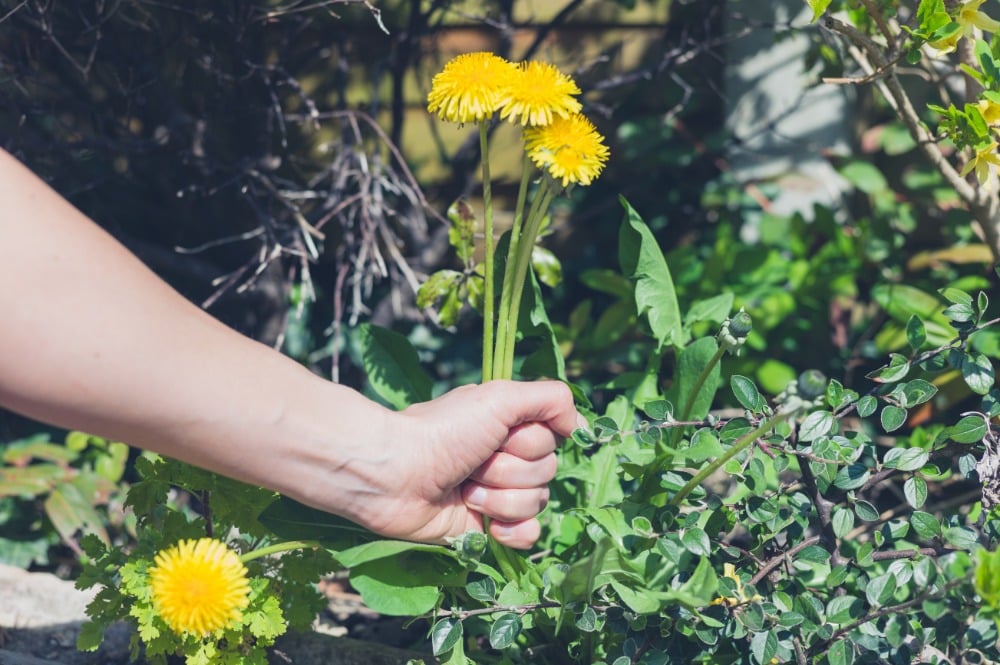
Pruning and Trimming
You can readily train many plants to grow upwards or onto fences, trellises, or other structures. Climbing plants can lend a lovely appearance to any garden. By proper pruning, trimming, and training, many plants can be “taught” to grow where they will add to the garden’s look.
Focus on a good mix of native plants. For example, you can use tall grasses and flowers native to the region for the fill-in areas. Instead of filling everything in at once, allow the garden to grow and take over the place naturally over several years.
Don’t be afraid to dig up some of the flowers and relocate them to another area to help fill in an open space. Consider the garden’s overall appearance as well as your goal. Then, train and prune the plants to meet those goals.
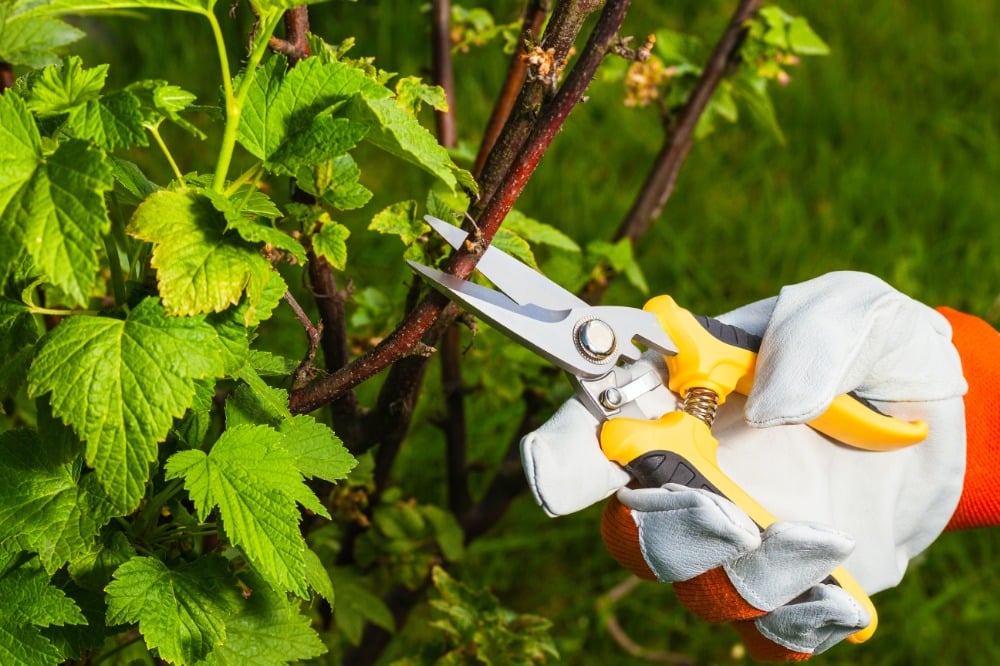
Composting, Feeding, And Mulching
By utilizing compost and mulching, many plants won’t require feeding. If desired or if feeding is needed, use a gentle fertilizer that is all-natural to encourage more growth from the native plants. Keep in mind that many fertilizers for native plants are used at half strength and won’t have full strength to help the plants grow. Native plants prefer a blood or bone meal-type fertilizer and good old-fashioned manure that has been allowed to sit and “ripen” for a few years.
Don’t forget to use a mulch to help the plants retain their moisture and nutrients. A wide variety of mulches can be used or consider utilizing what is already on hand. Wood chips or rocks are known to encourage plants to retain their moisture and nutrients.
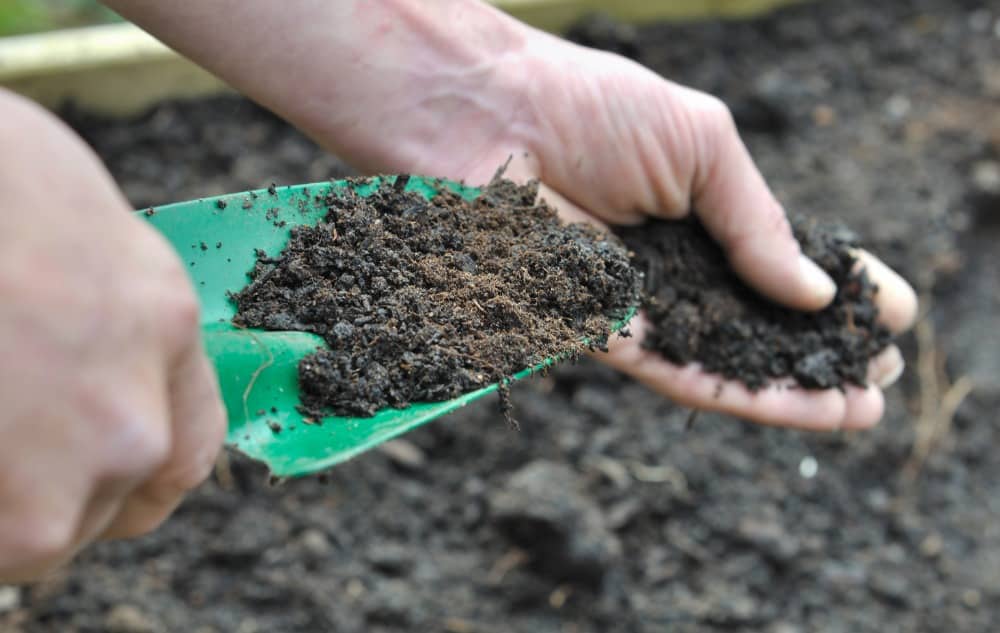
Protection Against Insects and Fungus
There are a variety of ways to protect native plants against insects and fungus. Consider all-natural ways such as broken eggshells to help repel slugs and snails from tender young plants. They won’t want to crawl over the broken shells to access tender young plants as the shells will cut them to bits. Mild dish soap solutions may also help to repel bugs and some funguses as well. Most native plants are adapted to the region and will require minimal protection against fungus or insects.

Final Thoughts on Maintaining a Missouri Native Garden
Native gardens are a delightful way to enjoy a garden. By focusing on local, regional plantings, it’s easy to accomplish the goal of a lovely native garden look. Patience, plenty of water, and weeding during the first year will do wonders to help the garden flourish year after year. Down to Earth Services recommends all-natural remedies for plants that are prone to other types of fungus. Fungicides that are natural and mild will help retain the all-natural look of your native garden. For more tips, advice, and native plant services, contact Down to Earth Services today! We are your native plant specialists in Kansas City and the surrounding areas.
Environmental Landscaping Design For Sustainable Natural Beauty
If you are interested in improving the landscaping around your home, consider environmental landscaping. Using sustainable landscaping can help improve the appearance of your property and simultaneously help the environment around you. This is becoming more common in areas where water shortages are more common or where rainfall is not frequent. Despite the lack of precipitation or a wide variety of plants to use, you can still create an outstanding landscape in the front and back of your home. Here is an overview of what environmental landscaping is and how to achieve sustainable landscaping. Get ready to create natural and sustainable beauty on your property, and don’t forget to call the native plant experts of Missouri and Kansas, Down to Earth Services, for help and guidance throughout the entire process.
What Is Sustainable Landscaping?
Although there are many different ways to define sustainable landscaping, it is often referred to as a way of using natural resources conservatively. Sustainable landscaping can help local wildlife, improve air quality, water quality, and conserve energy in your local area. In contrast to traditional landscaping practices, which often involve using plants that require a substantial amount of water, this is quite different. The use of these plants, despite their ornamental value, will not require many natural resources to keep them healthy and vibrant.
How to Start Your Sustainable Landscaping
The first thing that you should do is evaluate all of the natural resources you have at your disposal right now. By looking outside, you can see what types of plants are currently thriving, regardless of the climate you are in. You will need to assess all of them, not only based upon their beauty but the amount of attention and time that they will require. One of the benefits of creating a landscape in this manner is that it can save you hundreds of hours a year while simultaneously saving money by simply using plants that are much easier to maintain.
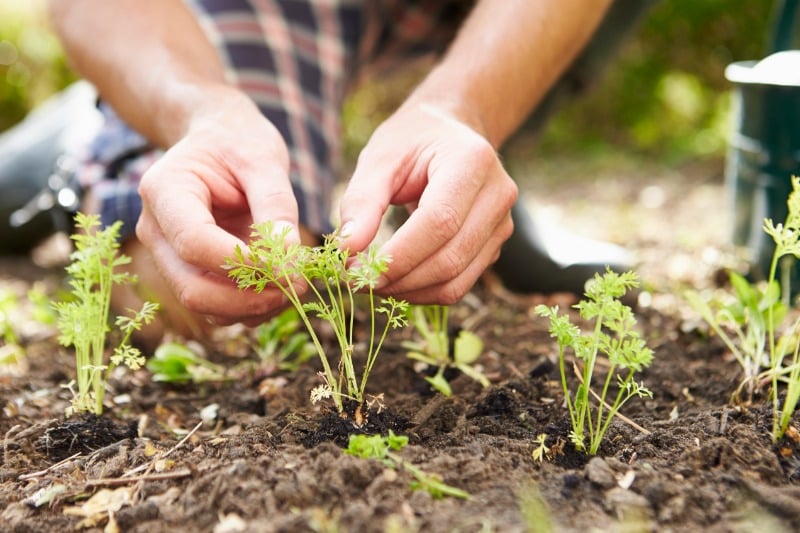
Create A Plan of Action
Your plan of action for environmental landscaping will consist of three separate parts. First of all, you need to define the areas on your property where you would like to improve its outward appearance. Second, consider where you spend most of your time, whether outside on the patio, your porch, or simply spending time in the backyard area. Will you have a garden? Perhaps you are going to plant a small orchard that will soon have many different types of fruit. By making these final considerations, you can then design the schematic for how your sustainable landscaping project will look.
Do One Project at A Time
Once you have your plan, you will want to start taking action. You may want to begin planting shrubs in certain areas or perennials that will help improve the appearance of your landscape. Try to choose environmentally friendly plants and replace invasive plants that will cause problems year after year. By starting small, you can begin to see the layout that you have envisioned coming to fruition. Most people will start with shrubs and perennials, but they may also want to plant a few trees.
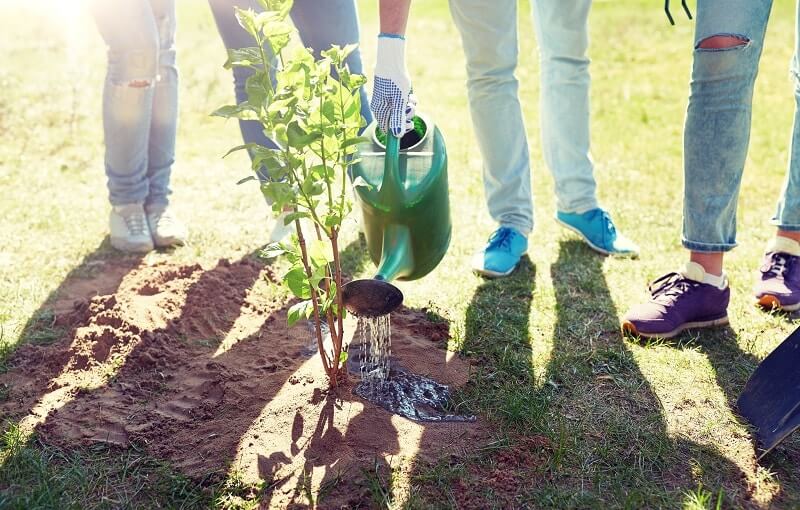
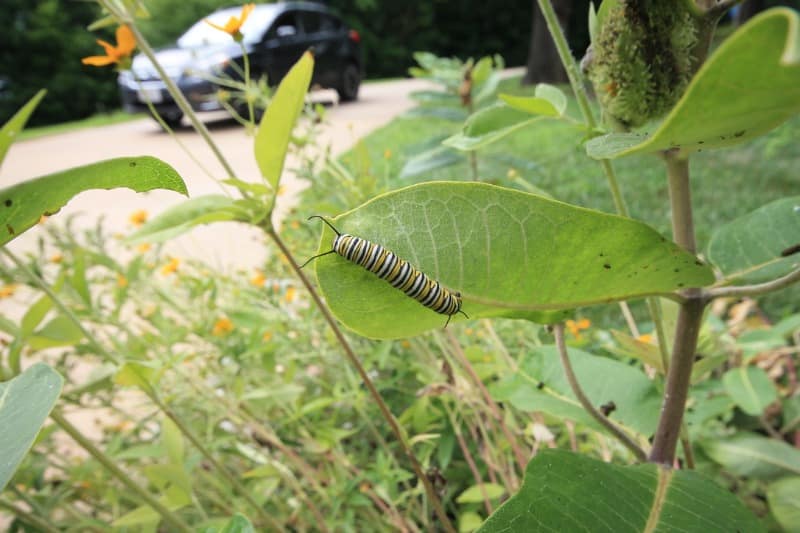
Over the years, as the trees get larger, this can provide shelter for many different animals, including mammals and birds. You can create a microclimate of your very own if you do this properly. At the same time, you will minimize the amount of work that you will have to do to maintain your landscaping by thinking from an environmentally oriented perspective.
Always Think in Odd Numbers
As you are going through this process, you will soon notice that odd numbers are of great benefit. For example, if you are planting perennials, shrubs, and trees, try to do so in odd numbers. Doing so will allow you to start planting in repeating patterns which will help maintain continuity and uniformity throughout your landscape.
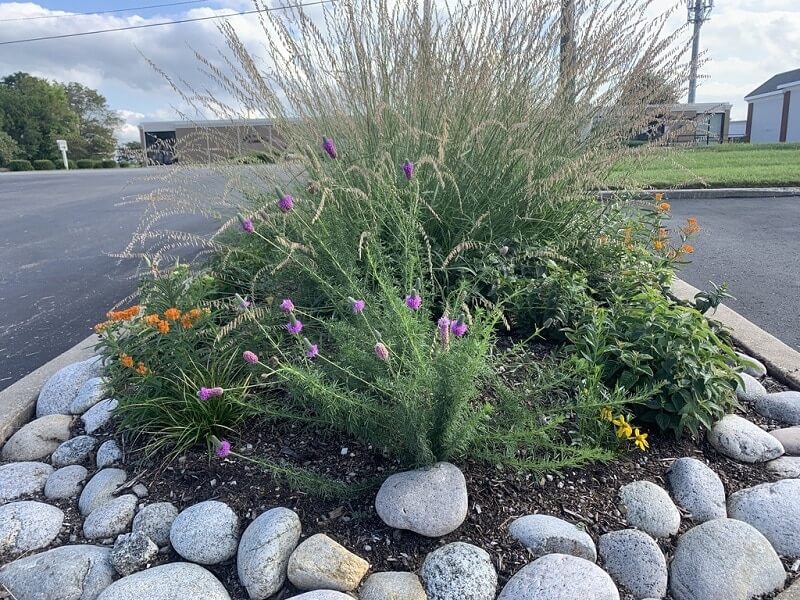
Choose Your Plants Wisely
As you are doing this, you may find research on different plants that you should avoid. In certain areas, plants including Burning Bush, English Ivy, and even the quite common periwinkle can be problematic over time. These are very invasive plants, and they can wreak havoc on your landscaping as they begin to grow, multiply, and spread widely throughout your property. Also, avoid using anything with shallow roots, such as Leyland Cypresses, which will not do well in areas with high winds because of their shallow roots. Finally, always consider how much sunlight these plants will require, and the soil’s pH level must be for optimal growth. By making sure that you are planting things that can balance nitrogen, phosphorus, and potassium levels in the soil, you will be able to sustain your landscaping indefinitely by having this type of balance.
Always Be Cognizant Of Water Usage
The final thing to consider is the use of drought-tolerant landscaping processes, also referred to as xeriscaping. Although this would not be prevalent or even necessary in wetland regions, it is certainly something to consider if you live in a predominantly dry region. Xeriscaping will not only help you conserve water usage but can also reduce utility bills, which can be high on properties that are heavily landscaped. You could also go green by collecting rainwater runoff. You can use the rainwater you collect and store it in barrels as it is needed.
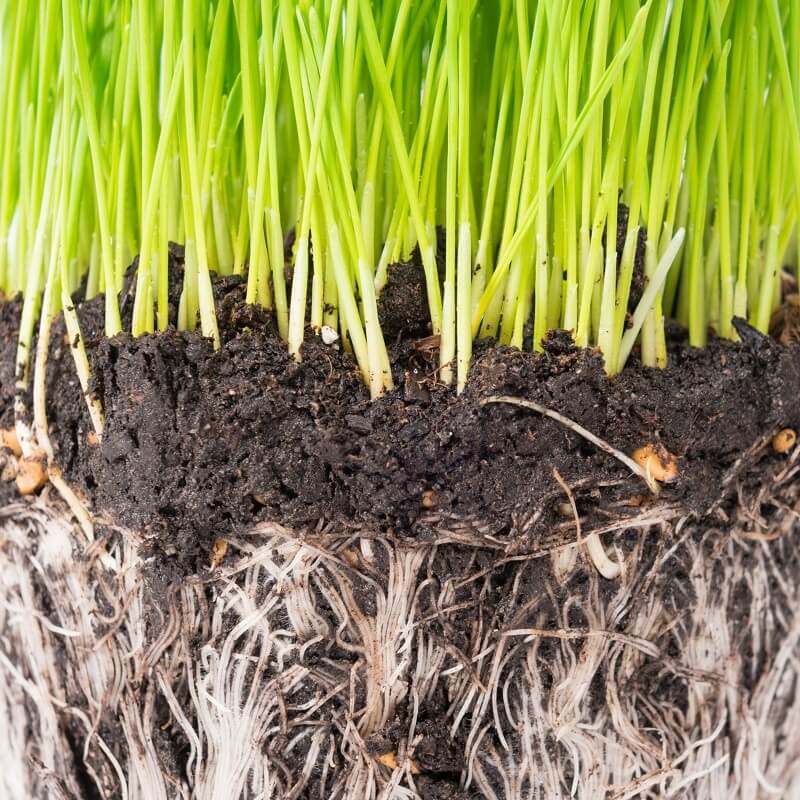
Environmental landscaping designs are becoming much more popular. As the population continues to grow and as the environment continues to change, it is important to also change the way we do landscaping. At the very least, you will create something brand-new, utilizing natural flora and fauna, and become more environmentally conscious. The end result will be beautiful earth-friendly landscaping by using these simple ideas for creating sustainable natural beauty. Get in touch with Down to Earth Services to get started with environmental landscaping design today!
10 Medicinal Plants to Grow in Your Garden
Not only are plants and flowers beautiful and enhance your landscaping, but numerous plants provide medicinal benefits as well. Down to Earth Services are the native plant specialists in Kansas City, and we have so much to share, including the best medicinal plants to grow in your garden. Even a novice gardener will be able to concoct various essential home remedies such as oils, salves, and teas when growing the following ten medicinal herbs in their garden.
The 10 Easy-To-Grow Medicinal Plants for Your Garden
1. Cinquefoil
Cinquefoil (Potentilla simplex) has long been considered a powerful medicine used to treat ailments such as sore throats, pimples, sunburn, muscle spasms, and more. Cinquefoil is easy to grow and blooms all summer long. This plant is related to the strawberry family and is also known as barren strawberries. The flowers of cinquefoil can vary in color, but the most common color is yellow.

This beauty also makes a delicious tea. Some of the benefits of cinquefoil include anti-inflammatory properties. They can be used as a diuretic, reducing menstrual pain, controlling bleeding, insect bites, used as an antispasmodic, and can be helpful as a cold or flu therapy. This plant contains calcium, iron, and magnesium and is mainly used as a medicine source and is a survival herb.
2. Sunflower
Many people consider the sunflower (Helianthus annuus) to be a beautiful flower that blooms in blooms from May to November. The seeds of the sunflower are known as a tasty snack. Sunflower seeds are in almost every grocery store you visit. Additional uses for the sunflower are baking bread, cakes, a coffee substitute, and more. From a medicinal standpoint, the sunflower leaves can be made into a tea that acts as an astringent, expectorant, diuretic, used to treat fevers, malaria, and some lung ailments. The leaves can also be crushed into a poultice to treat swelling, sores, spider bites, and snake bites.
In addition to the above uses for sunflowers, they help with arthritis, gastroenteritis, pulmonary pneumonia, whooping cough, colds, and headaches, to name a few. This medicinal plant is highly versatile and one to consider when planting a medicine garden.
3. Echinacea
Native Americans have used echinacea (Echinacea angustifolia) for years as a treatment for various ailments. Today, most people will purchase this medicinal plant as an herbal remedy for the flu or common cold. The echinacea plant is high in antioxidants, reduces anxiety, helps treat skin issues, offers protection against cancer, and contains anti-inflammatory properties.
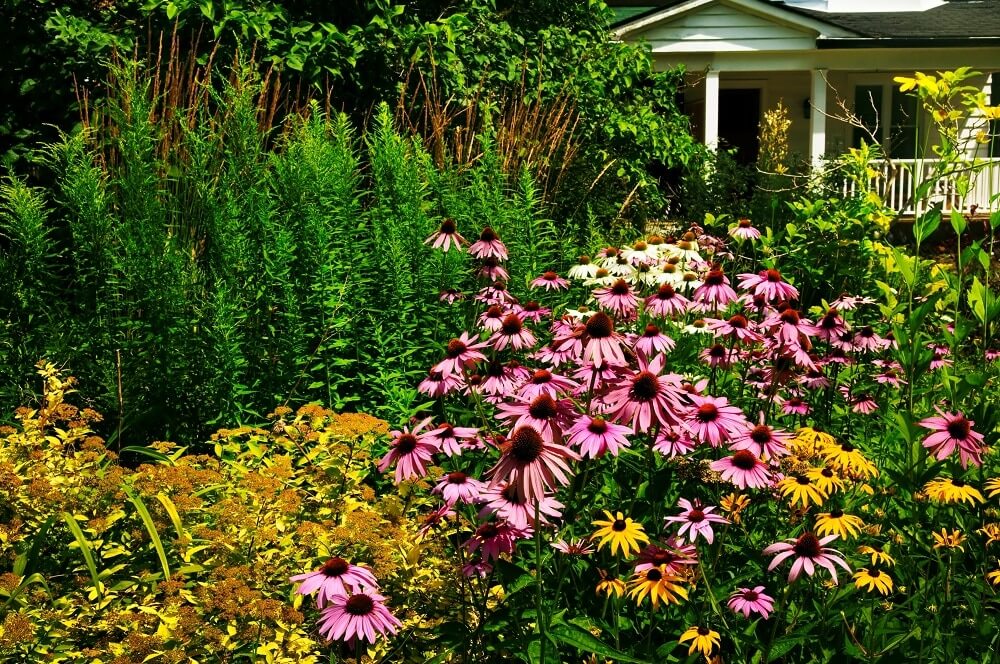
4. Marigold
Experienced gardeners have used marigold (Asterales) for companion planting, attracting beneficial insects, and nematode control. However, it has also played an essential role in North/South America and Mexico’s early medicines. Today, the primary use of Marigold is as a source of carotenoids, zeaxanthin, and lutein, for supporting healthy vision. It can also be used as a topical application to support foot health. The extract can be found in ointments, oils, and tinctures.
5. Red Mulberry
Red mulberries (Morus rubra) have many uses, such as jelly, pie, fruit, wine, tea, and other drinks types. Ripe fruit will be purplish. Consuming unripe fruit can cause stomach upset and hallucinations. From a medicinal point of view, the root bark is anthelmintic and cathartic. Used as a tea, it can help treat weakness, dysentery, reduce hay fever and panacea.

6. Spiderwort
The ‘wort’ portion of the spiderwort’s (Tradescantia) name is an old English term meaning having the knowledge of the various uses of a plant. You can put both the root and flower of this plant to use in herbal medicines. Native Americans used it to cure venomous spider bites with spiderwort. They also made it into an herbal drink for menstrual pain. However, many use it today as a laxative or to help treat kidney and stomach issues. For years, it has been used as a poultice by crushing the leaves to treat insect stings and bites.
7. St. John’s Wort
It is important to note that St. John’s wort (Hypericum perforatum) can react negatively with other medications, and therefore it is vital to research these interactions before taking the herb. The most common use for St. John’s wort is mood disorders and depression. It can also help to relieve the symptoms of menopause. The majority of people who take St. John’s wort will consume anywhere between 400 to 1200 mg each day. The product is typically purchased as a pill or as an oil.
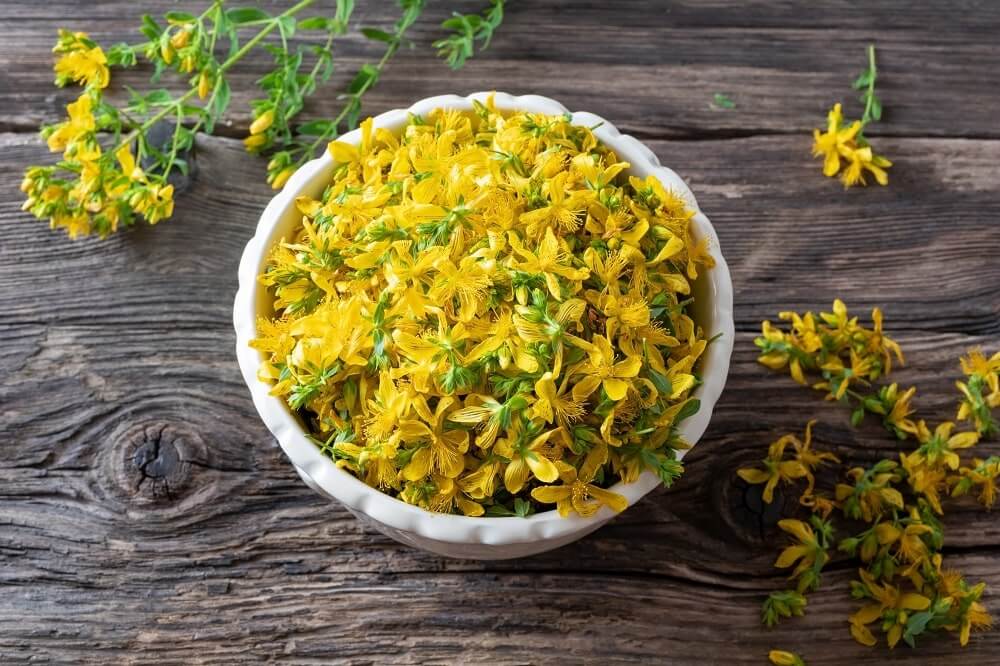
8. Skullcap
Skullcap (Scuttellaria incana) is a flowering plant from the mint family. Native Americans and Chinese have both used it as a traditional medicine to treat various ailments. Today, you can purchase skullcap in supplement form. The Chinese used the plant’s dried roots to treat insomnia, diarrhea, high blood pressure, dysentery, inflammation, and respiratory infections. Skullcap comes in powders, capsules, and liquid extracts.
9. Purple Coneflower
Purple coneflower, referred to as echinacea (Echinacea purpurea), is a gorgeous purplish flower. Some of these flower’s uses are making essential oils, herbal remedies, tea, and herbal supplements. The tea provides a tingling feeling that is both invigorating and refreshing. Many herbal tea manufacturers combine it with mint and lemongrass to offer a unique yet pleasant flavor that is smoother to drink

Purple coneflower is one of the best medicinal plants and offers a variety of excellent health benefits. It helps prevent infection, boost immunity, relieve pain, soothe respiratory ailments, and improve mood swings. The tea is easy to make by using a handful of purple cauliflower leaves, 10 ounces of water, and an optional sweetener, such as honey. It is a great product to have on hand during the cold season. This soothing beverage will help ease the uncomfortable feeling of a sore throat as the weather gets cold.
10. Yarrow
Last on our list of types of medicinal plants is yarrow. Yarrow (Achillea millefolium) is another plant that has been used as a traditional medicine for many centuries. It also has been commonly known as carpenter’s weed, Devil’s nettle, bloodwort, old man’s pepper, thousand-leaf, staunch weed, and woundwort. Some of the benefits of yarrow include reducing inflammation, wound healing, anxiety, digestive disorders, and neurological conditions. All of the above benefits have a rich history of medicinal use and are suggested through various scientific studies. Other possible uses include alleviating hay fever, supporting immune systems, regulating blood sugars, treating hemorrhoids, speeding up the elimination of urine, stimulating menstruation, and helping with sleep disorders.
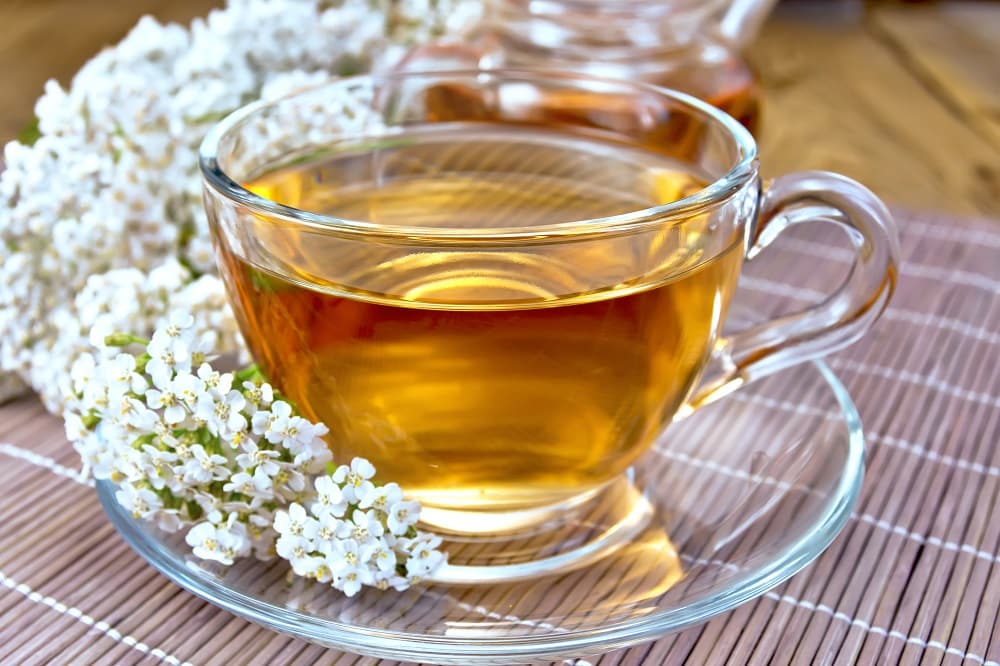
Last Thoughts on Medicinal Plants to Grow in Your Garden
Remember, you will not need a large plot of land or a green thumb to reap the benefits of growing fresh, medicinal herbs in your garden. Medicinal plants provide a wealth of benefits for your family’s garden while at the same time adding a rainbow of colors and alluring aromas. A medicinal herb garden can be grown anywhere, including a kitchen window box, pots on the patio, or a small backyard garden plot. Down to Earth Services is here to help with all of your plant and gardening questions and projects.
A Guide to Missouri Native Flowers
If you are from the state of Missouri or currently live in Missouri, you are more than likely aware of the many beautiful flowers that surround you throughout the year. Missouri is rich in gorgeous landscapes that sweep across the state with flowers blooming throughout the different seasons. Vibrantly colored flowers bloom in progression across all 4 seasons in this beautiful state and include a variety of winter plants that do well during the chilly months. Let’s go over the many different Missouri native flowers that you should be aware of if you live there, or if you are going to visit, and want to see one of the most beautiful aspects of the beloved state.
Different Types of Flowers in Missouri
The natural landscape is rich in its variety of beautiful Missouri native perennial flowers. And over the last ten years, native wildflowers have become a popular choice to use in Landscape design. Native flowers can enhance residential landscaping and add depth and a touch of wild beauty, and benefit wildlife in the area. If you are interested in adding native flowers to your landscape, having the right information on when you should plant them, what the best soil will be, how much sunlight they need, along with many other factors will help ensure a successful and thriving landscape. Once you have the basics down, it’s time to get planting! First, let’s look at some of the more common flowers you see around the neighborhood and then move to those that people regularly use for landscaping purposes.
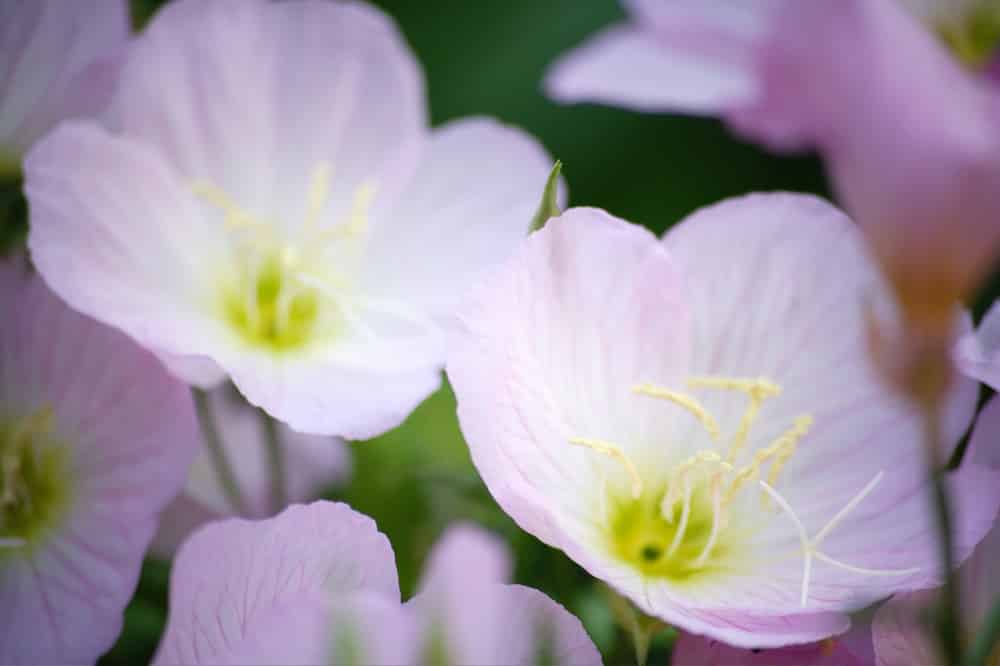
What Types of Flowers Grow Naturally in Missouri?
There are several flowers that you have likely seen growing naturally. Cliff Goldenrod (Solidago drummondii), blue sage (Salvia azurea), bluebells (Mertensia virginica), Primrose (Oenothera macrocarpa), and the Dwarf Crested Iris (Iris cristata) are all prime examples of native Missouri flowers. There are also other flowers, including the Blue Mistflower (Conoclinum coelestinum), Purple Poppy Mallow (Callirhoe involucrata), Star Tickseed (Coreopsis pubescens), Rose verbena (Glandularia canadensis), and the Dense blazing star (Liatris spicata). Each of these Missouri native plants will have slightly different requirements if you want to see them bloom to their maximum potential. It is necessary to understand this basic information if you want your wildflowers to survive, especially during the seasons where they are the most plentiful.
Popular Wildflowers Native to Missouri
New England Asters
Later in the year, from August through October, the New England Aster (Symphyotrichum-novae-angliae) is probably the most noticeable of the Missouri wildflowers. If you are going hiking, and you happen to walk by a stream, you will likely see hundreds of New England Aster growing nearby. These uniquely beautiful flowers provide a particular type of nectar that traveling monarch butterflies highly covet. New England Asters also need an extreme amount of sunlight, a minimal amount of shade, and require moist soil.
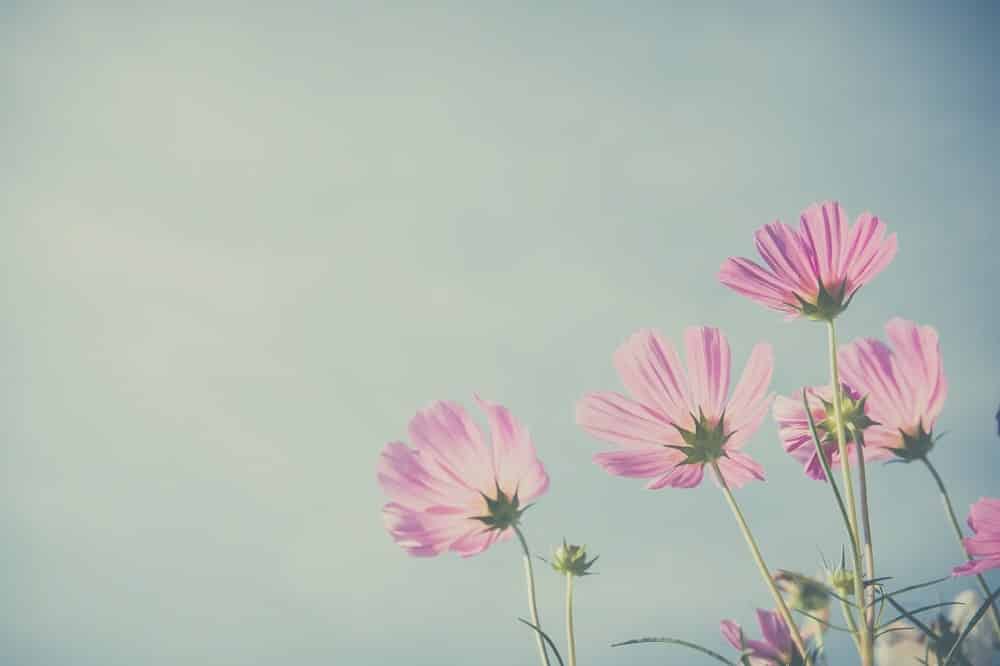
Smooth Beardtongue
One of the most prolific wildflowers you will typically see from May through July is the Smooth Beardtongue (Penstemon digitalis). It is very noticeable, primarily because of its color and shape. The clusters of Smooth Beardtongue are white flowers and shaped like a beard and tongue. You can see these beautiful flowers in nature in the woodlands, but you will likely see them driving down a road or interstate highway. The maximum height of Smooth Beardtongue can reach 4 feet, and they need plenty of sunlight, partial shade, and moist soil to thrive.
Rose Verbena
This beauty blooms from May to August and provides a spectacular spray of color to any hilly area, rock garden, or wildflower garden. Rose verbena (Glandularia canadensis) is a Missouri native perennial that does well in sunny conditions and grows best in dry to medium soil. The tiny flat blooms grow from 6 to 18 inches tall, and range in color from a rose pink to a rose-purple. It is a plant that spreads very quickly and creates a beautiful ground cover.
A Few More Missouri Wildflowers
As you head into October, several types of flowers will be even more prevalent, including Purple Coneflower (Echinacea purpurea), Columbine (Aquilegia canadensis), and the distinctive Cardinal flower (Lobelia cardinalis). These flowers are very commonplace along the streams of the Ozarks, attracting butterflies and hummingbirds.
The variety of vibrant colors and unique textures of wildflowers are an excellent addition to any flower garden or planted landscape area around your home. And with proper care, your wildflowers will provide beautiful foliage and blooms for years to come. If you are wondering which flowers will be the most ideal for your home in Missouri, keep reading for some of our favorites.
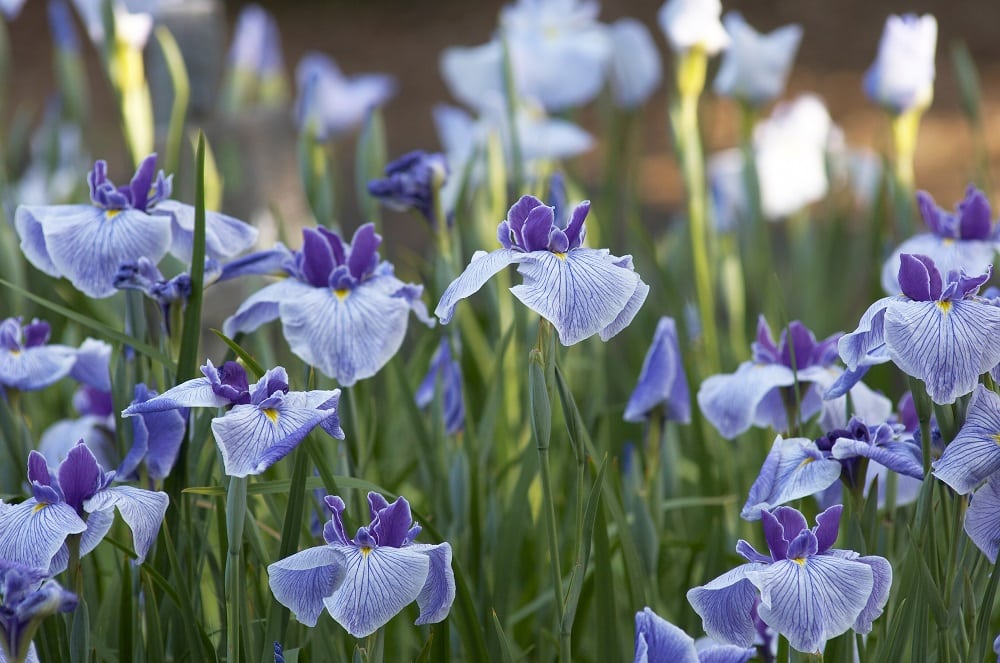
Best Flowers for Landscaping in Missouri
Down to Earth Services are your native plant experts, and below we will dive into some of the best native flowers for landscaping. First, to maximize the life of your flower’s you need to choose the position of the flowers and the time of year to plant them. Whether you are planting in a garden bed or putting the flowers in pots around your home, it is vital to educate yourself about the native flowers you are growing.
For blooms from July through October, the Prairie Blazingstar (Liatris pycnostachya) is an excellent choice. This flower has a tall distinctive appearance and grows spikes with fluffy flower heads. Another common name for this flower is button snakeroot. This unique flower is excellent for borders and makes lovely cutting flowers. It is important to note that this particular flower is very tall, growing anywhere from 2 to 4 feet in height, so placement is imperative.
If you are going to plant in April or May, and you would like your flowers to last several months, the Grayhead coneflower (Ratibida Pinnata) might be your best choice. This beauty blooms from June to August and is certainly a contrast with the Prairie Blazingstar in color and its overall appearance. These can also reach extreme heights, going from 3 feet up to 5 feet. A good placement for this flower would be as a border or on the side of your home that gets the most sunlight. Because of the height, it may be necessary to add staking for added support.
On the other hand, if you are planting later in the year, the Butterfly Milkweed (Asclepias tuberosa) might be a great choice if you have a flower garden that is out in the open. This vibrant wildflower will also produce nectar that will attract butterflies when they are traveling through the area. Be sure to adequately drain the soil to ensure the best outcome for this perennial.

Choosing the Right Missouri Native Flowers for Your Landscaping
Choosing the right flowers for your landscaping can be overwhelming. Down to Earth Services is the team to talk to if you’re feeling out of your element. Depending upon the type of climate you have annually, your elevation, and the kind of weather you typically have, professionals like the Native Plant Experts at Down to Earth Services will know which flowers to pick. Not only can we determine what would look best regarding the color and positioning of your home, but we can also choose Missouri wildflowers based upon where you want to have them planted. Combining many of these flowers can often create a magical garden of flowers that will grow at similar times and cascading times to develop an assortment of lasting blooms.
Whether you decide to plant Prairie Blazingstar, garden phlox, or the Grayhead coneflower, you can rest assured that they will provide a beautiful transition of color in your landscape. Knowing the type of soil to use, the time of year they will flourish, and how often to water are essential factors when planting Missouri native perennial flowers. The amount of sun that they need and the proper position around your home can also contribute to how long the flowers will live. From the crested iris to the beautiful bluebells that are so prolific throughout Missouri, contact Down to Earth Services to help you choose and plant the best Missouri native flowers for your landscape.
A Guide to Xeriscape Landscaping
There is a unique type of gardening that does not require the use of extensive amounts of water. It is called xeriscaping. It is done by using different types of vegetation that will not use an overabundance of water to keep the plants alive. This type of landscaping is advantageous in areas where rain is at a minimum, especially year-round, yet people still want to have a beautiful landscape surrounding them. Here is a quick guide to xeriscape landscaping and how you can benefit from this unique way of developing drought-tolerant landscapes using plants native to your area.
An Overview of Xeriscaping
If you live in a region of the world that is extremely dry, trying to plant vegetation outside of your home can be problematic. It may also be difficult if you need to use some form of irrigation, especially if you are in a region that does not have good aquifers. Therefore, many savvy people developed what is called xeriscaping. It is an alternative to what many people call traditional gardening. Instead of using plants that require water daily, these plants can maintain their luster, and continue to grow, despite the absence of water.
What Are the Advantages to Xeriscaping?
From a practical perspective, if you do live in an area where water is infrequently provided in the form of precipitation, this is an ideal way to create a garden-like area. You can also reduce water consumption which may be necessary for your particular community, especially if you are experiencing drought-like conditions. These plants also require very little maintenance. Although they can take advantage of rainfall, it is not necessary, especially if you have done proper soil grading and mulching to preserve the available water. A reduction in overall maintenance costs, as well as reducing the amount of organic waste that you produce, are all benefits to this type of landscaping.
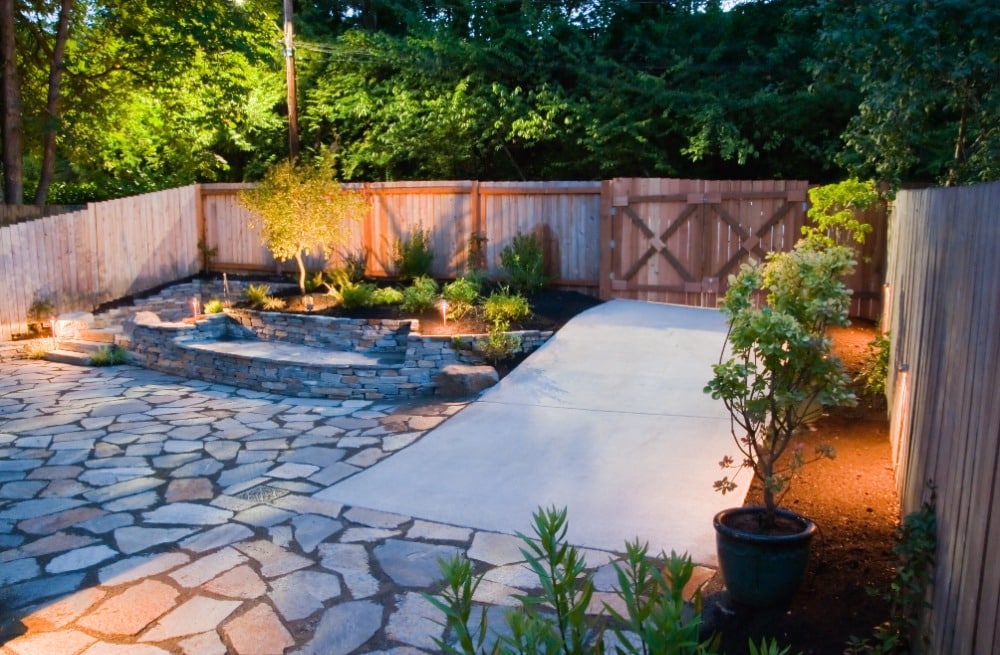
Principals Surrounding Xeriscaping
There are several xeriscape design principles that you must follow if you choose to create this type of garden. These are simply guidelines that many people used to create the most effective appearance. The plan and design are typically done on a diagram, incorporating the plants with your sidewalk, driveway, patio, deck, and also your house. There are certain types of soil amendments that must be made as well. You need to use soil that can retain water, and also use effective and efficient irrigation strategies. For example, if you are going to minimize the amount of water that you use each year, you must plant these in areas that will maximize the availability of water for flowers, shrubs, trees, and also groundcover plants that you may be using.
Why Xeriscaping is Best In Certain Regions
Aside from the probability of a drought occurring, to prepare for a drought, water consumption must be kept to a minimum. There are certain areas of the world where this is necessary. Additionally, drought-resistant plants can replace the use of standard green lawns that so many people have today which require an excessive amount of water, and maintenance to maintain their pristine appearance. Finally, if you are planting anything, and rainfall is scarce, using foliage that requires little water can help to maximize your investment in the plants that you purchase. Instead of worrying that they will not have enough water, this is a concern that no longer exists when you are doing xeriscape landscaping instead.
How to Create a Xeriscape
There are several considerations that you need to make before starting. First of all, you need to choose the plants that you are going to use very carefully. Always choose plants that are designed for high drought tolerance. However, the plants you choose should also be appealing and contribute to your landscaping efforts. It’s also important to prepare the soil that you are going to use, preferably adding as much organic matter as possible in the form of compost. A layer of mulch over the top of the soil can help retain moisture, and you must be prepared to water as efficiently as possible.
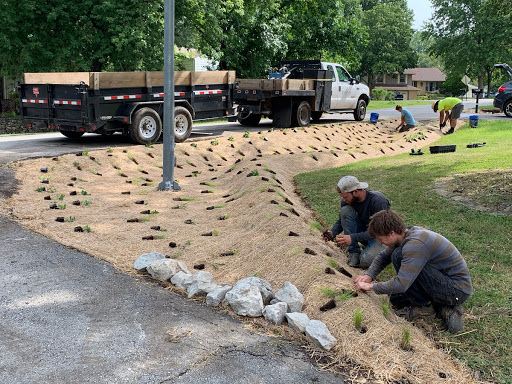
What Type of Plants Do You Use in Xeriscape Landscaping?
There are several popular types of plants that you can use in a xeriscape, all of which will do very well in an arid climate. This includes the following plants, which are perfect for xeriscape landscaping, plus they are also very colorful.

Can You Incorporate Regular Plants with Xeriscape Landscaping
It is not recommended that you use standard plants with xeriscape landscaping because of watering requirements. However, if the plants you select have a high tolerance for heat and need only small amounts of water, they will be perfect for your xeriscape garden. If you select flowers and other plants that need more water, you may want to incorporate them in a specific area, where you can manage the amount of water that is used. Doing this will allow you to segment these plants, and care for them according to their requirements without having to worry about overwatering any of the other plants in your landscape.
Is Xeriscape Landscaping Ideal for Everyone?
Xeriscaping can be ideal in certain situations. However, if you happen to be in a tropical climate, these plants are simply not going to do very well. It is important to consider the climate you are in, the amount of rainfall that you receive, and the temperatures that are most common in your region. In certain circumstances, in moderate climates, you may be able to combine the many different types of plants from regular flower gardens and xeriscape landscaping flora. However, if the conditions are extreme with heavy downpours, and extremely cold temperatures, xeriscape landscaping may not be ideal.
If you are concerned about the amount of water that you are using regularly for your flower garden, consider xeriscape landscaping instead. You can create very colorful layouts, that are quite easy to manage, and you will not have to be concerned about watering them as much. In time, you will become adept at adding new plants that can be used with this type of landscaping which is becoming extremely popular.

At Down to Earth Services, we are passionate about native landscape design! It is our goal to solve issues in nature with ecological landscape solutions that are both beautiful and functional. For information on how we can help with your landscaping project or to purchase plants that are beautifully native to your area, Contact Us Today!
Top 10 Best Plants for A Wildlife Garden
If you have space and the inclination, creating a wildlife garden can be a wonderful addition to your outdoor space. And while many of the homes in your area may have a more modern look to their landscaping, the beauty of a natural and wild garden can be just as beautiful and appealing to the neighborhood. A wildlife garden includes the beauty of plants, with the benefit of attracting all shapes and sizes of nature’s creatures. Keep reading to learn about the necessary elements of a wildlife garden, 10 great plants for wildlife, and how to keep unwanted wildlife out.
Creating A Wildlife Garden
The process of creating a wildlife garden doesn’t require tearing up your whole yard. In fact, you can do it on an apartment balcony if you choose to. While more space is great, in that it attracts more diversity, you can create a beautiful garden that attracts wildlife in any setting. A good wildlife garden features four things that wildlife wants and needs food, water, shelter, and nesting.
- Food: At least one bird feeder is a must. Red is a great color for both flowers and feeders if you want hummingbirds. Research squirrel-proof feeders as well as what your local birds like to snack on.
- Nesting: If you want to invite surrounding birds, give them some bird boxes. Choose your spacing though, as many nesting birds get territorial, although martins are an exception.
- Shelter: Grasses, shrubs, trees, and many other tall plants are useful in protecting from predators. They do more than that though, grasses, shrubs, and trees also provide safe resting places, cooling shade, and cover from the weather. If you can, mix up deciduous and evergreen plants alike.
- Water: Everything needs water for survival, and a clean water source is a great way to make sure thirsty wildlife visits your garden. Several different water sources or features might give different categories and sizes of wildlife safe spaces to segregate.
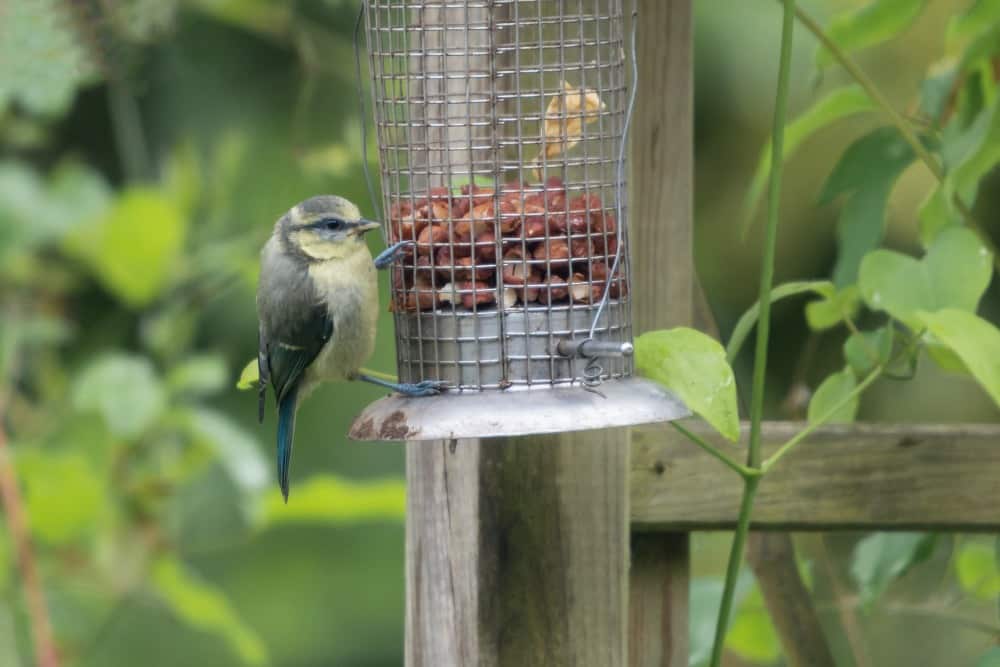
10 Plants to Consider for Your Wildlife Garden
Most plants attract some kind of wildlife. Even the lonely desert cactus attracts thirsty animals, otherwise, it wouldn’t have needles. Still, you have a lot of influence over who shows up. The following plants bring beautiful wildlife to your yard but also prove to be downright gorgeous in their own right:
- Aster: This huge family supports 112 species across woodlands, roadsides, pasture, meadow, and prairie. These species bloom in both spring and fall, depending on the ones you choose, especially if you get truly native species that support bees and butterflies.
- Goldenrod: There are 125 species of Goldenrod across the continent, and they support almost as many species themselves. These predominantly include birds, spiders, and insects. This is a great fall flower.

- Geraniums: Support 23 species with native variants. These aren’t the hanging baskets you get at the grocery store.
- Joe Pye: 42 species find support for this great native alternative to the invasive Butterfly Bush. Snakeroot and Boneset are two of many Joe Pye species that offer lots of pollen and nectar to wildlife that want to call your garden home.
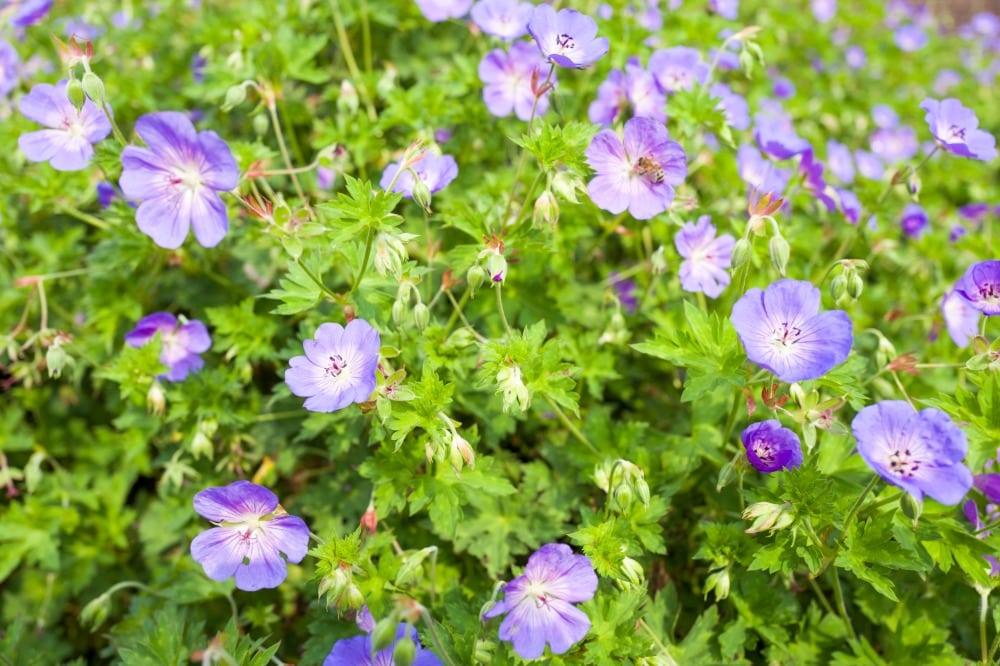
- Honeysuckle: This can support up to 36 species if you plant the right ones. Japanese Honeysuckle is NOT one of them! We recommend not planting this species. Choose a species of honeysuckle that is native to your region if you want butterflies and hummingbirds around.
- Lupine: This family of flowers supports up to 33 different species. The Karner Blue and other endangered butterfly species are very reliant on this particular plant family. As with any flower, it’s a good idea to consult your local native plant specialist to figure out the right species for where you live.

- Morning Glory: This family supports 39 species, but you need to take care. There are some very invasive variants, so be sure to choose a species that is native to the region you live in.
- Sedges: 36 species find support from this potentially endangered species. By planting sedges, you are helping to protect this species while also providing for wildlife species that visit your garden. Sedges work very well in grassland, woodlands, and prairie landscapes.
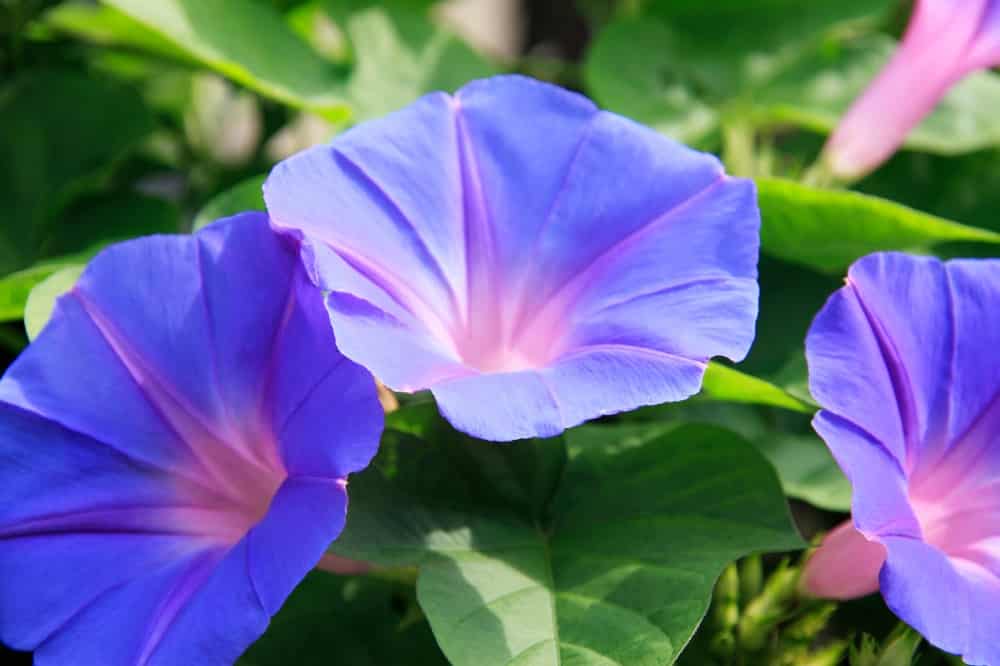
- Sunflowers: These support 73 species. Try combining annuals with perennials to provide nectar and pollen to as much wildlife as you can.
- Violets: 29 species use these as a source for nourishment and life. Fritillaries, often endangered, are butterflies that use them as host plants. Violets are great for early spring color and some starter wildlife habitat.

Keeping Unwanted Wildlife Out of Your Garden
When you create your wildlife garden, the first things that come to mind are the beauty of the landscape and all of the beautiful animals that will hopefully visit from time to time. The thing we don’t necessarily think about is the wildlife that we want to discourage from visiting.
It’s a good idea to keep in mind the animals you don’t want that can wreak havoc in your garden. This includes animals such as squirrels, although cute, they can be annoying. However, you can mitigate a squirrel issue by providing them with their own feeder so that they do not scare away the birds visiting your native wildlife garden.
Additional wildlife that you will want to avoid include skunks, rodents, raccoons, and possibly rabbits and deer. Keeping your garden tidy and free of enticing morsels for unwanted creatures is a great way to start. Be sure to get rid of any left-over fruit and other food items that you have left out each night and consider trays for your bird feeders so that stray seeds do not accumulate on the ground. These simple suggestions can help keep the visiting wildlife safe from becoming dinner for unwanted critters.
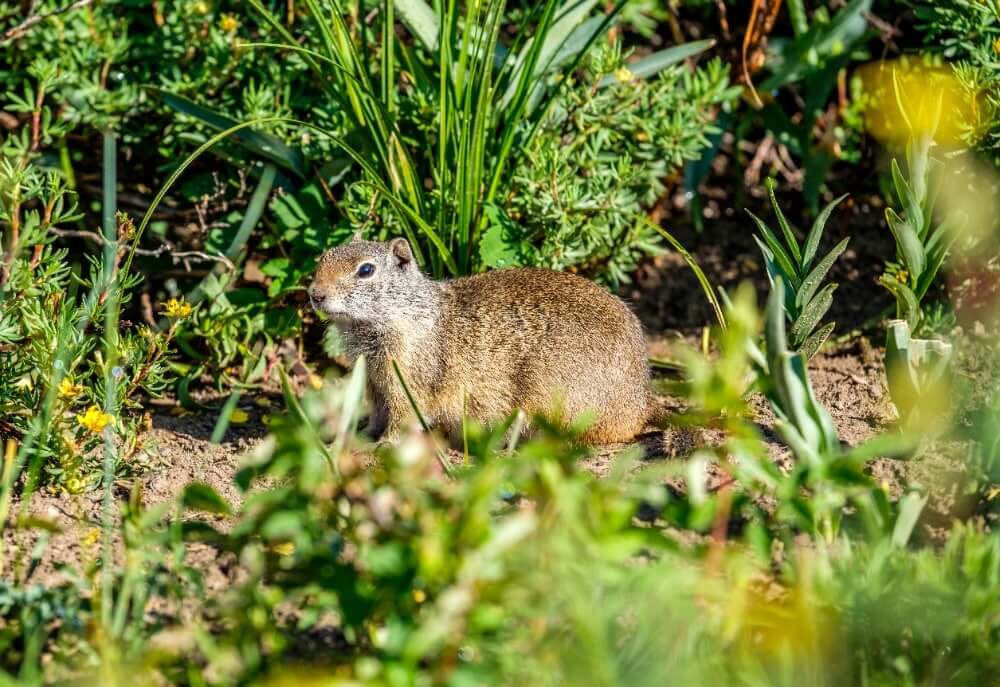
Here are a few ways to deter wildlife you don’t want to see regularly:
Dog Hair: If you have a pup, or can borrow dog hair from a friend, put it around the flowerbeds and herbs. The sheer scent of it keeps most wild animals out that don’t like being near humans or their dogs.
Fencing: The best solution here is fencing surrounding the garden. The height will keep out a lot of creatures, but it also has to be deep enough to keep burrowers out. You might be told by others that deer can jump nearly any fence, and while that’s usually physically true, they don’t typically jump over anything that they can’t see over.
Raised Beds: If you’re just worried about small animals, then raised garden beds fortified with mesh lining on the bottom and short fencing on top provides tiny plants lots of protection. Birds, bees, and butterflies can still get in though.
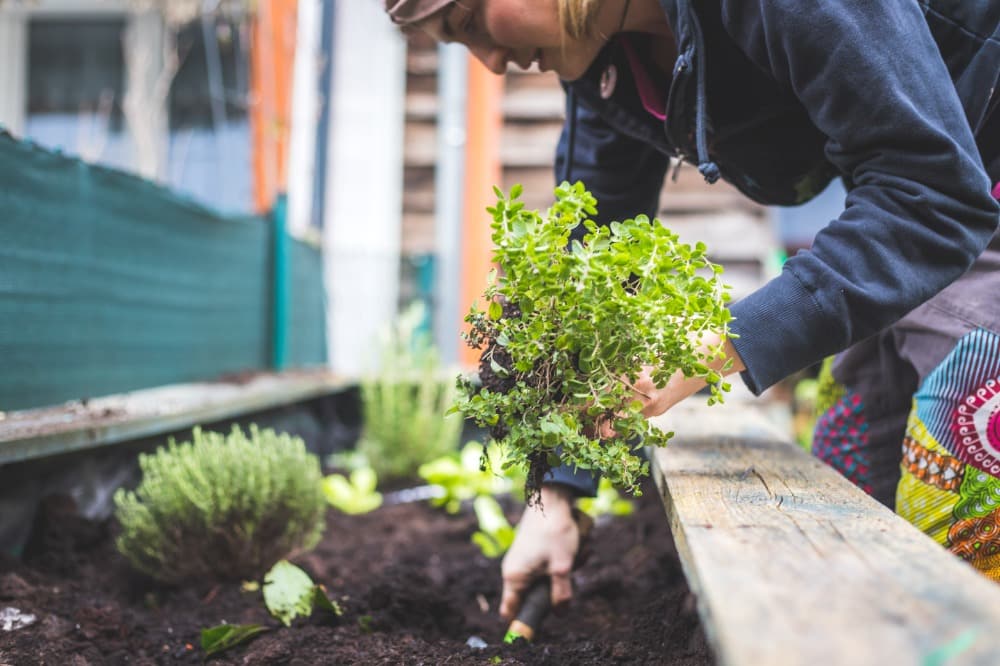
Relax and Enjoy Nature’s Beauty
Creating and maintaining a wildlife garden can be extremely rewarding! And if you are like us, the satisfaction of creating a beautiful natural landscape that helps to support wild creatures is one of the best feelings in the world! Once your garden is in place, it’s time to sit back and enjoy the beauty and safe haven you created. There’s nothing better than early morning coffee on the patio and watching the wildlife in the garden thrive.
If you love the idea of a native landscape full of beautiful plants and wildlife but aren’t quite sure about creating or maintaining it yourself, we can help! At Down to Earth Services, we specialize in creating beautiful and eco-friendly native landscapes. We do everything from design and installation to landscape management. For more information on our services or if you need plants to create your wildlife garden, Contact Down to Earth Services!
Winter Plants That Thrive in Your Native Landscape
In Missouri and across different areas of the world, many people dread the winter months. However, winter is a season that has its own unique beauty. For starters, when else do you get to enjoy the beauty of snow covering the landscape like a soft white blanket? And while many attribute winter to death, to us it is a season of slumber preparing for rebirth in the spring. Although many plants die in the winter, some thrive. By adding winter plants to the landscape of your property, not only will you be accentuating the sometimes-overlooked beauty that comes with the season, but you will also be providing food and shelter to birds and other animals.
Remember that not many plants thrive and flower during the wintertime which means food for birds and other animals is usually in shortage. Winter plants can help to provide sustenance to wildlife that visits your property. In this article, the discussion will focus on the top plants native to Missouri that you can grow to improve your landscape aesthetics this winter. Before we highlight these ‘winter champions’ though, it is important to point out that no matter the season you choose to plant any kind of plants, you must take proper care of them if they are to thrive in their natural environment. For that reason, we will first look at the best ways to take care of your plants during the winter months.
A Simple Guide on Caring for Your Winter Plants
Plants, trees, and shrubs can be planted in the winter months as long as the ground is workable. It is however advisable to finish planting at least 6 weeks before a heavy freeze so that they have an opportunity to establish a good root system.
- If you are planting trees or plants during the winter, first loosen the soil, remove any plastic covers which may have been around your trees while they were in the nursery then plant your trees making sure that only the roots are covered by the soil.
- Before the snow freezes the ground around the plant, ensure that you provide enough water to the plant. Ensure that the water makes the soil moist, but not soggy around the base of the plant.
- Adding mulch around the base of the plant provides added protection. However, be sure the mulch does not touch the plant. Instead, leave some space around the plant to keep off pests such as aphids. For trees that thrive in the winter, you can wait until the ground has started freezing to start mulching.
- During this period, your plants will need all their strength to survive. For this reason, ensure that you remove unhealthy and dead plant parts.
- If you have overgrown plants that flower and thrive during this period such as roses, prune excess branches but ensure that you do this sparingly.
- Right before and after winter starts setting in, ensure that you regularly check for an infestation of pests and parasites. Should you notice an infestation starting to set in, take the appropriate steps to get rid of them so that your plants have the best chance for survival.
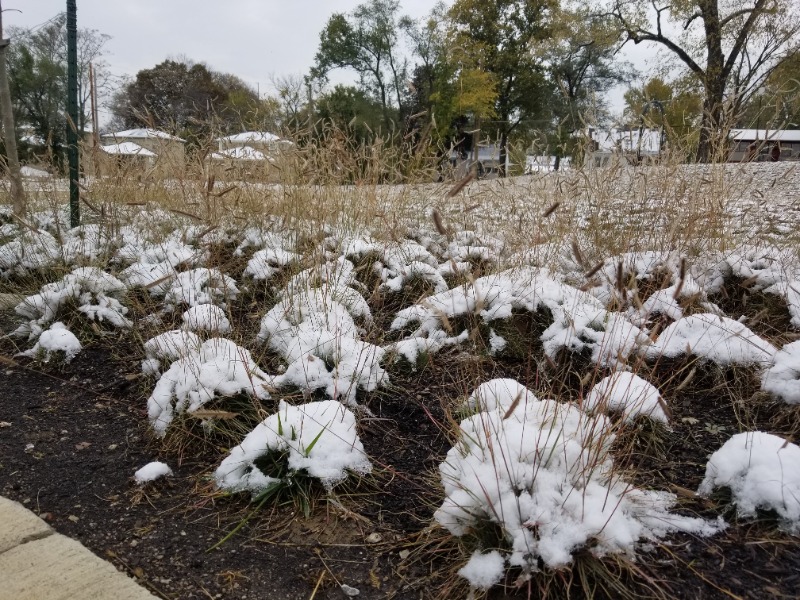
Keeping the above tips in mind, we can now look at some winter plants that thrive in Missouri and how to take proper care of them.
Plants Native to Missouri That Thrive in The Winter
Although nature seems to be on vacation in the winter, some winter plants thrive in the cold weather. Some of these hardy plants yield berries or flowers, despite the freezing conditions. What a wonderful treat to have vibrant splashes of colorful flowers and greenery in the dead of winter. Below we have listed six of these hardy all-stars.
1. Common Witch Hazel (Hamamelis virginica)
Common Witch Hazel has uniquely beautiful flowers that are pale to bright yellow, and on the rare side have an orange to reddish tint. They have ribbon-shaped petals that bloom from mid to late fall. Common Witch Hazel can grow up to 20 to 30 feet high and 15 to 20 feet wide. It can also be trimmed to grow as a tree or a shrub and is recommended to plant in semi-shaded areas when used in home landscaping.
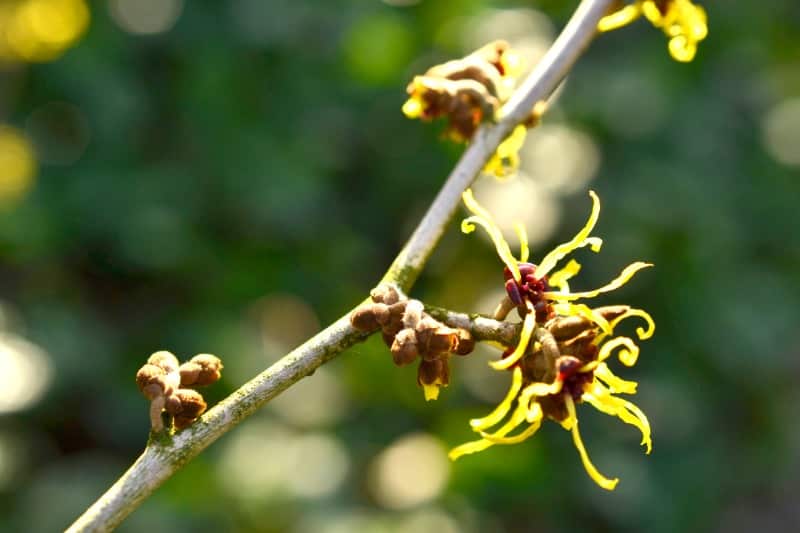
2. Prairie Onion (Allium stellatum)
The Prairie Onion is a species of wild onion that is related to the Lilly family. This beautiful plant is very tenacious and can survive in very harsh weather. The bulbs of this plant are edible, and they produce lovely pale pink to purple blooms. This plant provides both beauty and sustenance.

3. American Beauty Berry (Callicarpa americana)
The American Beauty is an open habitat shrub that is native to the southern United States. This beauty is oftentimes grown as ornamental in yards and gardens. It produces large clusters of berries that are purple and provides food to wildlife such as deer and birds. The berries of the American Beauty Berry can be consumed, in small quantities, by humans. The berries are most often used in wines and jellies, and the roots of this beautiful plant are used in herbal teas. As you can imagine, it makes for an exceptionally beautiful and unique addition to a landscape.

4. Hawthorn (Crataegus viridis)
This plant thrives throughout the year with green and glossy leaves throughout all seasons. The Hawthorn sprouts white flowers in the early summer before producing beautiful berries that can either be gold, red, or orange in the winter. Though it has thorns, the beauty of this plant makes it ideal for landscaping as well as making decorative wreaths for the holiday season.

5. Winterberry (Ilex verticillata)
This plant can grow into a unique pyramid shape, conical or columnar shape. When blooming, Winterberry usually produces white flowers and during the winter produces berries that are red, white, orange, pink, or blue. What’s more, this plant has a unique history as the early Romans thought that it could be used to keep evil at bay.

6. Eastern Wahoo (Euonymus atropurpureus)
The Eastern Wahoo grows uniquely because, in the early fall, it produces red capsules that look like earrings which eventually open up and produce beautiful scarlet fruits. This plant makes for an aesthetic addition to the landscape and the best part is that can survive through harsh weather whether it is sunny or wet.
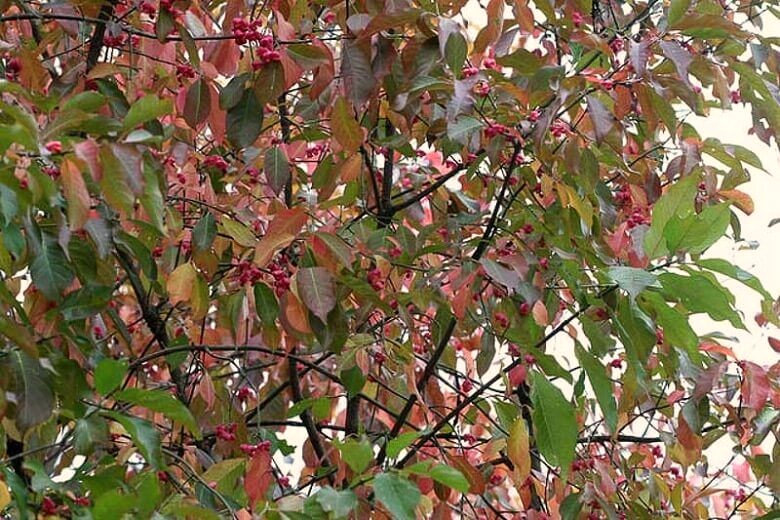
Welcoming the Winter tide with Winter Plants
While winter may seem to be the end of your lush green and flowering landscape, as you can see, that is not entirely the case. Adding winter plants to your landscape, that are suited for the area you live, can provide a rewarding show of greenery, colorful blooms, and vibrant berries. If you aren’t quite sure or confident in creating your winter landscape, Down to Earth Services is here to help. We are native plant specialists, and we thrive on designing and creating beautiful native landscapes that will provide beauty for years to come. For more information on our services, or how to get started, give us a call at 816-207-7960 or contact us online!
Things to Consider When Designing A Native Plant Garden
Native Plant Gardens are often considered wild, and messy with grasses dominating the landscape and wildflowers bursting through sporadically. The question is, how do you tame the wild but keep the beautiful prairie? Can it be done? At Down to Earth Services, we believe that you can have a visually stunning native ecosystem with the proper design for your native plant garden.
After all, there is nothing worse than designing a new garden and realizing it doesn’t look the part or doesn’t grow the way you want it to. This happens all the time for those who have never set up a new native plant garden.
Fundamentals for Your Native Plant Garden Design
It’s time to learn how to design a native plant garden so it grows well. Here are six of the most important tips a gardener can follow for their setup.
1) Matching Plants to Your Location
Start with the basics, which means choosing the right plants for the site you will be planting in.
Take a look at the landscape to get the lay of the land. Is the area you are planting sunny or shaded? What type of soil are you working with? After you take a look at these three things, choose plants that will thrive in the climate that you are working with. If the area is sunny, be sure to choose plants for your native plant garden that love the sun. These plants generally need at least 6 hours of sun to grow their best. If the area is shady, choose native plants that love the shade.
A beautifully designed native plant garden starts with the right plants for the climate. For a maintenance-free landscape, be sure to select plants that grow in the same climate. This is one of the most important things when designing a thriving native garden. Choosing the right plants will determine if your garden flourishes with low maintenance or requires more effort than you expected. Planting the wrong plants for your climate will not work.

2) Designing for Succession Blooming
Most blooms do not last all year long, so it is important to choose your perennial plants based on the succession of blooms. Select plants that bloom in the spring, summer, and fall. By doing this, you will have a diverse garden with wildflowers coming into bloom while others are going out of bloom throughout the seasons. You will want to be sure that you are designing your garden with bloom cycles in mind.
You will want to have a good idea of how your native plants look in different seasons to determine the best placement for each plant. You want to have your plants grouped in a way that they bloom seamlessly and add beauty to your garden. For added movement, structure, and texture be sure to include different types of grasses. Big Bluestem or “turkey-foot grass” creates a beautiful background or border for perennials and is a stunning bronze color in the fall and into the winter. If you choose Big Bluestem, be sure to plant it sparingly so that it does not overtake your blooms.
3) Grouping Similar Plants Together
While it can be fun to let our artistic side flow when designing your garden, don’t let it completely take over. There are many practical reasons to group certain plants or flowers. For the best possible results in your native plant garden, group plants that have the same or similar requirements for sunlight, soil, and water. This will make it much easier to maintain your native garden.
For aesthetics, be sure to use different textures in your native plant garden. While blooming plants may provide a mesmerizing sea of color, contrasting textures and forms will add a unique element of beauty and contrast.
4) Plant Height
Have you thought about the height of the plants? This is a common mistake many beginners make. Be sure to choose plants that will not grow taller than half the width of the bed.

5) Designing the Contour of Your Native Plant Garden
When designing your native plant garden, the goal should be a naturalistic design. By imitating what you see in specific landscapes in your community such as a prairie, or wetland, you can get an idea of what plants might grow well in the area you are planting in. You will also be able to see what plants grow well together. Something that many people overlook is plant size and the sequence in which they bloom. Understanding what works well and where each plant should be placed will help you develop a beautiful and healthy ecosystem. We suggest researching and learning about what native plants are the most dominant in your area to help decide which plants to choose as well.
6) Weed Control
Weed control and maintenance of your native garden will require some initial dedication. The most critical time for weeding is two weeks after planting. Keep in mind that this is dependent on the season as well so if you are planting in warmer or dry seasons it could be longer. Once your native landscape is established it should need only minimal maintenance.
Be sure to research which plants need to be pruned, how often, and when, as well as making sure that you are weeding out any undesirable plants or plants that start to overtake your space.
Final Thoughts
Designing a native plant garden can be challenging, however, your design does not have to be elaborate. Consider limiting the number of different plants to 10 to 15 different species. The secret to a beautiful and eco-friendly native plant garden is all about design, preparation, and planting based on the conditions of your space. If you are willing to put in the time during the design phase, your result will be a native garden that is uniquely beautiful to your space.

At Down to Earth Services, we are native plant and landscaping specialists dedicated to the preservation and restoration of native plant communities. We focus on the creation of regenerative and ecological landscapes with the mindset of solving problems and balancing design with nature’s intent for both function and beauty
If you need help designing, installing, or managing your native landscape, contact Down to Earth Services to schedule an appointment. We look forward to hearing from you and in the meantime, we hope you continue to “Grow With Nature”!


